9 Types of Boat Hull Designs and Their Advantages
Imagine gliding through the crystal-clear waters, the gentle breeze kissing your face as your boat slices through the waves effortlessly. While the allure of the open sea is undeniable, what often goes unnoticed is the intricate dance between water and hull that makes this experience possible. Boat hull designs, the unsung heroes of maritime engineering, play a pivotal role in shaping a boat’s performance, handling, stability, and overall characteristics. Whether you’re an avid sailor, a leisurely cruiser, a competitive racer, or a dedicated angler, the type of hull beneath your vessel can make all the difference in your aquatic adventures.
Just as each sailor has their unique voyage, every body of water has its own temperament. The marriage between hull design and boating needs is a testament to the versatility of maritime engineering. From tranquil lakes and meandering rivers to tumultuous oceans and challenging bays, different conditions necessitate distinct hull designs. A flat-bottomed hull might offer stability and shallow-water access for a peaceful day on a calm lake, while a deep-V hull could provide the agility and seaworthiness required to navigate through unpredictable ocean swells. As the water varies, so do the demands on the boat’s performance, and it’s the hull’s responsibility to rise to the occasion.
In this comprehensive guide, we embark on a journey through the fascinating world of boat hull designs. We’ll navigate the intricate waters of hull anatomy, exploring the nuances of design that distinguish one type from another. Whether you’re a seasoned sailor or a novice boater, this guide aims to provide you with a deep understanding of the various types of boat hull designs and the unique advantages they offer. So, whether you’re seeking the thrill of high-speed racing, the tranquility of leisurely cruising, the art of angling, or the adventure of exploration, your choice of hull design can be your most steadfast companion on the water, shaping your experience in ways you might never have imagined.

The Role of Boat Hull Designs
At the heart of every boat’s performance and characteristics lies its hull design—an engineering masterpiece that defines how the vessel interacts with its aquatic environment. The hull is not merely the shell that holds the boat together; it is a dynamic and intricate component that significantly influences various aspects of boating. From stability to speed, maneuverability to efficiency, the hull design serves as the cornerstone upon which a boat’s capabilities are built.
Stability is perhaps one of the most fundamental attributes affected by hull design. The shape and dimensions of the hull determine how the boat sits in the water, its resistance to rolling, and its ability to maintain an even keel. A wider, flat-bottomed hull offers greater initial stability, making it well-suited for activities such as fishing or leisurely cruising. On the other hand, a narrower hull with a deep-V shape might sacrifice some initial stability in favor of better handling in rough waters and higher speeds.
Speed, a quintessential aspect of boating pleasure, is another realm where hull design takes center stage. The interaction between the hull and water directly impacts how efficiently the boat moves through its medium. A sleek, streamlined hull can reduce drag and enhance hydrodynamics, allowing the boat to achieve higher speeds with less effort. Racing vessels often feature hulls with minimal surface contact, optimizing for speed and agility. Conversely, a displacement hull, designed for displacement-style cruising, is engineered to glide efficiently through the water at lower speeds, making it perfect for long-distance journeys.
Maneuverability, closely intertwined with both stability and speed, hinges on the boat’s hull shape. A hull’s responsiveness to steering inputs, its ability to carve sharp turns or navigate confined spaces, and its resistance to skidding are all influenced by its design. A planing hull, characterized by a flatter shape, can rise up and skim the water’s surface at higher speeds, enhancing maneuverability and responsiveness. In contrast, a hull with a rounded shape might prioritize stability over nimbleness, making it a better fit for leisurely cruising.
Efficiency is a goal that transcends mere performance, impacting the boat owner’s wallet and environmental footprint. The right hull design can significantly affect fuel consumption and overall energy efficiency. A well-designed hull minimizes drag, reducing the amount of power needed to propel the boat forward. This translates to cost savings and a reduced impact on the environment.
Choosing the right hull design is not just an exercise in aesthetics or engineering prowess; it’s a critical decision that directly influences the quality of your boating experiences. Whether you’re seeking the thrill of high-speed runs, the peaceful tranquility of a calm lake, or the efficiency of long-haul cruising, understanding the intricacies of hull design is essential. By aligning your boating aspirations with the right hull design, you can unlock the full potential of your vessel and create memorable adventures on the water.
1. Flat Bottom Hull
A flat bottom hull design refers to a type of boat or watercraft hull that has a relatively flat, wide base with minimal curvature or V-shape. Unlike other hull shapes that have pronounced keels or V-shaped bottoms, a flat bottom hull is characterized by its even and level surface along the entire width of the boat’s bottom. This design is commonly used in various types of boats, ranging from small recreational boats to larger vessels used for specific activities.
Advantages of Flat Bottom Hulls:
- Shallow Water Navigation: One of the primary advantages of flat bottom hulls is their ability to navigate in shallow waters. The absence of a deep keel or pronounced V-shape allows these boats to travel in waters with low depths, such as marshes, lakes with fluctuating water levels, and coastal areas.
- Stability: Flat bottom hulls tend to offer enhanced stability compared to other hull designs. The broad base distributes the boat’s weight over a larger surface area, resulting in reduced rocking and swaying. This stability can be especially beneficial for passengers and crew, making the boat suitable for various activities, including leisure cruising and fishing.
- Calm Water Conditions: Flat bottom hulls are well-suited for calm water conditions, such as lakes, ponds, and slow-moving rivers. Their design minimizes resistance, making them efficient for leisurely cruises and relaxed outings. These hulls are not as well-suited for rough seas or choppy waters, as they lack the ability to cut through waves effectively.
- Maneuverability: The flat bottom design allows for improved maneuverability, particularly at lower speeds. This makes them suitable for activities like fishing, where precise positioning and control are essential. Additionally, their ability to turn in tight spaces can be advantageous for activities like navigating through narrow channels or docking in confined areas.
- Ease of Construction: Flat bottom hulls are generally simpler to construct compared to more complex hull designs. This can result in cost savings in terms of both materials and labor, which may contribute to more affordable boat options for consumers.
- Simplicity and Versatility: Due to their straightforward design, flat bottom hulls are versatile and can be adapted for various purposes. They can be used for fishing, pleasure cruising, transportation, and even as workboats in certain industries.
- Beaching: The flat bottom design enables boats to be easily beached or grounded in shallow waters without causing damage to the hull. This can be useful for activities like picnicking or making temporary stops in shallow areas.
Flat bottom hulls are known for their shallow water navigation capabilities, stability, and suitability for calm water conditions. They are particularly well-suited for activities like fishing due to their maneuverability and ease of use in various environments. However, their design limits their effectiveness in handling rough seas or high-speed applications. When choosing a boat with a flat bottom hull, it’s important to consider the intended use and the specific water conditions in which the boat will be operated.
2. V-Shaped Hull
A V-shaped hull design is a type of boat or watercraft hull characterized by a pronounced V-shape along the bottom of the hull. This design features two sloping sides that come together at a keel or centerline, forming a pointed V at the bow (front) of the boat. The degree of the V-shape can vary, with some hulls having a deeper V angle and others having a shallower angle. V-shaped hulls are commonly used in a variety of watercraft, from small recreational boats to larger vessels designed for specific purposes.
Advantages of V-Shaped Hulls:
- Smoother Ride in Rough Water: One of the primary advantages of V-shaped hulls is their ability to provide a smoother ride in rough water conditions. The V-shaped hull is designed to cut through waves and choppy waters, reducing the impact of waves on the boat and minimizing the discomfort experienced by passengers. This makes V-shaped hulls particularly well-suited for offshore or open water boating where rough conditions are common.
- Better Performance in Rough Water: V-shaped hulls excel in rough waters due to their design’s ability to efficiently displace water downward and outward as the boat moves forward. This reduces the amount of pounding and pitching that can occur in rough seas, resulting in improved stability and comfort for those on board.
- Efficiency in Cutting Through Waves: The V-shaped hull’s sharp bow and keel allow it to effectively cut through waves rather than riding over them. This design helps to reduce resistance and increase the boat’s speed and efficiency when moving through water.
- Versatility for Various Activities: V-shaped hulls are versatile and suitable for a wide range of boating activities. They can be used for offshore fishing, cruising, water sports, and even commercial applications like search and rescue operations. The ability to handle rough conditions makes them a preferred choice for boaters who venture into different water environments.
- Directional Stability: The V-shape of the hull, along with the keel, provides excellent directional stability. This stability is beneficial for maintaining a straight course and accurate steering, especially in challenging conditions where maintaining control is crucial.
- Reduced Roll and Sway: V-shaped hulls typically have a narrower beam (width) compared to flat bottom hulls. This narrower beam contributes to reduced rolling and swaying, providing a more stable platform even in moderate to rough seas.
- Enhanced Performance at Higher Speeds: V-shaped hulls are well-suited for higher speeds, as their design allows them to effectively cut through the water while maintaining stability. This can be advantageous for water sports enthusiasts and those who enjoy cruising at faster speeds.
-shaped hulls are designed to provide smoother rides in rough waters, better performance in challenging conditions, and efficient wave-cutting capabilities. Their versatility makes them suitable for various boating activities, especially in environments where rough seas and choppy waters are encountered. When choosing a boat with a V-shaped hull, it’s important to consider the intended use, as they may not perform as well in very shallow waters or calm conditions compared to flat bottom hulls.
3. Deep V-Shaped Hull

A deep V-shaped hull design is a specific variation of the V-shaped hull, characterized by a more pronounced and deeper V-angle along the bottom of the boat’s hull. This design features two sloping sides that meet at a keel, forming a sharp V-shape that extends from the bow (front) to the stern (rear) of the boat. Deep V-shaped hulls are commonly used in various types of watercraft, particularly those designed for offshore and high-performance applications.
Advantages of Deep V-Shaped Hulls:
- Enhanced Stability: Deep V-shaped hulls offer enhanced stability, especially when compared to shallower V-shaped hulls or flat bottom hulls. The deeper V-angle contributes to better lateral stability, reducing the boat’s tendency to roll from side to side. This stability is particularly advantageous in challenging water conditions where waves and chop can cause significant rocking.
- Improved Handling in Rough Seas: Deep V-shaped hulls excel in rough sea conditions. The design allows the boat to cut through waves and provide a smoother ride, minimizing the impact of waves on the hull and reducing the discomfort experienced by passengers. This makes deep V-shaped hulls ideal for offshore boating, where rough waters are common.
- Better Wave Resistance: The deep V-angle and sharp bow of the hull enable the boat to efficiently slice through waves rather than ride over them. This reduces the amount of water sprayed onto the deck and enhances the boat’s ability to maintain forward momentum, resulting in improved performance in challenging water conditions.
- Offshore Boating: Deep V-shaped hulls are particularly well-suited for offshore boating and long-distance cruising. Their ability to handle rough seas and challenging conditions makes them a popular choice among boaters who venture far from shore. The increased stability and wave-cutting capabilities are crucial for maintaining safety and comfort in open water.
- High-Speed Performance: The design of deep V-shaped hulls allows them to achieve high speeds with greater stability compared to other hull shapes. The ability to maintain control at high speeds is essential for water sports enthusiasts, racing, and other high-performance boating activities.
- Directional Control: The deep V-hull design enhances the boat’s directional control, making it easier to steer and maintain a straight course even in challenging conditions. This control is especially valuable when navigating through tight spaces or crowded waterways.
- Reduced Spray: The deep V-shape helps to direct water away from the boat’s deck, reducing the amount of spray and splash that can occur in rough waters. This feature contributes to a more comfortable and dry ride for passengers.
Deep V-shaped hulls are characterized by their pronounced and deeper V-angle, providing enhanced stability, excellent handling in rough seas, and suitability for offshore boating and high-speed performance. Their design allows them to cut through waves efficiently and maintain control even at high speeds, making them a preferred choice for boaters who prioritize safety, comfort, and performance in challenging water conditions.
4. Modified V-Shaped Hull
A modified V-shaped hull design, often referred to as a “modified V” or “modified deep V,” is a hybrid hull design that combines elements of both deep V-shaped hulls and other hull shapes, such as flat bottoms or planing hulls. This design aims to strike a balance between the stability and wave-cutting capabilities of deep V-shaped hulls and the maneuverability and efficiency of other hull types. Modified V-shaped hulls are commonly found in a wide range of watercraft, from recreational boats to performance-oriented vessels.
Characteristics of Modified V-Shaped Hulls:
- Hull Transition: A modified V-shaped hull typically features a deeper V-shape towards the bow, gradually transitioning to a flatter bottom towards the stern. This combination allows for improved stability in the forward sections and better planing and maneuverability towards the rear.
- Chine: Modified V-shaped hulls often have chines, which are pronounced edges or corners along the sides of the hull. Chines help in redirecting water away from the boat’s hull, enhancing stability and lift.
- Deadrise Angle: The angle of the V-shape is typically less steep than that of deep V-shaped hulls, offering a compromise between stability and maneuverability. This angle allows the hull to handle various water conditions while maintaining a smoother ride.
Advantages of Modified V-Shaped Hulls:
- Stability and Maneuverability Balance: The design of modified V-shaped hulls aims to provide a balanced combination of stability and maneuverability. This makes them versatile and suitable for a range of activities, from leisure cruising to water sports and light offshore boating.
- Smooth Ride: While not as specialized as deep V-shaped hulls, modified V-shaped hulls still offer a smoother ride compared to flat bottom hulls. This is beneficial for maintaining comfort on the water, even in moderate choppy conditions.
- Efficiency and Planing: The flatter sections towards the stern of the hull enable modified V-shaped boats to achieve planing quickly. This efficiency allows for better fuel economy and the ability to reach higher speeds with less effort.
- Versatility: Modified V-shaped hulls are versatile and well-suited for a variety of boating activities. They can handle calm waters for leisurely cruises, but they also have enough stability and control for activities like water skiing, wakeboarding, and tubing.
- Maneuverability: The design of modified V-shaped hulls often includes features like chines, which enhance the boat’s maneuverability. This is particularly advantageous when navigating tight spaces, docking, or performing water sports maneuvers.
- Comfortable Ride: The balance between stability and maneuverability in modified V-shaped hulls contributes to a comfortable and enjoyable boating experience for passengers, even when encountering varying water conditions.
- Adaptability: The design of modified V-shaped hulls can be adapted for various boat sizes and types, making them suitable for both smaller recreational boats and larger vessels with multiple purposes.
Modified V-shaped hulls offer a compromise between stability and maneuverability, making them versatile for a wide range of boating activities. Their design allows for a smoother ride, efficient planing, and the ability to handle different water conditions. This adaptability and balance make modified V-shaped hulls a popular choice for boaters seeking versatility and performance in their watercraft .
5. Round-Bottom Hull
A round-bottom hull design is characterized by a curved and continuous surface along the bottom of the boat’s hull. Unlike other hull shapes with flat or V-shaped bottoms, a round-bottom hull has a smooth and curved profile that extends from the bow to the stern of the boat. This design is often associated with traditional sailboats and historic boat designs.
Advantages of Round-Bottom Hulls:
- Smooth Sailing: One of the primary advantages of round-bottom hulls is their ability to provide a smooth and comfortable sailing experience. The curved shape allows the boat to gracefully glide through the water without abrupt changes in motion, leading to reduced rocking and pitching.
- Minimal Resistance: Round-bottom hulls are known for their minimal hydrodynamic resistance. The lack of sharp edges or flat surfaces reduces friction with the water, allowing the boat to move more efficiently and achieve higher speeds compared to hulls with more complex shapes.
- Efficient in Light Winds: Round-bottom hulls are particularly well-suited for light wind conditions. The smooth curvature of the hull allows the boat to maintain momentum even in gentle breezes, making them ideal for sailboats that rely on wind power.
- Historic and Aesthetic Appeal: Round-bottom hulls are often associated with traditional sailing vessels and historic boat designs. As a result, they hold a strong aesthetic appeal for those who appreciate the elegance and craftsmanship of classic boats.
- Balanced Heeling: The rounded shape of the hull contributes to a more balanced heeling (tilting) motion when sailing in wind. This can enhance the stability of the boat and provide a more comfortable experience for passengers.
- Sailing Performance: Round-bottom hulls can be optimized for sailing performance, allowing boats to respond quickly to changes in wind direction and speed. This responsiveness is crucial for competitive sailing and maneuvering in tight spaces.
- Graceful Appearance: The curvature of a round-bottom hull gives boats a graceful and elegant appearance both in and out of the water. This aesthetic quality is often favored by enthusiasts of traditional boat design.
- Heritage and Tradition: Round-bottom hulls have a rich heritage in boatbuilding and maritime history. Many classic sailboats and traditional vessels feature this hull design, contributing to a sense of tradition and cultural significance.
Round-bottom hulls offer advantages such as smooth sailing, minimal resistance, and a strong aesthetic appeal. They are particularly well-suited for sailing vessels, especially in light wind conditions, where their efficiency and responsiveness shine. These hulls are often associated with historic and classic boat designs, preserving the artistry and tradition of boatbuilding while providing an enjoyable and timeless boating experience.
6. Multi-Hull (Catamaran and Trimaran) Designs
Multi-hull designs refer to boat or watercraft designs that feature two or more hulls instead of a single hull. The two most common types of multi-hull designs are catamarans and trimarans.
Catamarans:
Catamarans have two parallel hulls connected by a deck structure. The hulls are typically symmetrical and provide a wide and stable platform. Catamarans can vary in size from small recreational boats to large luxury yachts and even commercial vessels. The space between the hulls can be used for various purposes, such as living quarters, storage, or amenities.
Trimarans:
Trimarans have three hulls—a central hull and two smaller outrigger hulls, or “amas,” on either side. The central hull is usually larger and provides most of the buoyancy and stability, while the outriggers help with stability and lift. Trimarans offer a balance between the stability of catamarans and the performance of single-hull boats. They are often used in racing and cruising.
Advantages of Multi-Hull Designs:
- Increased Stability: Multi-hull designs, whether catamarans or trimarans, offer enhanced stability compared to single-hull boats. The wide platform provided by multiple hulls reduces the rolling motion, making them more comfortable for passengers, especially in rough seas.
- Reduced Draft: Multi-hull boats typically have shallower drafts compared to single-hull boats of similar size. This allows them to navigate in shallower waters and access areas that might be off-limits to deeper-draft vessels.
- Spacious Interiors: The space between the hulls in catamarans and trimarans can be utilized for various purposes, including cabins, lounges, galleys, and storage. This design allows for more spacious and comfortable interiors, making them popular for liveaboard cruising and luxurious yachts.
- Efficient Sailing Performance: Multi-hull designs often offer better sailing performance than single-hull boats. Catamarans and trimarans have less wetted surface area, which reduces drag and allows for higher speeds, particularly when sailing close to the wind.
- Reduced Heeling: Catamarans and trimarans experience less heeling (tilting) compared to single-hull boats. This is advantageous for both comfort and safety, especially when sailing in windy conditions.
- Sailing Versatility: Multi-hull designs are versatile and can be optimized for different types of sailing, from leisure cruising to high-performance racing. Trimarans, in particular, are known for their speed and agility, making them a popular choice for racing enthusiasts.
- Luxury and Comfort: Large multi-hull designs, especially catamarans, are often used for luxury yachts and charter boats. Their spacious interiors, stability, and amenities make them well-suited for comfortable cruising and entertaining guests.
- Economical Fuel Consumption: Catamarans and trimarans are known for their fuel efficiency due to their reduced drag and efficient hull shapes. This can lead to lower fuel consumption compared to single-hull boats of similar size.
Multi-hull designs, such as catamarans and trimarans, offer numerous advantages, including increased stability, spacious interiors, reduced draft, and versatile sailing capabilities. They are suitable for a range of activities, from sailing and cruising to racing and luxury yachting. The unique characteristics of multi-hull designs make them an appealing choice for boaters seeking enhanced comfort, performance, and functionality on the water.
7. Pontoon Hull Design

A pontoon hull design features a flat, deck-like structure that is supported by two or more airtight cylindrical tubes, known as pontoons. These pontoons are typically located underneath the deck and run parallel to each other along the length of the boat. The deck can be used for various purposes, including seating, storage, and amenities. Pontoon boats come in various sizes, from small recreational vessels to larger party boats and luxury pontoons.
Characteristics of Pontoon Hulls:
- Pontoons: The defining characteristic of pontoon hulls is the use of pontoons, which provide buoyancy and support for the boat. These pontoons are often made from aluminum or other lightweight, buoyant materials and are sealed to trap air inside, ensuring the boat remains afloat.
- Flat Deck: The deck of a pontoon boat is typically flat and spacious, providing ample room for seating, lounging, and various recreational activities. The open deck layout allows for customization and versatility in terms of seating arrangements and onboard features.
- Multiple Pontoons: Most pontoon boats have two or three pontoons, arranged parallel to each other. Some larger models might have more pontoons for increased stability and weight distribution.
- Shallow Draft: Pontoon boats have a shallow draft due to their design, which allows them to navigate in shallow waters without getting stuck. This is particularly useful for exploring lakes, rivers, and calm coastal areas.
Advantages of Pontoon Hulls:
- Stability: Pontoon boats are known for their exceptional stability, thanks to the wide and buoyant pontoons that provide a stable platform. This stability makes them ideal for passengers of all ages, including those who might be prone to motion sickness.
- Versatility: The open deck design of pontoon boats makes them highly versatile. Owners can configure the deck to suit their preferences, whether it’s adding seating, dining areas, fishing amenities, or even watersports features like diving boards or water slides.
- Spacious Interior: Pontoon boats offer generous interior space, allowing for comfortable seating arrangements and the option to accommodate a larger number of passengers. This is particularly advantageous for social gatherings, parties, and family outings.
- Ease of Boarding: Pontoon boats typically have a relatively low profile, making it easier for passengers to board from docks or swim platforms. This can be especially helpful for those with mobility challenges.
- Smooth Ride: Pontoon boats tend to offer a smooth and gentle ride, which is appreciated by those seeking a leisurely boating experience. The buoyant pontoons help absorb waves and reduce the impact of choppy waters.
- Suitable for Fishing: Many pontoon boats are equipped with fishing amenities such as rod holders, livewells, and fish finders. Their stable platform also makes fishing more comfortable and accessible.
- Entertaining: The spacious deck and comfortable seating arrangements make pontoon boats ideal for entertaining guests, whether it’s a casual day out on the water or a festive party.
Pontoon hull designs are characterized by their buoyant pontoons and flat deck. They offer excellent stability, versatility, and spaciousness, making them well-suited for a variety of recreational activities, including cruising, fishing, and entertaining. The ease of customization and comfort they provide make pontoon boats a popular choice among boaters looking for a relaxed and enjoyable on-water experience.
8. Planning Hull Design
A planning hull design is characterized by its ability to lift out of the water onto the surface, or “plane,” at higher speeds. Unlike displacement hulls that move through the water, planning hulls use their speed to create lift, allowing the boat to ride on top of the water’s surface rather than pushing through it. This design is commonly used in powerboats, speedboats, and watercraft designed for activities that require high speeds.
Characteristics of Planning Hulls:
- Shape: Planning hulls often have a flatter, more streamlined shape compared to other hull designs. This shape reduces hydrodynamic drag and allows the boat to transition onto the plane more easily.
- Flatter Stern: The stern (rear) of a planning hull is often flatter and wider, providing stability and a better surface for the boat to lift onto the plane.
- Trim Tabs: Some planning hull boats are equipped with trim tabs, adjustable surfaces on the stern that can be raised or lowered. These tabs help control the boat’s attitude and optimize its planing performance.
Advantages of Planning Hulls:
- High Speeds: The primary advantage of planning hulls is their ability to achieve high speeds by lifting out of the water onto the plane. This reduces hydrodynamic drag and allows the boat to glide more efficiently across the water’s surface.
- Efficient Fuel Consumption: Once on the plane, planning hulls require less power to maintain higher speeds compared to displacement hulls. This results in better fuel efficiency and longer range.
- Quick Acceleration: Planning hulls are known for their quick acceleration. The transition onto the plane allows the boat to rapidly gain speed, which can be advantageous for water sports and recreational boating.
- Responsive Handling: Planning hulls offer responsive and agile handling, making them well-suited for activities that involve quick turns, maneuvers, and changes in direction.
- Reduced Bow Rise: As a planning hull accelerates, the bow tends to rise, which can reduce the operator’s visibility and affect handling. However, many planning hulls are designed with features like stepped hulls or lifting strakes to counteract this effect.
- Versatility: Planning hulls are versatile and can be adapted for various water activities, including water skiing, wakeboarding, tubing, racing, and cruising.
- Agility in Calm Waters: Planning hulls perform best in calm or slightly choppy waters, where they can achieve their maximum speed and efficiency. They are less suitable for rough or turbulent seas.
- Adaptability: Planning hulls can be designed for a wide range of boat sizes and styles, from small runabouts to high-performance offshore racing boats.
Planning hull designs are characterized by their ability to lift out of the water and plane on the surface at high speeds. They offer advantages such as efficient fuel consumption, quick acceleration, and responsive handling. These hulls are commonly used in powerboats and watercraft that prioritize speed, agility, and dynamic water sports experiences.
9. Displacement Hull Design

A displacement hull design is characterized by its ability to move through the water by displacing the water around it, rather than riding on top of the water’s surface like a planning hull. Displacement hulls are commonly found in sailboats, trawlers, and other vessels designed for cruising and long-distance voyages.
Characteristics of Displacement Hulls:
- Shape: Displacement hulls typically have a more rounded and full shape compared to planning hulls. The bow is often more bulbous and less streamlined, which helps to displace water smoothly and efficiently.
- Narrow Stern: The stern (rear) of a displacement hull is often narrower compared to planning hulls. This design reduces turbulence and drag as the boat moves through the water.
- Deep Draft: Displacement hulls generally have deeper drafts, which can be advantageous for stability and reducing the effects of rolling in rough seas.
Advantages of Displacement Hulls:
- Fuel Efficiency: One of the primary advantages of displacement hulls is their fuel efficiency. Because they move through the water rather than plane on its surface, they require less power to maintain cruising speeds. This translates to better fuel economy and longer range.
- Smooth Ride: Displacement hulls offer a smooth and comfortable ride. They glide through the water, reducing the impact of waves and chop, and resulting in a more stable and less jarring experience for passengers.
- Stability: The rounded shape and deeper draft of displacement hulls contribute to their stability, especially in rough seas. This stability is particularly important for cruising and long-distance voyages, where comfort and safety are priorities.
- Less Noise and Vibration: Displacement hulls generate less noise and vibration compared to planning hulls at cruising speeds. This quieter experience enhances the overall comfort of passengers and allows for more enjoyable conversations and activities on board.
- Seaworthiness: Displacement hulls are well-suited for long-distance ocean voyages due to their stability and ability to handle various sea conditions. They are less affected by waves and wind, making them reliable choices for extended cruising.
- Safety: The stability and predictable behavior of displacement hulls contribute to their safety, particularly during rough weather or when navigating through challenging waters.
- Classic Aesthetics: Many classic sailboats and trawlers feature displacement hulls. Their rounded, traditional designs hold a timeless aesthetic appeal that resonates with boating enthusiasts.
- Efficient at Low Speeds: Displacement hulls perform well at lower speeds, making them ideal for leisurely cruising and exploring coastal areas or inland waterways.
Displacement hull designs are characterized by their ability to move through the water efficiently and smoothly. They offer advantages such as fuel efficiency, stability, comfort, and safety, making them suitable choices for cruising, long-distance voyages, and ocean crossings. The design of displacement hulls prioritizes a relaxed and enjoyable boating experience, particularly for those who value comfort and exploration on the water.
Watch Boat hull types explained for beginners | Video
Top 4 FAQs and answers related to What are the different types of boat hull designs and their advantages
What are the advantages of a planning hull design.
Planning hulls excel in speed and agility. They lift out of the water at high speeds, reducing drag and allowing for efficient movement. This design offers quick acceleration, responsive handling, and is suitable for water sports and activities that require rapid maneuvers.
How do V-shaped hulls differ from flat bottom hulls?
V-Shaped Hulls: Have a V-shape along the bottom, provide stability in rough waters, and efficiently cut through waves. Flat Bottom Hulls: Have a wide, flat base, are stable in calm waters, and are ideal for shallow water navigation.
What makes multi-hull designs like catamarans and trimarans unique?
Catamarans: Have two parallel hulls, offering stability, spacious interiors, and reduced draft. They’re versatile for cruising, fishing, and entertaining. Trimarans: Feature a central hull and two smaller outrigger hulls. They balance stability and performance, often used in racing and cruising.
What are the advantages of a displacement hull design?
Displacement hulls are known for fuel efficiency, providing a smooth ride, and excellent stability. They are suitable for long-distance voyages, cruising, and are less affected by waves. Their quietness and comfort make them great for leisurely exploration.

In this comprehensive guide, we’ve explored the diverse world of boat hull designs and their unique advantages. We’ve covered a range of designs, each tailored to specific purposes and water conditions. Whether you’re a recreational boater, an avid angler, a water sports enthusiast, or a seasoned cruiser, understanding these hull designs is crucial for optimizing your boating experience.
From the efficient fuel economy and gentle rides offered by displacement hulls, to the exhilarating speeds and agility of planning hulls, each design comes with its own set of benefits. V-shaped hulls conquer rough seas with stability, while flat bottom hulls navigate shallow waters with ease. Round-bottom hulls offer smooth sailing, and multi-hull designs like catamarans and trimarans balance stability and versatility.
Choosing the right hull design is paramount. Your intended activities, preferred water conditions, and desired experiences all play a role in this decision. Each design has its strengths, but understanding their characteristics empowers you to make an informed choice that aligns with your needs and aspirations.
As you embark on your journey into the world of boating, explore the nuances of different hull designs and their advantages. Whether you’re purchasing a new vessel or customizing an existing one, this knowledge will be your compass. With the insights gained from this guide, you’re equipped to navigate the waters with a deeper understanding, confidently selecting the perfect hull design to elevate your boating adventures. May your sails be steady, your rides be smooth, and your experiences be enriched as you set sail with newfound appreciation and expertise.
Share 9 Different Types of Boat Hull Designs and Their Advantages on a Budget with your friends and Leave a comment below with your thoughts.
Read 8 DIY Modifications to Increase Boat Performance on a Budget until we meet in the next article.
Similar Posts

Pontoon Canvas Enclosures: Features, Benefits, and Pricing
Pontoon boats are a popular choice for leisure boating, offering a versatile platform for various activities, from fishing and watersports to relaxing cruises with family and friends. One essential accessory that enhances the functionality and comfort of a pontoon boat is a canvas enclosure. This article will explore everything you need to know about pontoon…
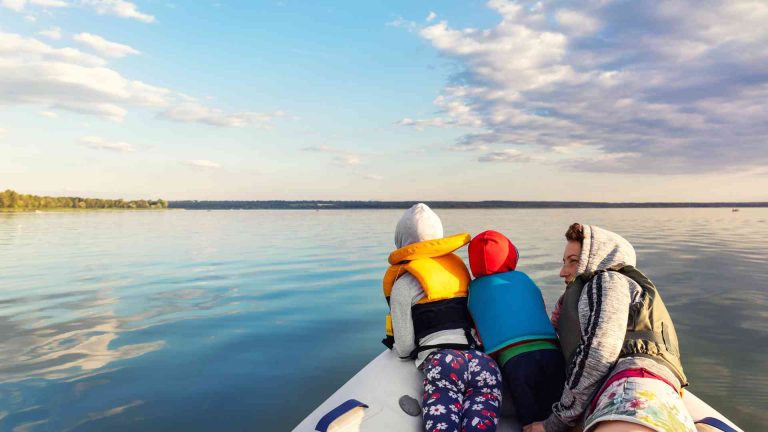
Can a River Boat Go in the Ocean? Guide with Limitations
Imagine the vastness of the open ocean, where waves crash against the horizon, and the sea stretches as far as the eye can see. Now, picture the serene beauty of a peaceful river, winding its way through lush landscapes and charming towns. Boats have the remarkable ability to traverse these diverse waters, each offering a…

Best Beaches for Boating: A Comprehensive Guide
Boating is a popular pastime that offers the perfect blend of adventure, relaxation, and scenic beauty. Whether you’re a seasoned sailor or a weekend water warrior, the beach destinations you choose can make all the difference. This article will guide you through some of the best beaches for boating around the world, detailing the unique…

Used Pontoon Boats for Sale by Owner Minnesota: Guide
Minnesota’s “Land of 10,000 Lakes” beckons boat lovers with its endless opportunities for aquatic adventures. Pontoon boats, with their spacious decks, comfortable seating, and stable platform, are ideal for cruising scenic waterways, enjoying relaxing days on the water with family and friends, or even fishing excursions. If you’re looking to join the fun on a…
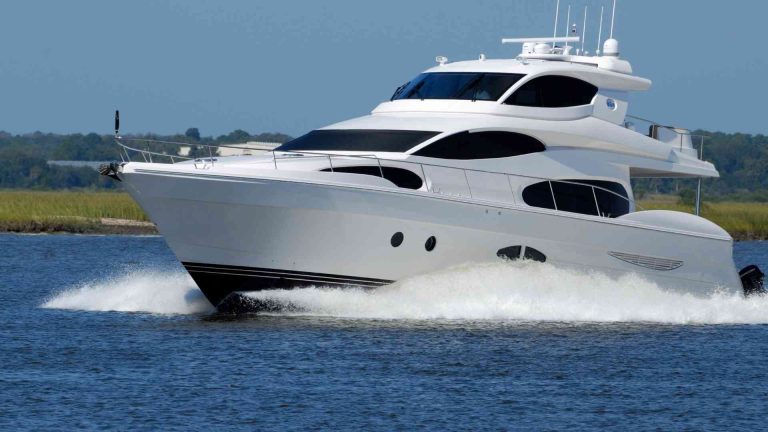
Do Boats Make Waves? Helpful Facts (For Beginners)
Picture this: a tranquil lake at sunrise, the surface of the water as still as glass, reflecting the colors of the waking world. Suddenly, the serenity is shattered by the powerful roar of a boat’s engine, and with it comes a cascade of waves, rippling outwards in all directions. These boat-generated waves are more than…

8 Cool Coasts to Cruise in the United States This Summer
Summer is the perfect time to set sail and explore some of the most stunning coastal regions in the United States. Whether you’re looking to cruise with breathtaking scenery, explore quaint seaside towns, or enjoy warm weather and cool waters, the U.S. offers an abundance of unforgettable coastlines. From the rugged shores of the Pacific…
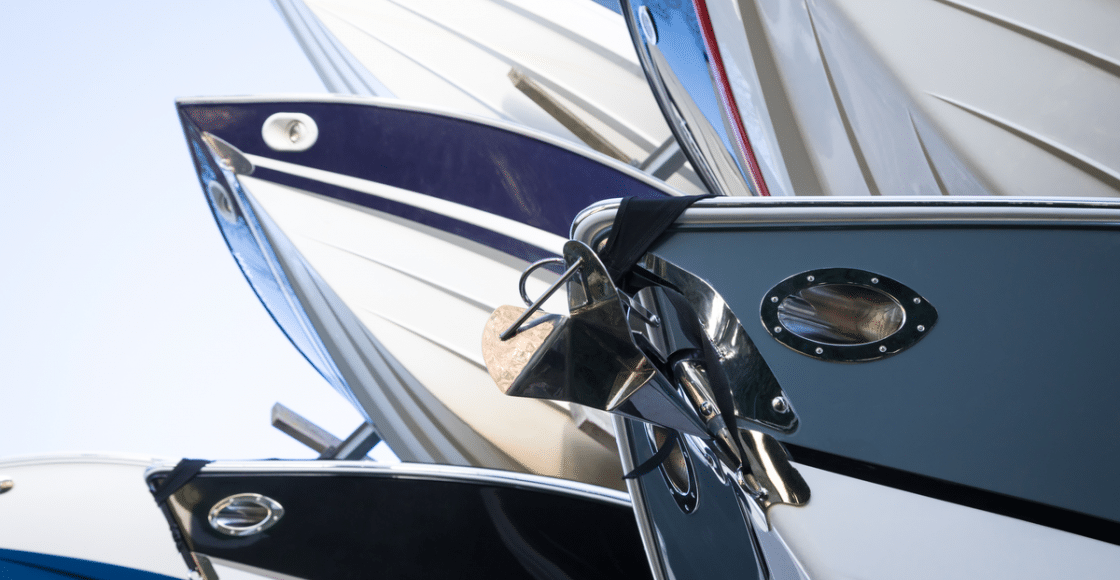
Boat Hulls 101: Complete Guide to Boat Hull Types, Shapes, and Designs

Table of Contents
Last Updated on August 17, 2023 by Boatsetter Team
If you’re new to boating, then you may not have even considered a boat’s hull , its importance, and the way that it affects your time on the water. With the hull being the part of the boat in the water, it is perhaps the most important part as it gives your boat the ability to float. Not only that, but it affects every single characteristic of your boat and the smoothness of your ride. This article on boat hulls will equip you with the technical knowledge and expertise necessary to understand hulls and the way they work.
What is a Boat Hull?
First of all, we’ll go into a bit of detail on what a boat hull is. The hull is the body of the boat. It is sealed to prevent water from transmitting its way through and keeping your boat afloat. A hull can be open where you sit in it, such as a small dinghy, or a deck may cover it as you would find on a yacht.
When there is a deck placed on top of a hull, it opens up many more options for utilizing the space on your boat more appropriately as it is raised to the top of the hull, where more space is apparent. For example, on a deck, you can place a cabin -like you would find on a center console or even a mast and sail rigs to create a sailboat.
When the hull is open, options to use your space effectively are reduced as you sit at the bottom of the bowl shape. In addition to having less space, you also feel the rock of the water in a more pronounced manner as it is just the keel of the boat (the bottom) separating you from the water. Therefore, every wave and lurch in the water that rocks the boat is felt, which may cause you discomfort if you haven’t quite found your sea legs.
Why Are Hulls Important?
The knowledge of how a boat floats is fundamental if you are looking to get into boating. Without actually knowing, you put yourself at risk of compromising your boating activities and creating a danger that you cause your boat to sink. The key line to this knowledge is that the air encapsulating your boat must be denser than the water it sits upon. This not only includes the air but the items on your boat as they contribute towards the pressure that your boat’s hull puts upon the water.
The greater the amount of weight your boat holds, the further it pushes itself into the water, lowering or raising the level that your hull sits in the water. This force displaces the water to a level that is equal to the boat. If the average density of the boat is greater than the water, then the boat shall sink. You can see this in action if you have a small dinghy; the more people you place on it, you’ll notice that your boat edges itself ever so slightly more into the water as the boat’s weight is rising.
Different types of Boat Hulls
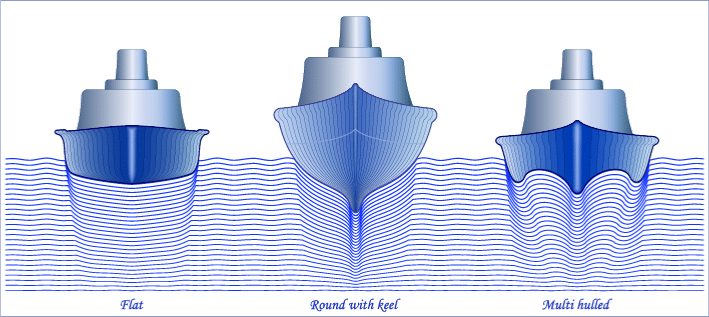
We’ll now walk you through the different types of boat hulls that you come across. The design of the boat’s hull changes the type of boat that you have. If you are browsing through our boat rentals, you’ll notice the various types of boats. Each of these boats has a different type of hull design. For example, a pontoon boat rental is designed for calm waters, whereas a giant yacht is designed for taking on the rough seas, meaning that their hulls vary greatly.
There are two main types of hull: displacement and planing. We’ll give you the rundown of both of these types and the other sub-varieties within them.
Displacement Hulls
The first variety of hulls that we shall examine are displacement hulls. These hulls are typically found on boats that need to carry a heavy load, such as a large fishing boat and big yachts. The hull sits deeper into the water, and the boat is supported by buoyancy, as opposed to its thrust.
Due to the boat sitting deeper in the water, it might be slower, but it will ride steadier. These larger boats are particularly good for the sea as they can handle stronger waves and currents as the boat can stabilize themselves better. This is why you’ll see container ships and other varieties that need to bear a heavy load using these types of hulls.
When it comes to boat rentals, you are most likely to find a sailing boat with a displacement boat hull. The hull is rounded at the bottom, allowing the sailboat to lurch strongly to one side while turning without any danger of capsizing. Thus, we can see the impact that the hull has on your boat rental as it gives your sailboat the extra capacity to lurch around sharp turns and enjoy some exhilarating fun.
Planing Hulls
The other main type of hull is the planing hull. This hull’s design allows the boat to accelerate to higher speeds due to less hull being placed in the water. When a boat with a planing hull is cruising at lower speeds, it operates similarly to a boat with a displacement. When it starts to hit around 15 knots, things start to change depending on the weight of the boat’s load. The flatter surface of the planing hull allows the boat to propel itself upwards to skiff itself across the water. This is what causes boats with planing hulls to obtain higher speeds. In addition, because the bulk of the hull is not placed below the water’s surface, there is less tension from the water holding the boat back, meaning that it can move through the water faster and using less power to obtain a speed that a boat with a displacement hull can.
There is not only one type of planing hull but instead many different varieties. We’ll look through these varieties to examine how it affects your boating experience so that you can make a more informed decision when choosing your next boat rental.
Flat Bottomed Hulls
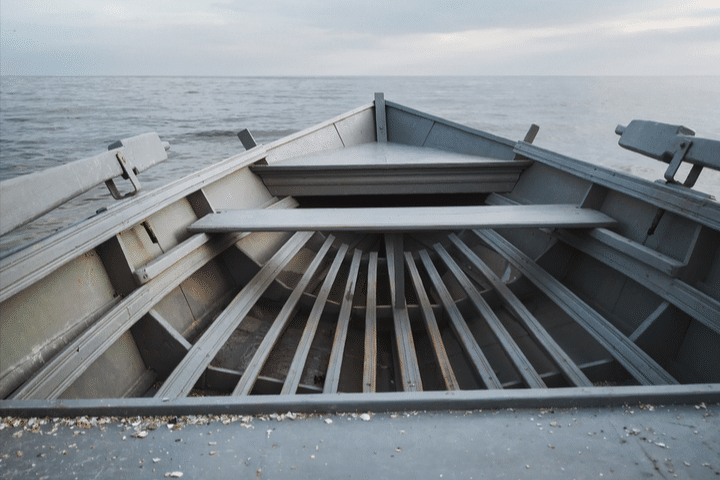
As the name suggests, these hulls do not have the traditional curved hull that reaches a point at the bottom but has a flat surface instead. These tend to be small skiffs or fishing boats where you cast out from. Due to them having a flat hull, they are excellent for getting into shallow water where some of your favorite catches may lie. These boats don’t need much power for the planing power to come into action and reach quick speeds in no time. They also tend to handle well not just on the flats but also on the sea, with choppy water not being a big issue. So, if you’re looking for some gentle fishing on the flats or maybe out in some nearshore waters, check out our range of small flat bottomed hull boats to truly enjoy some great fishing experiences.
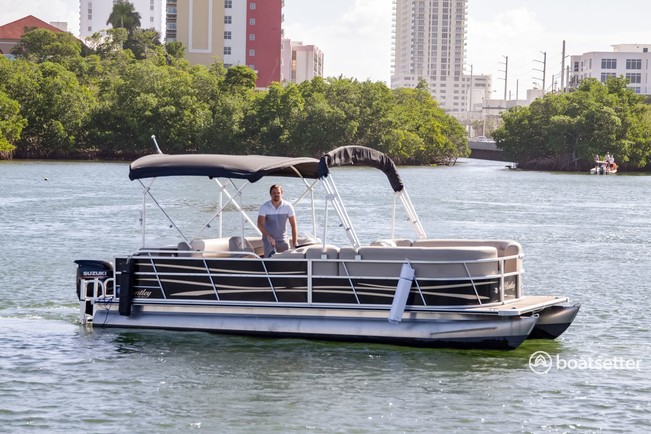
Pontoons are one of the great boat rentals for cruising around and enjoying time with friends because the design of their hulls allows for more space to be created. Pontoons have two-cylinder hulls that sit parallel to each other on the surface of the water. The deck is placed atop these two cylinders, and because they are placed on cylinders, the deck can expand beyond the cylinders, creating more space. This allows for a comfortable seating/social area to be created on the boat, allowing you to use it for parties and some relaxed exploring with the wider family. These boats are best used on inland and flat waters. This is due to waves rocking them a lot more, and a storm at sea can even put them at risk of capsizing. For some fun on a lake, however, pontoons are hard to beat.
In recent years many tritoons have started to crop up on the boat rental market. These are similar to pontoons, but they have a third cylinder that gives them some extra stability. It also means that they can handle a more powerful engine that can bring them up to higher speeds than a pontoon boat. If a pontoon has an engine that is too powerful, then its planing hull can lift it too far above the water’s surface, causing great instability. However, when it comes to tritoons, the greater speeds that you can reach allow you to expand upon other activities and add in some wakeboarding or tubing action onto your party on the water!
V Bottom Hull
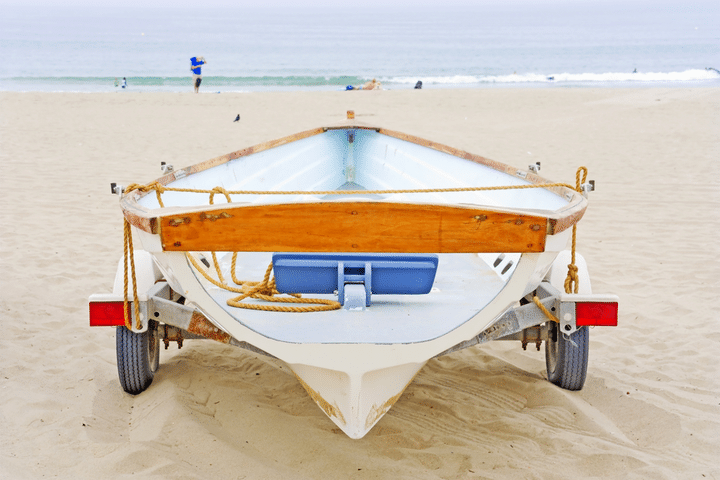
The shape of a v bottom hull has a sharper decline that accumulates in having a meeting point at the bottom, creating a v shape, as stated in the name. Because of the honed hull, one of these boats can cut through the water at decent speeds and are particularly good when out on seawater. However, they require a powerful engine for the boat to go into a planing mode. One of the most common types of v bottom hull boat rentals is center consoles. These are great vessels for going for some nearshore or offshore fishing or some general saltwater exploring. Their v bottom hull allows them to cut through the waves so that you can rush to the best fishing grounds in no time at all.
The tri-hull design is a variation of the v bottom hull. It has a v-shaped hull in the center and two parallel smaller hulls on either side of the main central one. This gives the tri-hull boat some extra stability when going forward . Additionally, this also allows the boat to have more deck space as the hull covers a wider range. One of the big drawbacks of the tri-hull – also known as a cathedral hull – is that the bat rocks more when it is in choppier water because the hull is wider. Nevertheless, tri-hulls make for a great option for fishing or exploring on lakes or calm coves.
Catamaran: A Multi-Hulled Boat
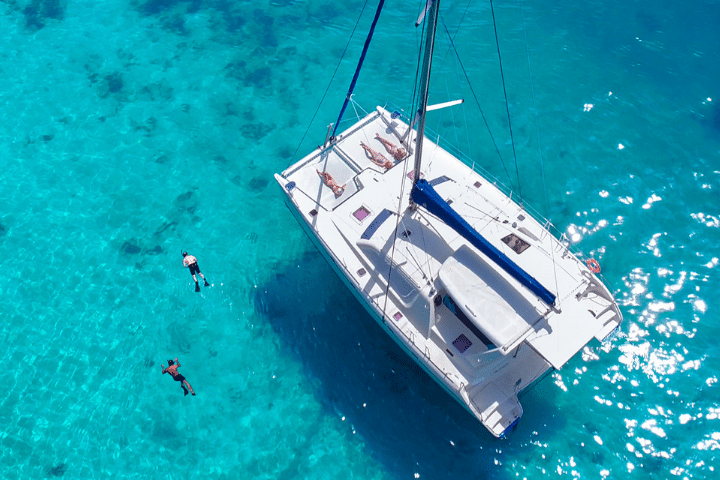
Perhaps the most popular multi-hulled boat is the catamaran. This type of boat has two separate hulls that run parallel to each other. These hulls sit on either side of the boat and the deck connects them. This type of design allows forecast amounts of space onboard . Many catamarans are luxury boats that can have the space to hold swimming pools and even helipads. Because they have dual hulls, catamarans can get themselves in shallow waters and lagoons where other luxury boats cannot. This makes them the perfect boat rental if you plan to visit a location where there are multiple small islands such as Hawaii or The Bahamas. The multi-hull system also provides a lot more stability and comfort, so they are perfect boat rentals if you are prone to suffering from seasickness . Catamarans are not only luxury liners as smaller versions with a trampoline-designed deck can also be found that make for great day adventures.
As we hope you have been able to discover in this blog post, the type of hull that your boat has affects everything about your boat. By having a little bit of knowledge on how the design of a boat’s hull has an impact on your boating experience, you can begin to make more informed decisions on which boat rental is best for you. To reinforce this information a little bit further, check out this video !

Boatsetter empowers people to explore with confidence by showing them a world of possibility on the water. Rent a boat, list your boat, or become a Boatsetter captain today.
Browse by experience

Explore articles

6 Best Locations to Celebrate Cinco de Mayo on the Water
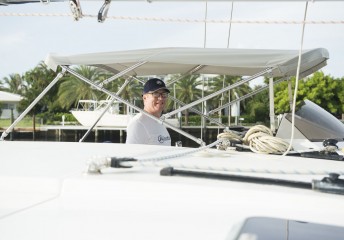
4 Ways to Own a Boat on a Budget
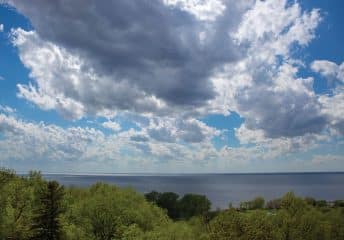
6 Best Lakes in Wisconsin for Boating
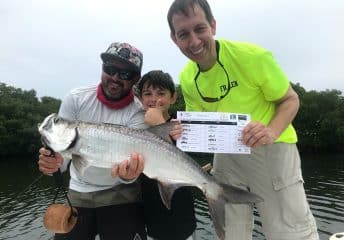
4 Tips for Planning a Group Fishing Charter or Tournament

The global authority in superyachting
- NEWSLETTERS
- Yachts Home
- The Superyacht Directory
- Yacht Reports
- Brokerage News
- The largest yachts in the world
- The Register
- Yacht Advice
- Yacht Design
- 12m to 24m yachts
- Monaco Yacht Show
- Builder Directory
- Designer Directory
- Interior Design Directory
- Naval Architect Directory
- Yachts for sale home
- Motor yachts
- Sailing yachts
- Explorer yachts
- Classic yachts
- Sale Broker Directory
- Charter Home
- Yachts for Charter
- Charter Destinations
- Charter Broker Directory
- Destinations Home
- Mediterranean
- South Pacific
- Rest of the World
- Boat Life Home
- Owners' Experiences
- Conservation and Philanthropy
- Interiors Suppliers
- Owners' Club
- Captains' Club
- BOAT Showcase
- Boat Presents
- Events Home
- World Superyacht Awards
- Superyacht Design Festival
- Design and Innovation Awards
- Young Designer of the Year Award
- Artistry and Craft Awards
- Explorer Yachts Summit
- Ocean Talks
- The Ocean Awards
- BOAT Connect
- Between the bays
- Golf Invitational
- BOATPro Home
- Superyacht Insight
- Global Order Book
- Premium Content
- Product Features
- Testimonials
- Pricing Plan
- Tenders & Equipment
A guide to superyacht hull design
In this guide to superyacht hull design, we break down the specs, must-know information and outline all of the pros and cons of the typical superyacht hull shapes.
Displacement yacht hull design
- Fn: up to about 0.42
- Average power requirement: 5hp/ton
- Prismatic coefficient: 0.56 0.64
- LCB: 0.50 0.54 (54 per cent back from waterline entry)
- Can be optimised for resistance
- Capable of doing hull speed
- High displacement over length
- Much more forgiving in terms of weight, where the impact on performance is minor
- Less initial stability, but more dynamic stability, which equals more comfort
- If you want more speed, you have to increase the length
- Can carry more fuel, and use less, which equates to more range
- Offers the most volume at common interior positions
- Engine room smaller less power:weight ratio
- Increase stability by reducing weight (if the centre of gravity remains the same) a heavy boat is not necessarily more stable
- Interior materials do not need to be lightweight
Semi-displacement (semi-planing) yacht hull design
- Fn: 0.6 1.1
- Average power requirement: 10hp/ton 40hp/ton
- Prismatic coefficient: 0.63 0.68
- LCB: 0.53 0.57 (more volume aft)
- More buoyancy aft means can keep pushing more power, but this means increased resistance at lower speeds
- Resistance heavily depends on the frictional component; reducing weight can minimise it
- Flatter, lighter, sharper forebody all more suitable for generating hydrodynamic force on the bottom
- Higher initial stability
- Larger transom beam means more broaching tendency in a following sea
- Less flexibility in weight and weight position
- Wider speed range, so lower speeds mean lower engine loading which is not optimal
- There is an optimum size going smaller and smaller makes semi-planing hull harder to achieve, and going larger and larger means the weight increases disproportionately
- Much superior seakeeping compared to planing boat
- Can optimise for higher or lower speeds, but not both
- Less volume in hull, especially forward part
- Best of both worlds lots of possibilities
Planing yacht hull design
- Fn: 1.1 and above, preferably from 2 and up
- Average power requirement: 60hp/ton plus
- Prismatic coefficient: 0.68 0.76
- LCB: 0.58 0.64
- Typically monohedral prismatic aft shape constant deadrise
- Light displacement
- Engine room forms a significant part of hull volume (up to 30-40 per cent)
- Weight matters power:weight ratio is critical
- Usually very sharp entry angles, although Fn 1.2 to 2 favours LCG forward and blunt entry
- Big beam and little weight mean extreme initial stability
- Uncomfortable in certain sea conditions
- Friction significant, so if left in the water for a couple of seasons speed will drop
- Wavemaking coefficient very low, so frictional resistance is the dominant component
- Lots of exotic hull shapes, designed to reduce wetted surface and improve comfort in a seaway
- Little effective volume foreship, nothing fits; aft ship all engines
- Dynamic stability is a big factor, and can limit what is possible
- Speed benefit, and can escape bad weather
Sign up to BOAT Briefing email
Latest news, brokerage headlines and yacht exclusives, every weekday
By signing up for BOAT newsletters, you agree to our Terms of Use and our Privacy Policy .
More stories
Most popular, from our partners, sponsored listings.

The evolution of yacht design – yachting style
Evolution of yacht design, Superyacht builders, Marine boat construction, Future hull marina architecture
The future of yacht design
9 September 2024
Author: Joanna Lewis
Yacht design is constantly evolving as yacht designers push the boundaries of traditional design and new technologies come to the fore.
The world’s most iconic yachts boast striking design features that set them apart from other vessels, from innovative naval architecture to design features that focus on enhancing a yacht’s green credentials.
Here we take a look at some of the most pioneering yacht design trends changing the yachting industry for the better.
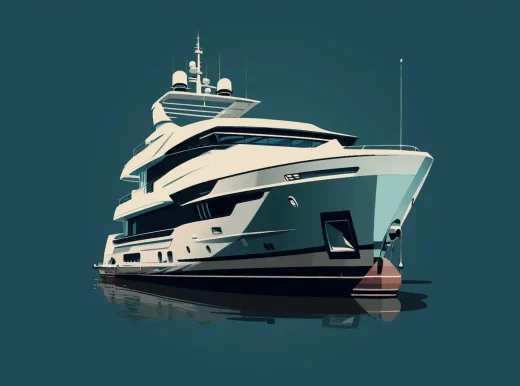
Interior yacht design trends
Interior yacht design has changed significantly to factor in modern yachting lifestyles.
Yacht interiors now have a strong focus on flexible layouts that are more open-plan. Furthermore, there is a growing trend for onboard spaces that blur the boundaries between a yacht’s interior and exterior areas. Vast glass sliding doors that can be fully opened, retractable roofs, and fold-down balconies are designed to completely eliminate any boundary between a yacht’s interior and exterior.
Wellness is a big part of the yachting lifestyle, with private yachts now dedicating a significant portion of their real estate to spas, fitness suites, and yoga and meditation areas. Interior designers are also now bringing nature onboard, with hydroponic and vertical gardens that not only enhance wellbeing but also offer chefs access to an organic garden.
The latest interior yacht design trends are also harnessing exciting new materials such as sustainable textured wood, recycled glass, natural stone, and fine fabrics with a firm nod to organic forms that mimic nature.
Finally, advances in digital technology are transforming interiors, with vast tech windows or walls that offer virtual views and streaming services.
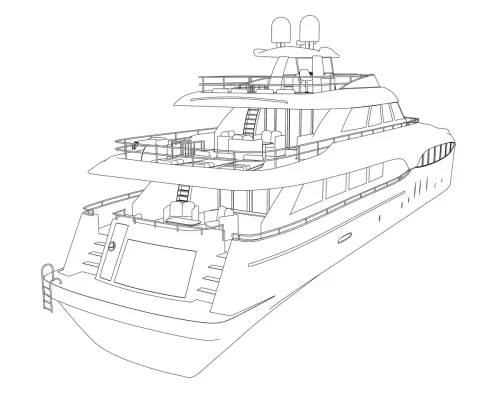
Exterior yacht design trends
Exterior yacht design has, arguably, seen the most significant shift in design trends from vessels with soft curved exteriors that mimic the organic shapes found in nature to avant-garde vessels that challenge conventional yacht design.
One key advancement in technology has been glass, which has led to a slew of eye-catching vessels with vast glass superstructures. Not only does the use of glass create head-turning vessels, but this material also floods the interior with light, while providing owners and their guests with breathtaking views of the ocean.
In addition, yacht exteriors are becoming more striking, with deck spaces being used in new ways. Yacht designers are now placing more emphasis on a yacht’s exterior with an increasing amount of real estate being designated to alfresco dining.
Vast beach clubs are now the norm on modern-day vessels, enhancing an owner’s connection to the water and direct access to the sea. It is common to see multiple exterior decks for relaxing and entertaining.
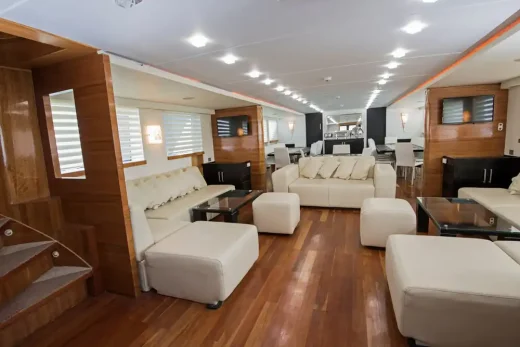
New advances in hull design are also helping to transform onboard comfort and the overall performance of luxury yachts. A hull typically amounts to around 70% of a yacht’s total structural design, making hull design a complex part of a yacht’s overall design.
Thanks to advances in hull designs, modern yachts now boast enhanced seakeeping and energy efficiencies.
There is no question that the world of yacht design is constantly evolving as designers seek to create ever more eye-catching vessels that meet the demands and lifestyle habits of today’s yachting enthusiasts
Comments on a guide to Evolution of yacht design – marine boat construction are welcome
Boat Design Articles
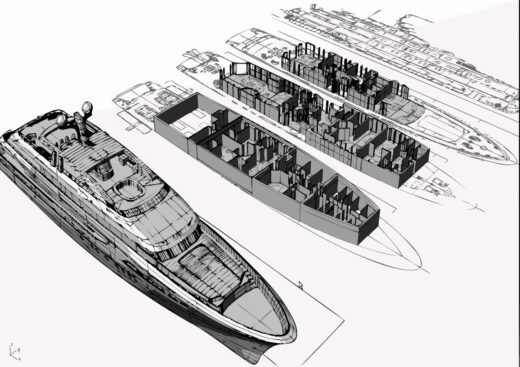
New Yachts 2018
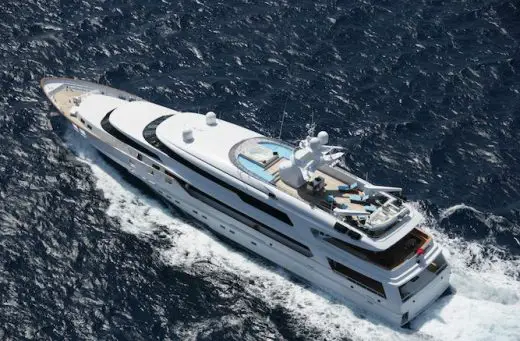
Yachtsman’s House on the Isle of Wight
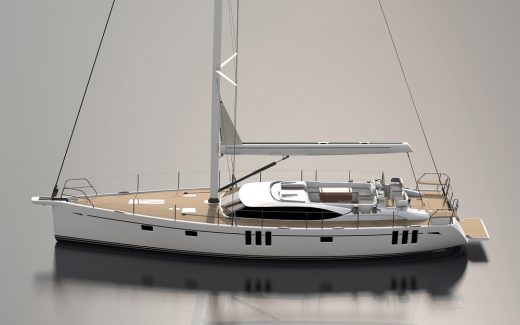
Marina Architecture
Building a Superyacht
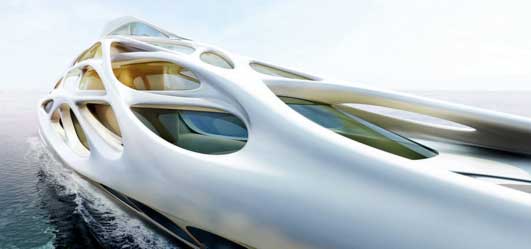
Comments / photos for the Evolution of yacht design – modern boat construction page welcome.

My Cruiser Life Magazine
Basics of Sailboat Hull Design – EXPLAINED For Owners
There are a lot of different sailboats in the world. In fact, they’ve been making sailboats for thousands of years. And over that time, mankind and naval architects (okay, mostly the naval architects!) have learned a thing or two.
If you’re wondering what makes one sailboat different from another, consider this article a primer. It certainly doesn’t contain everything you’d need to know to build a sailboat, but it gives the novice boater some ideas of what goes on behind the curtain. It will also provide some tips to help you compare different boats on the water, and hopefully, it will guide you towards the sort of boat you could call home one day.
Table of Contents
Displacement hulls, semi displacement hulls, planing hulls, history of sailboat hull design, greater waterline length, distinctive hull shape and fin keel designs, ratios in hull design, the hull truth and nothing but the truth, sail boat hull design faqs.

Basics of Hull Design
When you think about a sailboat hull and how it is built, you might start thinking about the shape of a keel. This has certainly spurred a lot of different designs over the years, but the hull of a sailboat today is designed almost independently of the keel.
In fact, if you look at a particular make and model of sailboat, you’ll notice that the makers often offer it with a variety of keel options. For example, this new Jeanneau Sun Odyssey comes with either a full fin bulb keel, shallow draft bulb fin, or very shallow draft swing keel. Where older long keel designs had the keel included in the hull mold, today’s bolt-on fin keel designs allow the manufacturers more leeway in customizing a yacht to your specifications.
What you’re left with is a hull, and boat hulls take three basic forms.
- Displacement hull
- Semi-displacement hulls
- Planing hulls
Most times, the hull of a sailboat will be a displacement hull. To float, a boat must displace a volume of water equal in weight to that of the yacht. This is Archimedes Principle , and it’s how displacement hulled boats get their name.
The displacement hull sailboat has dominated the Maritimes for thousands of years. It has only been in the last century that other designs have caught on, thanks to advances in engine technologies. In short, sailboats and sail-powered ships are nearly always displacement cruisers because they lack the power to do anything else.
A displacement hull rides low in the water and continuously displaces its weight in water. That means that all of that water must be pushed out of the vessel’s way, and this creates some operating limitations. As it pushes the water, water is built up ahead of the boat in a bow wave. This wave creates a trough along the side of the boat, and the wave goes up again at the stern. The distance between the two waves is a limiting factor because the wave trough between them creates a suction.
This suction pulls the boat down and creates drag as the vessel moves through the water. So in effect, no matter how much power is applied to a displacement hulled vessel, it cannot go faster than a certain speed. That speed is referred to as the hull speed, and it’s a factor of a boat’s length and width.
For an average 38 foot sailboat, the hull speed is around 8.3 knots. This is why shipping companies competed to have the fastest ship for many years by building larger and larger ships.
While they might sound old-school and boring, displacement hulls are very efficient because they require very little power—and therefore very little fuel—to get them up to hull speed. This is one reason enormous container ships operate so efficiently.
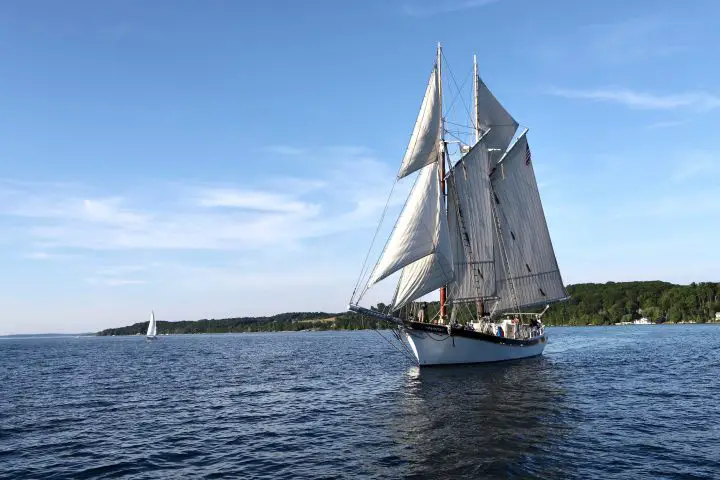
Of course, living in the 21st century, you undoubtedly have seen boats go faster than their hull speed. Going faster is simply a matter of defeating the bow wave in one way or another.
One way is to build the boat so that it can step up onto and ride the bow wave like a surfer. This is basically what a semi-displacement hull does. With enough power, this type of boat can surf its bow wave, break the suction it creates and beat its displacement hull speed.
With even more power, a boat can leave its bow wave in the dust and zoom past it. This requires the boat’s bottom to channel water away and sit on the surface. Once it is out of the water, any speed is achievable with enough power.
But it takes enormous amounts of power to get a boat on plane, so planing hulls are hardly efficient. But they are fast. Speedboats are planing hulls, so if you require speed, go ahead and research the cost of a speedboat .
The most stable and forgiving planing hull designs have a deep v hull. A very shallow draft, flat bottomed boat can plane too, but it provides an unforgiving and rough ride in any sort of chop.
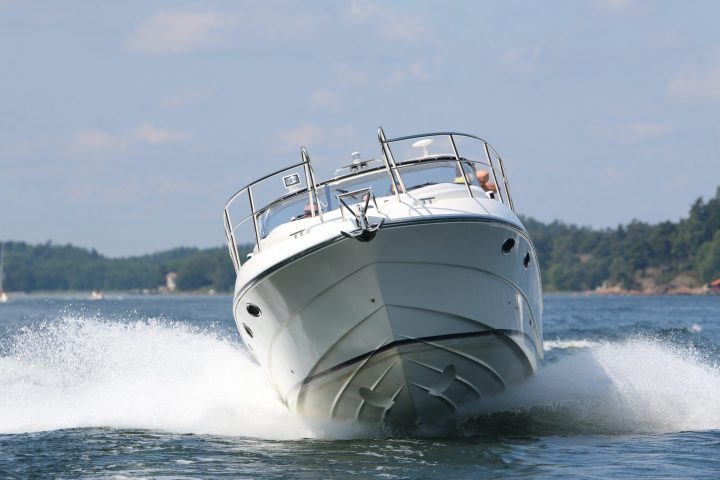
If you compare the shapes of the sailboats of today with the cruising boat designs of the 1960s and 70s, you’ll notice that quite a lot has changed in the last 50-plus years. Of course, the old designs are still popular among sailors, but it’s not easy to find a boat like that being built today.
Today’s boats are sleeker. They have wide transoms and flat bottoms. They’re more likely to support fin keels and spade rudders. Rigs have also changed, with the fractional sloop being the preferred setup for most modern production boats.
Why have boats changed so much? And why did boats look so different back then?
One reason was the racing standards of the day. Boats in the 1960s were built to the IOR (International Offshore Rule). Since many owners raced their boats, the IOR handicaps standardized things to make fair play between different makes and models on the racecourse.
The IOR rule book was dense and complicated. But as manufacturers started building yachts, or as they looked at the competition and tried to do better, they all took a basic form. The IOR rule wasn’t the only one around . There were also the Universal Rule, International Rule, Yacht Racing Association Rul, Bermuda Rule, and a slew of others.
Part of this similarity was the rule, and part of it was simply the collective knowledge and tradition of yacht building. But at that time, there was much less distance between the yachts you could buy from the manufacturers and those setting off on long-distance races.
Today, those wishing to compete in serious racing a building boat’s purpose-built for the task. As a result, one-design racing is now more popular. And similarly, pleasure boats designed for leisurely coastal and offshore hops are likewise built for the task at hand. No longer are the lines blurred between the two, and no longer are one set of sailors “making do” with the requirements set by the other set.
Modern Features of Sailboat Hull Design
So, what exactly sets today’s cruising and liveaboard boats apart from those built-in decades past?
Today’s designs usually feature plumb bows and the maximum beam carried to the aft end. The broad transom allows for a walk-through swim platform and sometimes even storage for the dinghy in a “garage.”
The other significant advantage of this layout is that it maximizes waterline length, which makes a faster boat. Unfortunately, while the boats of yesteryear might have had lovely graceful overhangs, their waterline lengths are generally no match for newer boats.
The wide beam carried aft also provides an enormous amount of living space. The surface area of modern cockpits is nothing short of astounding when it comes to living and entertaining.
If you look at the hull lines or can catch a glimpse of these boats out of the water, you’ll notice their underwater profiles are radically different too. It’s hard to find a full keel design boat today. Instead, fin keels dominate, along with high aspect ratio spade rudders.
The flat bottom boats of today mean a more stable boat that rides flatter. These boats can really move without heeling over like past designs. Additionally, their designs make it possible in some cases for these boats to surf their bow waves, meaning that with enough power, they can easily achieve and sometimes exceed—at least for short bursts—their hull speeds. Many of these features have been found on race boats for decades.
There are downsides to these designs, of course. The flat bottom boats often tend to pound when sailing upwind , but most sailors like the extra speed when heading downwind.
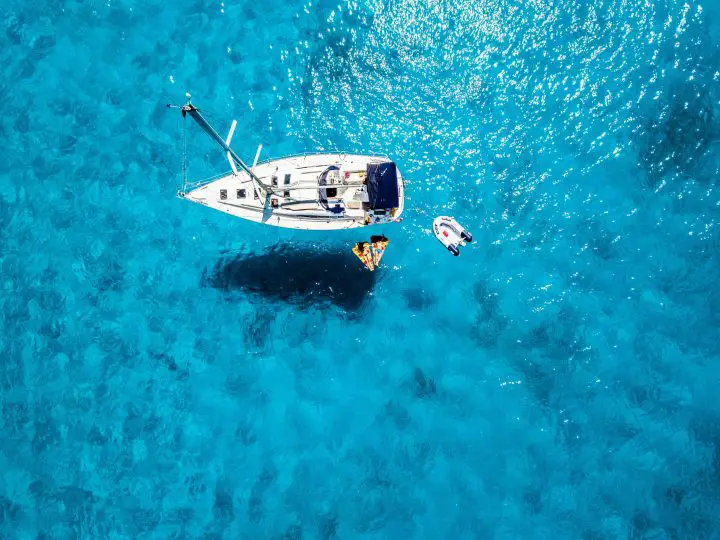

How Do You Make a Stable Hull
Ultimately, the job of a sailboat hull is to keep the boat afloat and create stability. These are the fundamentals of a seaworthy vessel.
There are two types of stability that a design addresses . The first is the initial stability, which is how resistant to heeling the design is. For example, compare a classic, narrow-beamed monohull and a wide catamaran for a moment. The monohull has very little initial stability because it heels over in even light winds. That doesn’t mean it tips over, but it is relatively easy to make heel.
A catamaran, on the other hand, has very high initial stability. It resists the heel and remains level. Designers call this type of stability form stability.
There is also secondary stability, or ultimate stability. This is how resistant the boat is to a total capsize. Monohull sailboats have an immense amount of ballast low in their keels, which means they have very high ultimate stability. A narrow monohull has low form stability but very high ultimate stability. A sailor would likely describe this boat as “tender,” but they would never doubt its ability to right itself after a knock-down or capsize.
On the other hand, the catamaran has extremely high form stability, but once the boat heels, it has little ultimate stability. In other words, beyond a certain point, there is nothing to prevent it from capsizing.
Both catamarans and modern monohulls’ hull shapes use their beams to reduce the amount of ballast and weight . A lighter boat can sail fast, but to make it more stable, naval architects increase the beam to increase the form stability.
If you’d like to know more about how stable a hull is, you’ll want to learn about the Gz Curve , which is the mathematical calculation you can make based on a hull’s form and ultimate stabilities.
How does a lowly sailor make heads or tails out of this? You don’t have to be a naval architect when comparing different designs to understand the basics. Two ratios can help you predict how stable a design will be .
The first is the displacement to length ratio . The formula to calculate it is D / (0.01L)^3 , where D is displacement in tons and L is waterline length in feet. But most sailboat specifications, like those found on sailboatdata.com , list the D/L Ratio.
This ratio helps understand how heavy a boat is for its length. Heavier boats must move more water to make way, so a heavy boat is more likely to be slower. But, for the ocean-going cruiser, a heavy boat means a stable boat that requires much force to jostle or toss about. A light displacement boat might pound in a seaway, and a heavy one is likely to provide a softer ride.
The second ratio of interest is the sail area to displacement ratio. To calculate, take SA / (D)^0.67 , where SA is the sail area in square feet and D is displacement in cubic feet. Again, many online sites provide the ratio calculated for specific makes and models.
This ratio tells you how much power a boat has. A lower ratio means that the boat doesn’t have much power to move its weight, while a bigger number means it has more “get up and go.” Of course, if you really want to sail fast, you’d want the boat to have a low displacement/length and a high sail area/displacement.
Multihull Sailboat Hulls
Multihull sailboats are more popular than ever before. While many people quote catamaran speed as their primary interest, the fact is that multihulls have a lot to offer cruising and traveling boaters. These vessels are not limited to coastal cruising, as was once believed. Most sizable cats and trimarans are ocean certified.
Both catamarans and trimaran hull designs allow for fast sailing. Their wide beam allows them to sail flat while having extreme form stability.
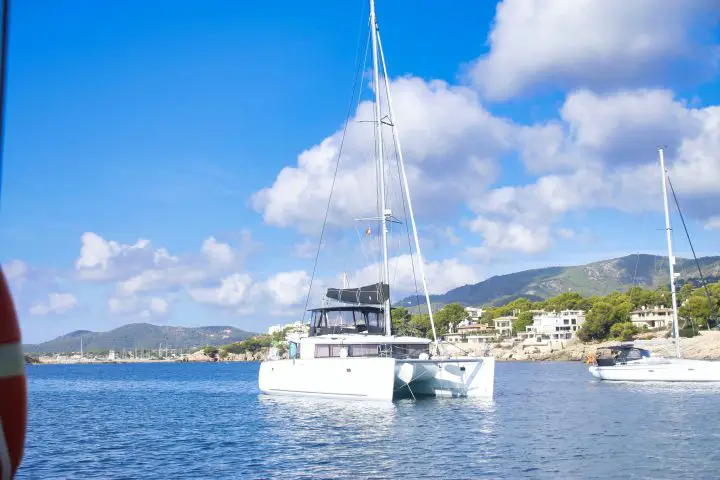
Catamarans have two hulls connected by a large bridge deck. The best part for cruisers is that their big surface area is full of living space. The bridge deck usually features large, open cockpits with connecting salons. Wrap around windows let in tons of light and fresh air.
Trimarans are basically monohulls with an outrigger hull on each side. Their designs are generally less spacious than catamarans, but they sail even faster. In addition, the outer hulls eliminate the need for heavy ballast, significantly reducing the wetted area of the hulls.
Boaters and cruising sailors don’t need to be experts in yacht design, but having a rough understanding of the basics can help you pick the right boat. Boat design is a series of compromises, and knowing the ones that designers and builders take will help you understand what the boat is for and how it should be used.
What is the most efficient boat hull design?
The most efficient hull design is the displacement hull. This type of boat sits low in the water and pushes the water out of its way. It is limited to its designed hull speed, a factor of its length. But cruising at hull speed or less requires very little energy and can be done very efficiently.
By way of example, most sailboats have very small engines. A typical 40-foot sailboat has a 50 horsepower motor that burns around one gallon of diesel every hour. In contrast, a 40-foot planing speedboat may have 1,000 horsepower (or more). Its multiple motors would likely be consuming more than 100 gallons per hour (or more). Using these rough numbers, the sailboat achieves about 8 miles per gallon, while the speedboat gets around 2 mpg.
What are sail boat hulls made of?
Nearly all modern sailboats are made of fiberglass.
Traditionally, boats were made of wood, and many traditional vessels still are today. There are also metal boats made of steel or aluminum, but these designs are less common. Metal boats are more common in expedition yachts or those used in high-latitude sailing.
Matt has been boating around Florida for over 25 years in everything from small powerboats to large cruising catamarans. He currently lives aboard a 38-foot Cabo Rico sailboat with his wife Lucy and adventure dog Chelsea. Together, they cruise between winters in The Bahamas and summers in the Chesapeake Bay.

U.S Navy Commissions USS New Jersey, First Ever Submarine For A Mixed Gender Crew

World’s Largest Hotel-Branded Superyacht Sets Sail For Maiden Voyage

India Establishes Its First Maritime Arbitration Center

Yanmar Unveils Its First Electric Propulsion Product For Emission-Free Sailing

Hull of a Ship – Understanding Design and Characteristics
The hull of a ship is the most notable structural entity of the ship. To define the hull, it can be said that it is the watertight enclosure of the ship, which protects the cargo, machinery, and accommodation spaces of the ship from the weather, flooding, and structural damage. But this alone does not suffice our requirements of understanding all the aspects of a ship’s hull.
In this article, we will see how the hull of a ship is designed for various factors taken into consideration during the entire lifetime of the ship, and how the design of a ship’s hull plays the most important role in the entire ship design and shipbuilding project.
Hull Related Nomenclature
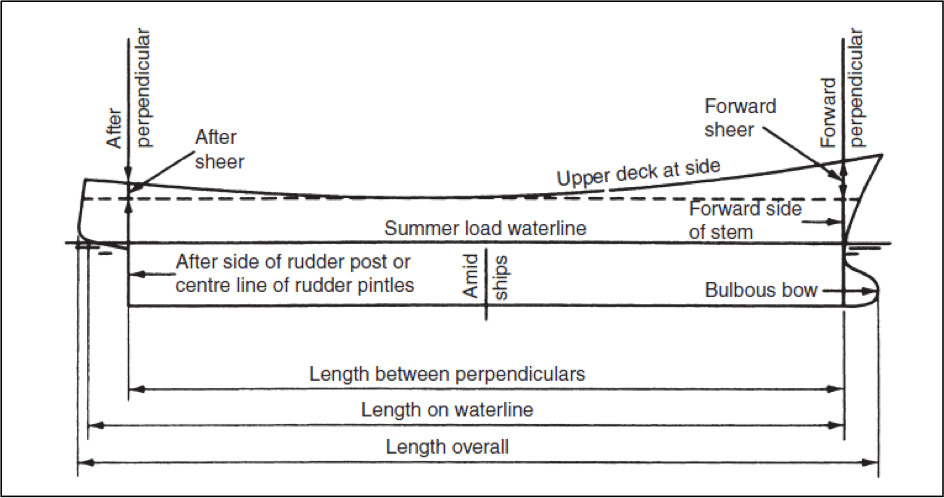
The above figure shows the schematic profile of a conventional ship’s hull. Understanding the meaning and applications of the nomenclatures related to it forms the basics of understanding ship design and shipbuilding technology.
Bow and Stern : The forward most contour of the ship’s hull is called the bow, and the aft-most, its stern. The stem is the forward most contour part of the bow.
Forward Perpendicular : If a perpendicular is drawn at the point where the bow intersects the waterline, this imaginary perpendicular line is called the forward perpendicular. For most of the hydrostatic calculations, the forward perpendicular is used as the forward reference of the hull.
Aft Perpendicular : Depending on the designer, the aft perpendicular can be the perpendicular drawn through the aft side of the rudder post or through the center-line of the rudder pintles. The aft perpendicular is the aft reference line for all hydrostatic calculations.
Length between Perpendiculars : The length between the forward and aft perpendiculars is the length between perpendiculars. The LBP is a very important parameter in all stability calculations, hence calculation of the LBP at various drafts becomes an important step in carrying out stability analyses.
Sheer : The upward curve formed by the main deck with reference to the level of the deck at the midship, is called sheer. It is usually given to allow flow of green water from the forward and aft ends to the midship and allow drainage to the bilges. The forward sheer is usually more than the aft sheer to protect the forward anchoring machinery from the waves.
Summer Load Line : The summer load line is the waterline of the ship at sea water when it is at its design weight and ballast conditions. It is also called the design draft; this forms the reference for all other load lines of the ship.
Length of Waterline : The length of the ship’s hull at the summer load line is the length of waterline for the ship. This length plays an important role in the calculation of hydrostatics of the ship, as well as propeller design calculations.
Length Overall : The length between the forward-most and aft-most point of the ship’s hull is its overall length. This length plays a major role in designing the docking and undocking plans of the ship. In shipyards where multiple building docks are available, the overall length, beam, and depth of the ship is a deciding factor in choosing a suitable building block for the ship.
Hull Lines and Shape
The first step in designing a hull of a ship is designing its shape and form. The form of the ship’s hull is estimated by means of various form coefficients, discussed as follows:
Block Coefficient: Block coefficient is the ratio of the ship’s underwater volume to the volume of the imaginary rectangle enclosing the underwater portion of the hull. Since the length, breadth, and height of this enclosing rectangle would be the length between perpendiculars, Maximum Beam, and Draft of the ship, the block coefficient is expressed as follows:

The value of block coefficient is one for a ship with the rectangular cross-section. Hence, for a typical ship’s hull form, it would be less than one. The higher the block coefficient, the fuller is the hull form (e.g. oil tankers, bulk carriers). Finer hull-forms have lower block coefficients (e.g. container ships , warships).
Midship Coefficient : The midship coefficient is the ratio of the submerged area of the midship section to the enclosing rectangle. It is hence expressed as:

There are a number of other form coefficients like prismatic Coefficient, Volumetric Coefficient, etc. which are basically the parameters used to define the volumetric distribution of the ship’s hull along its length. Once these coefficients are arrived at, from statistical studies, the hull lines are developed.
The lines plan of a ship’s hull comprises of three views. To understand the lines plan, we first need to know what are buttocks and waterlines.
When the hull of a ship is cut into multiple sections longitudinally, that is, if you slice the ship’s hull at every two meters starting from port to starboard, you would produce longitudinal sections at every two meters. The contour of each longitudinal section is called a buttock line, and this is exactly what is represented in the profile plan, as shown below. The reference lines for the profile view are the stations (vertical grid lines, which denote the longitudinal position) and waterlines (horizontal lines, which denote vertical positions).

If the ship’s hull is sliced along each waterline, then every waterline produces a distinct curve. Since a ship’s hull is symmetric about the centerline, a common practice prevails in which the curve is drawn on either side of the centerline, and this view is called the body plan or the half breadth plan of the ship.

Important Tip: The shape of the waterlines (in the half breadth plan) play a deciding role in the shape of the stern and the efficiency of the propeller. In the above figure, the waterlines move away from the ship’s centerline with the increase in height above baseline. That is, the innermost curve is the lowermost waterline. Take note of how the waterlines straighten at the aft as we move upward from the keel. This shows that the ship has a transom stern. So why is transom stern preferred? The answer lies in the shape of the waterlines at the stern. The longitudinal direction was taken by the waterlines at the stern ensure the flow of water at the stern in a direction almost perpendicular to the propeller disc. This ensures minimum crossflow at the propeller, therefore ensuring maximum propeller efficiency.
If the ship’s hull is sliced to form a section at every station, we obtain the body plan, as shown below. The typical practice of drawing the body plan is to denote all the half sections (due to the hull’s symmetricity). The sections forward of the midship are drawn on the right side of the center line, and all the sections from the midship to the stern are drawn on the left side.
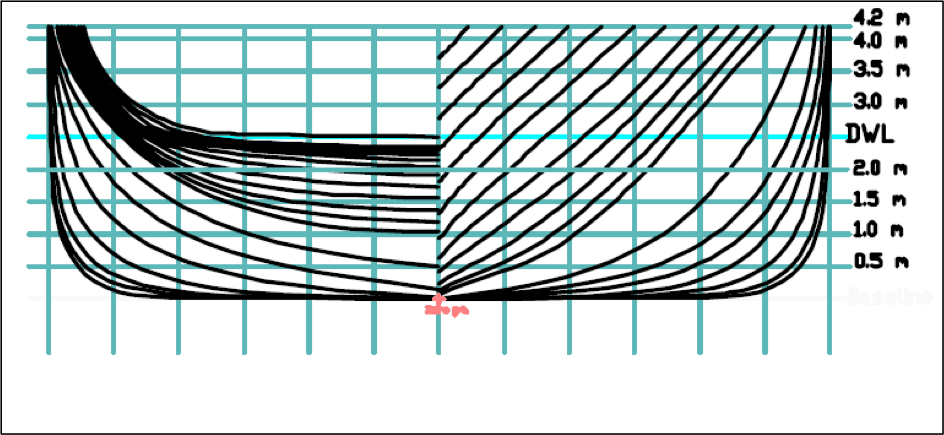
The body plan is the most useful representation of the ship’s hull lines. The reference lines in the body plan are the buttocks (vertical grid-lines), and the waterlines (horizontal grid lines). The body plan, along with the reference lines can be self sufficiently used to develop the profile plan and half breadth plan of the ship. It is also useful in developing the sectional area curve, and bonjean curves of the ship.
The complete lines plan of a ship is arranged by placing the profile view on top, with the half breadth plan just below it, and the body plan to its right, as shown below. The lines plan provides for the foundation of developing not only the three-dimensional hull model, but also developing frame-wise structural drawings, general arrangement, and loft drawings at the shipyard.
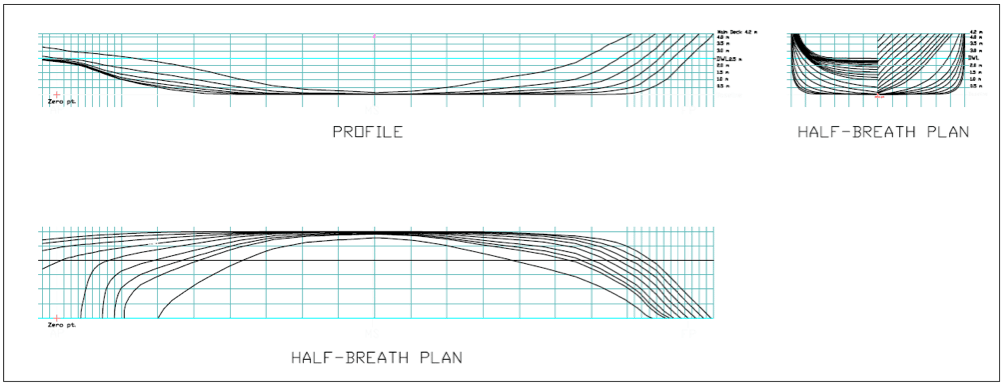
Hull Structure and Strength
The structural design of the hull of a ship amounts to approximately 70 percent of the total structural design of the ship. The stages in designing the hull structure are as follows:
Step 1: Calculation of Loads on the Hull: This is where the classification society rules come into play. Rulebooks have specialized formulae for calculation of wave loads on the ship’s hull. The still water bending moment, wave bending moment, and shear forces are to be calculated using these formulae. These load values act as set points in the entire structural design process.
Step 2: Scantling Calculations for Midship: The dimensions of all the structural members of the ship (plates, stiffeners, girders, beams, pillars, etc.) are collectively called scantlings. The loads calculated in Step 1 are used to arrive at the scantlings, and this is calculated for structural members at every frame.
Step 3: Midship Section Modulus: The midship section structural drawing is prepared according to the calculated scantlings. This is followed by locating the neutral axis of the midship section and calculating the section modulus of the midship section. Two criteria are to be satisfied at this stage:
- The obtained midship section must be equal to or more than the minimum section modulus value obtained by the empirical formula in the rule book.
- The bending stress at the deck and the keel are calculated, and it is checked if the stress values are within the required factor of safety.
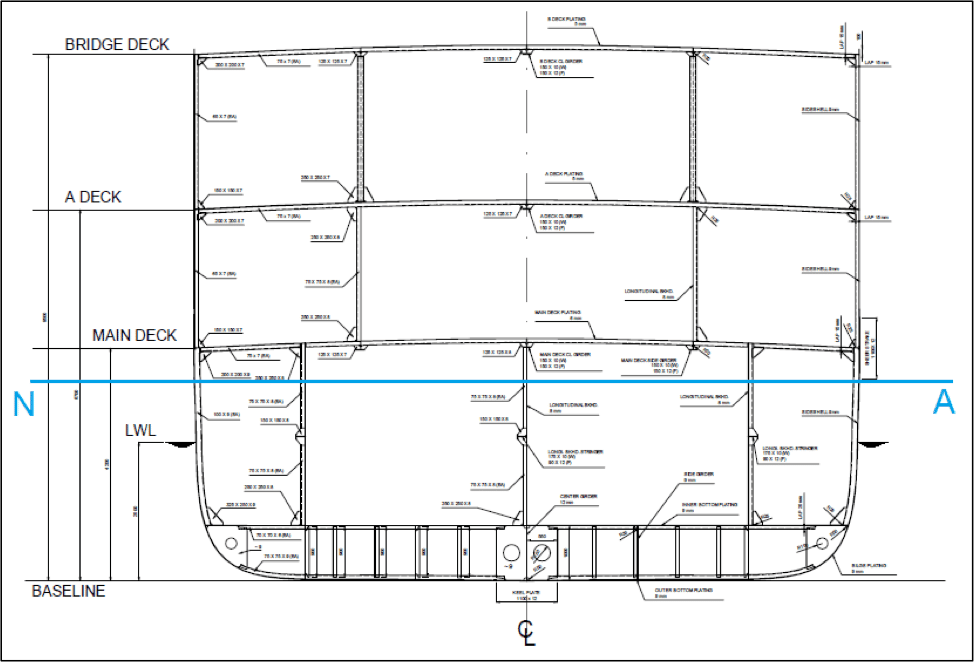
In the above midship section drawing, the blue line (NA) is the neutral axis of the section. The bending stress graph is drawn with the neutral axis with the reference (origin), and the top-most and lowermost ends of the graph would denote the stress values at the deck and keel respectively, as shown in the stress graph below.
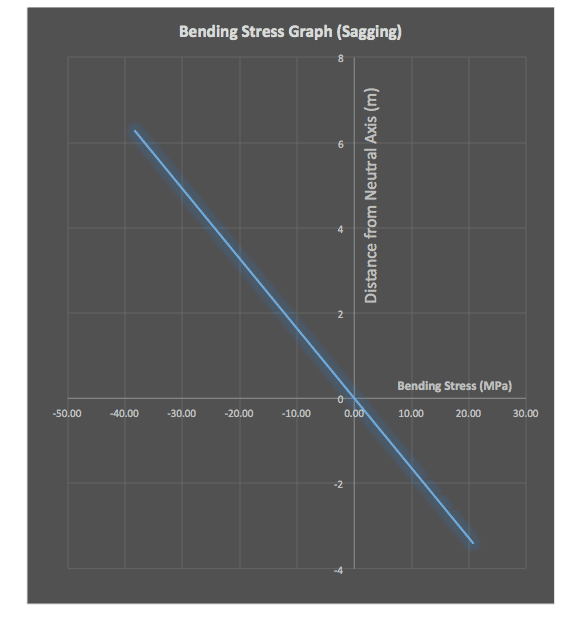
Why do you think it is important to design the structure of the midship section of the ship before any other sections? Read this article to find out what makes midship the structurally most important region of the ship.
Step 4: Frame-wise Scantling Calculation: Once the midship scantlings satisfy the criteria, the scantlings for structural members at each frame are calculated, and corresponding frame-wise structural drawings are prepared. Special formulae are applied for the forward and aft sections, and bulkheads, and drawings are prepared for the same.
Step 5: Calculation of Steel Weight: The obtained scantlings are the used to calculate the steel weight of the ship. This is where the iteration begins. If the calculated steel weight lies outside the empirically and statistically obtained values, the designer might have to look at using lighter weight steel at suitable regions or take other decisions to keep the lightship weight within limits.
Step 6: Development of 3D Structural Model and FEA Analyses: With the structural drawings at each frame, a three dimensional structural model is prepared for the entire hull. This process takes the longest time because the accuracy of this model would directly impact the results of the finite element analyses that are to follow. Three-dimensional meshing is carried out on the 3D model, followed by finite element analyses for various conditions. It is based on the results of these analyses that classification societies today approve a ship’s structural design, as they produce more reliable data than those produced by linear calculations.
Course Stability of the Hull
The other important aspect of the ship’s hull is its directional or course-keeping performance at sea. In other words, its manoeuvrability. In order to evaluate the manoeuvrability of the bare hull, we evaluate the following aspects:
- Straight Line Stability : If a ship moving in a straight line is subjected to an external disturbance, and it changes its direction but continues to move in a straight line along the new direction, without the help of the rudder, then the hull is said to have straight-line stability.
- Directional Stability: If a ship moving in a straight line is subjected to an external disturbance, and it continues to move along a new path which is parallel to the initial direction, the ship is said to possess directional stability. Directional stability is not possible without the aid of a control surface (e.g. rudder), but having straight-line stability makes it easy to attain directional stability.
- Path Stability: If a ship moving in a straight line is disturbed externally, and it continues to move along the same path (after a few oscillations), it is said to have path stability. Path stability, like directional stability, can only be attained if straight-line stability is achieved.
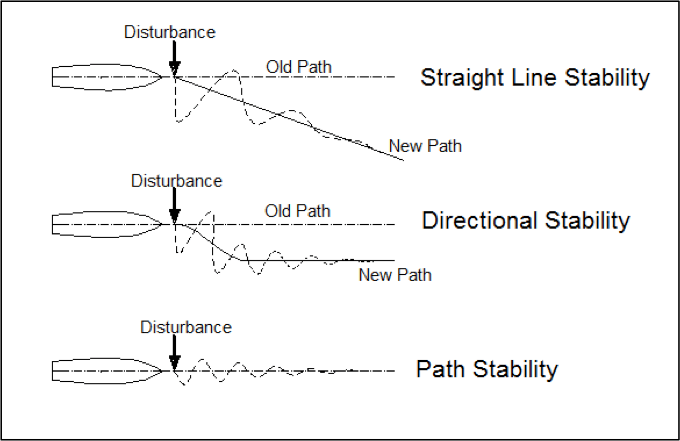
The design goal during the development of a ship’s hull, is, therefore, to attain straight line stability. For this various tank, tests are carried out at model basins and the hydrodynamic coefficients are measured for the bare hull. These hydrodynamic coefficients are the characteristic properties of the hull’s course keeping abilities, and in case of unwanted results, changes in the hull’s shape or geometry are decided upon. For example, a skeg is often added to the hull in later stages of design to improve on its straight line stability, after the model basin test results are obtained.
Hull-Superstructure Interaction
It has been observed that the presence of a superstructure on the main deck reduces the bending stress at the deck from the stress value predicted by the beam bending theory. This is because of the interaction of the shear stresses with the bending stress at the ends of the superstructures. However, this leads to deformations at the superstructure ends. So, in other words, if a superstructure is an efficient one, is must be able to absorb a certain portion of the bending stress at the deck. The extent to which it takes up the bending stress determines its efficiency, which comes designers prefer to call Superstructure Efficiency. It can be expressed as:

It depends on the designer whether to design a superstructure that would take up the bending stress from the hull, or whether to design one that is free from any interaction with the hull. Designing a 100 percent efficient superstructure would be possible, but would come at the cost of heavy weight deep bulkheads at the superstructure ends to prevent severe distortions due to shear. However, to increase the superstructure efficiency, most ships have superstructures connected to the hull by means of bulkheads transverse bulkheads under the deck, and webs that run continuously from the hull to the superstructures at its forward and aft ends.
Other Aspects of a Ship’s Hull Design
There are other aspects of a ship’s hull that play a major role in the performance of the ship at sea. Calculation of bare hull resistance is an important step in determining the energy efficiency of the hull. Methods to calculate the bare hull resistance have been discussed in detail in this article .
Another vital aspect of the ship’s hull is its watertight integrity. To ensure this, the designer must ensure the intact and damaged stability of the ship. To know about the stability aspects of a ship’s hull, you are advised to read the articles on intact stability and damaged stability of a ship. The article on subdivision of a ship’s hull discusses how the number and position of watertight bulkheads are decided during the design of a ship’s hull.
Vibration and dynamic response of the ship’s hull is a factor that determines not only the performance of the ship but also its longevity at sea. Out of all the different vibrations on a ship, vibration of a ship’s hull girder is of major concern. A ship with unwanted levels of vibration could possibly be a scrapped project right in its initial years. Read this article to know more about the types of vibrations on a ship’s hull, the sources of excitation, and design measures taken to minimize the level of hull vibrations on board.
Disclaimer: The authors’ views expressed in this article do not necessarily reflect the views of Marine Insight. Data and charts, if used, in the article have been sourced from available information and have not been authenticated by any statutory authority. The author and Marine Insight do not claim it to be accurate nor accept any responsibility for the same. The views constitute only the opinions and do not constitute any guidelines or recommendation on any course of action to be followed by the reader.
The article or images cannot be reproduced, copied, shared or used in any form without the permission of the author and Marine Insight.

Safer ships, Cleaner Oceans – Hull Protection Systems – Vol 13
- Introduced based on the fact that there is a changing trend in the way books are read today.
- For marine engineers
- Pay by Credit Card/Debit Card/Net Banking
- Read Instantly
- Guaranteed For 30 Days
Disclaimer : The information contained in this website is for general information purposes only. While we endeavour to keep the information up to date and correct, we make no representations or warranties of any kind, express or implied, about the completeness, accuracy, reliability, suitability or availability with respect to the website or the information, products, services, or related graphics contained on the website for any purpose. Any reliance you place on such information is therefore strictly at your own risk.
In no event will we be liable for any loss or damage including without limitation, indirect or consequential loss or damage, or any loss or damage whatsoever arising from loss of data or profits arising out of, or in connection with, the use of this website.

Do you have info to share with us ? Suggest a correction

About Author
Soumya is pursuing Naval Architecture and Ocean Engineering at IMU, Visakhapatnam, India. Passionate about marine design, he believes in the importance of sharing maritime technical knowhow among industry personnel and students. He is also the Co-Founder and Editor-in-Chief of Learn Ship Design- A Student Initiative.
Read More Articles By This Author >
Daily Maritime News, Straight To Your Inbox
Sign Up To Get Daily Newsletters
Join over 60k+ people who read our daily newsletters
By subscribing, you agree to our Privacy Policy and may receive occasional deal communications; you can unsubscribe anytime.

BE THE FIRST TO COMMENT
10 comments.
What is the ship’s six degree of rotations ? Please explain with graphical representation.
Explain about Ship’s Six degree of rotation with graphical representation.
same as an aircraft (it’s easier to find graphical representations). Roll (port-starboard lean), pitch (fore-aft vertical movement), yaw (port-starboard turn, or horizontal movement)
Dear Sir I’m QA Engineer trying to organize PPT Presentation for New QC Team joined our Shipyard to familiarize with various ships/vessels and platforms Hull and main components. Appreciate if you can lend your help.
Thanks Ganesan Singapore
Representing the ship’s body in a system of immobile coordinates (Oxyz), exist 6 degree of liberty, in witch the vessel will move only in flotation stage, as follow: a)- 3 translation moves on the axis X;Y;Z, b)- 3 rotation moves on the axis X;Y;Z, noted as (x); (y) and (z). Considering movements (X);(Y) and (Z), observe that vessel is in indifferent equilibrium, because: – around axis (Z) is vertical move which represent medium draught variation, and a rotation move which represent the ship’s gyration; situation of stable equilibrium; -around axis (X) and (Y) are manifesting the pitching and rolling moves, when the ship is in unstable equilibrium.
For the students of the first year of teaching? Too narrow point of view///^(
Hi sir. I need resources for research about fore and aft bodies plane. Could you help me please? Thanks Mehrdad Iran
Hi could you please update the figure 5 replacing the right picture title with “body plan” instead of “half breath plan”. Thanks.
frame numbering of structure how to name aft of aftwe-perpendiculer
Thank you Sir for sharing your quite obvious passion of ships.
Leave a Reply
Your email address will not be published. Required fields are marked *
Subscribe to Marine Insight Daily Newsletter
" * " indicates required fields
Marine Engineering
Marine Engine Air Compressor Marine Boiler Oily Water Separator Marine Electrical Ship Generator Ship Stabilizer
Nautical Science
Mooring Bridge Watchkeeping Ship Manoeuvring Nautical Charts Anchoring Nautical Equipment Shipboard Guidelines
Explore
Free Maritime eBooks Premium Maritime eBooks Marine Safety Financial Planning Marine Careers Maritime Law Ship Dry Dock
Shipping News Maritime Reports Videos Maritime Piracy Offshore Safety Of Life At Sea (SOLAS) MARPOL
WAIT! Did You Download 13 FREE Maritime eBooks?
Sign-up and download instantly!
We respect your privacy and take protecting it very seriously. No spam!
The Illustrated Guide To Boat Hull Types (11 Examples)
I didn't understand anything about boat hull types. So I've researched what hulls I need for different conditions. Here's a complete list of the most common hulls.
What are the different boat hull types? There are three boat hull categories: displacement hulls, which displace water when moving; planing hulls, which create lift at high speeds; and semi-displacement hulls, which displace water and generate lift at low speeds. The most common hull types are round-bottomed, flat-bottomed, multi, V-shaped, and pontoon hulls.
But that's all pretty abstract if you ask me, so below I'll give a simple overview of what it all means. After that, I'll give a list with pictures of all the different designs.
A Simple Overview of Boat Hull Types
Your boat hull will be the biggest factor in how your boat handles or sails, how wet it is, how bumpy - absolutely everything is determined by the hull shape. So it's important to understand what different hulls will do for you, and what each hull is best for. First, let's slice it up into rough categories.
Roughly, you can divide boat hulls into three categories:
- Displacement hulls - Lie inside the water and push it away when they move
- Planing hulls - Lie on top of the water and don't push it away
- Semi-displacement hulls - Lie inside the water and push it away, but can generate lift
Everything I'll be mentioning below is one of those three, or something in between.
There are five common boat hull types:
- Round-bottomed hulls - handle well in rough water: sailboats
- Flat-bottomed hulls - very stable for calm inland waters: fishing boats
- Multihulls - very stable and buoyant: catamarans
- V-Shaped Hulls - fast and comfortable in chop: powerboats
- Pontoon hulls - fast and stable: pontoon boats
And then there's everything in-between.
Here's a quick and handy overview of the different hull types
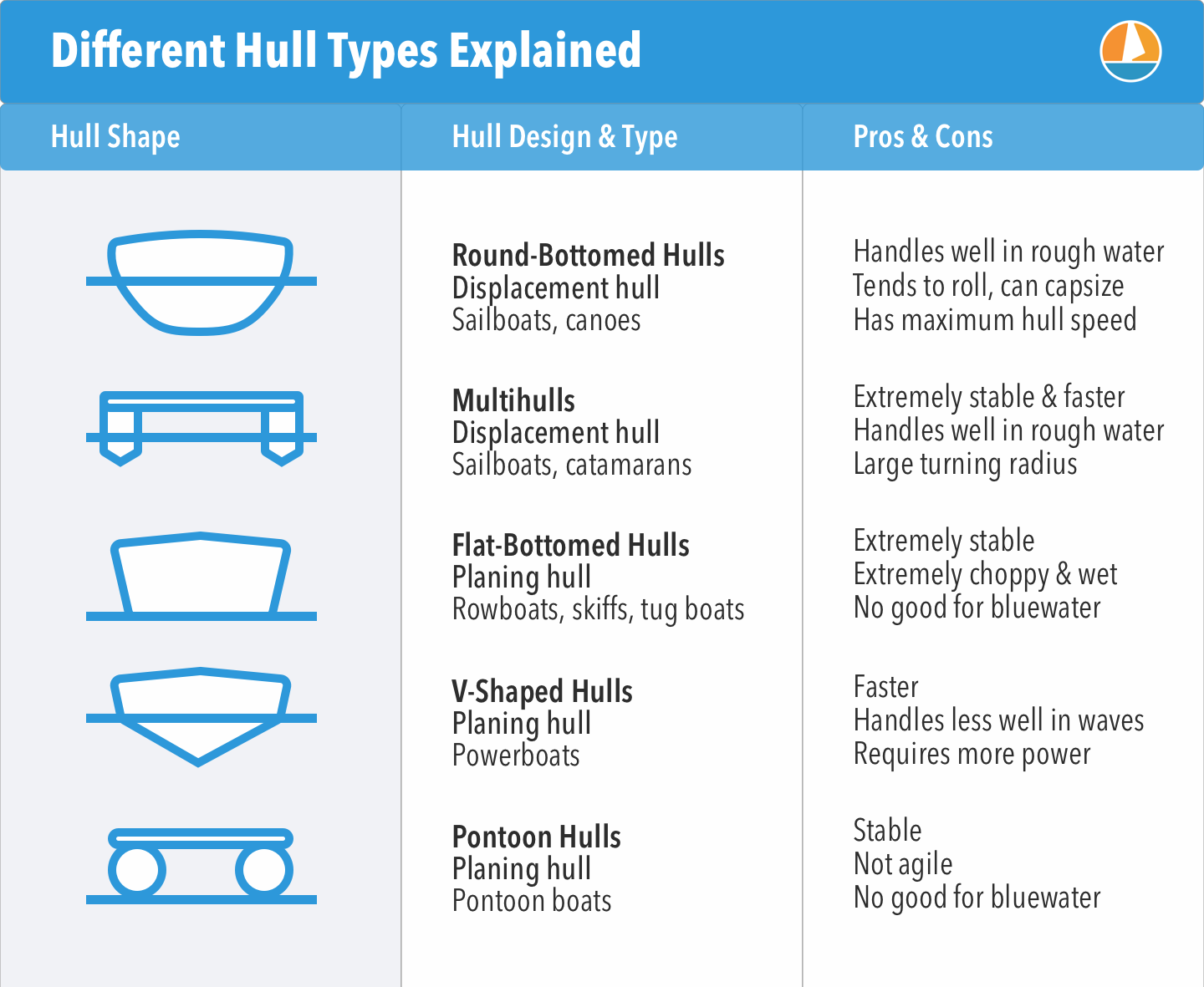
In each category, we find different designs and styles that have different characteristics. There isn't a real clear distinction between categories and styles: there are semi-displacement hulls and so on. So I thought the best way to learn you the different hull types is by simply creating a list with lots of pictures, instead of getting all theoretical about it.
So below I've listed all the different hull styles I could possibly think of, mention what category and type it is, the pros and cons of each one, and give you examples and illustrations for each one.

On this page:
Displacement hulls, round-bottom hull, catamaran hull, trimaran hull, planing hulls, flat-bottom hull, deep v-hull, modified-v hull, stepped hull, pontoon hull, semi-displacement hulls.
Examples: Sailboats, trawlers, fishing boats
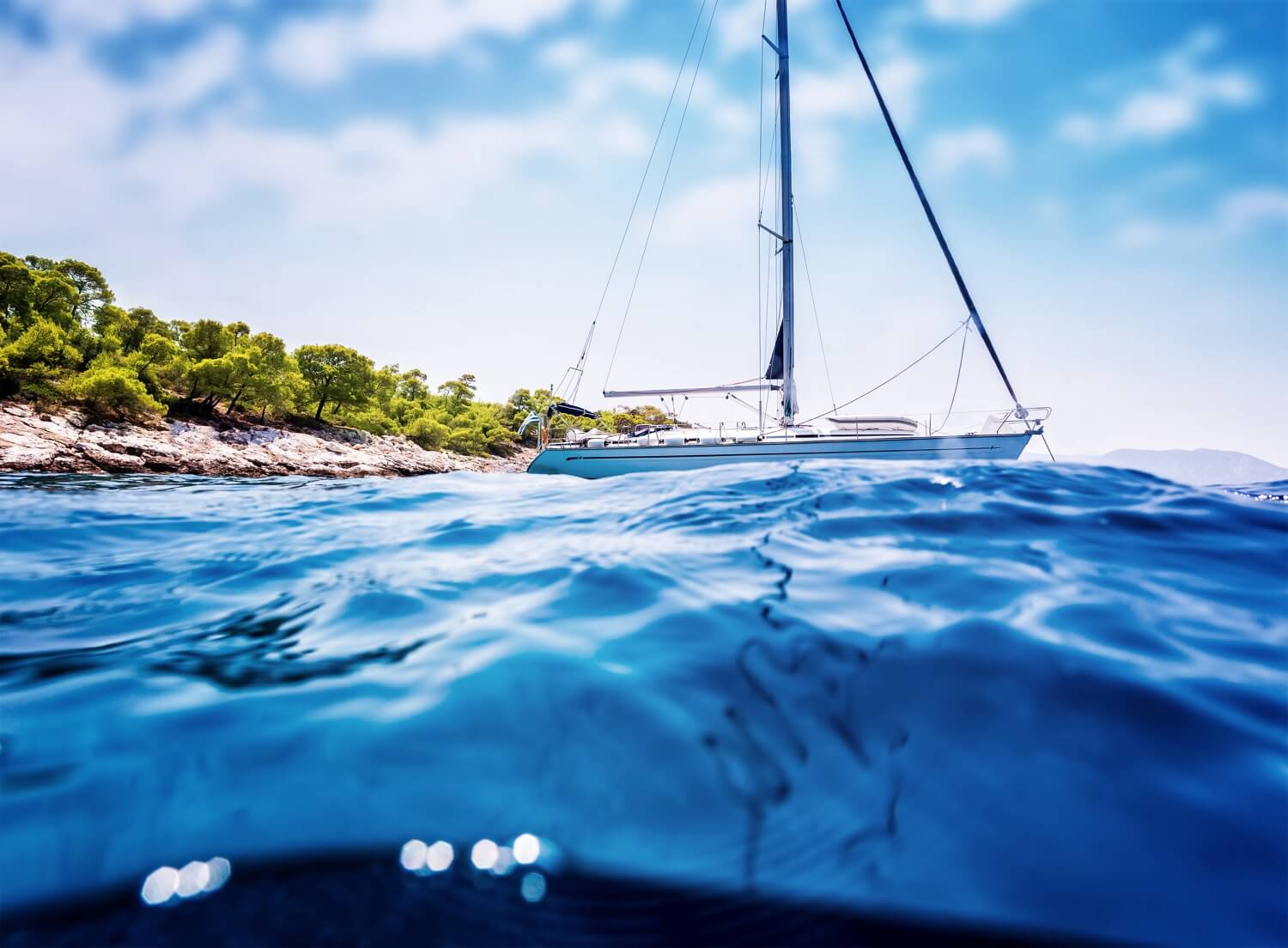
Displacement hulls displace water when moving. These hulls lie in the water, instead of on top of it. The amount of water they displace is equal to the boat's weight. Displacement hulls handle way better in rough waters than flat-bottom hulls. That's why most cruisers have some sort of displacement hulls. There are actually all kinds, shapes, and forms of the displacement hull design, which we'll go over later.
The most important thing to understand about the displacement hull, is that it operates on buoyancy. This means that most of the boat's weight is supported by its capacity to float . Planing hulls, on the other hand, operate on lift instead, but we'll dive into that later.
Sailboats typically have displacement hulls, but also fishing boats, trawlers and crabbers. All in all, it's used for each boat that needs to handle well in rough conditions.
Learn everything there is to know about displacement hulls in this article . It lists all the pros and cons and really goes into detail on the nitty-gritty about how displacement hulls actually work .
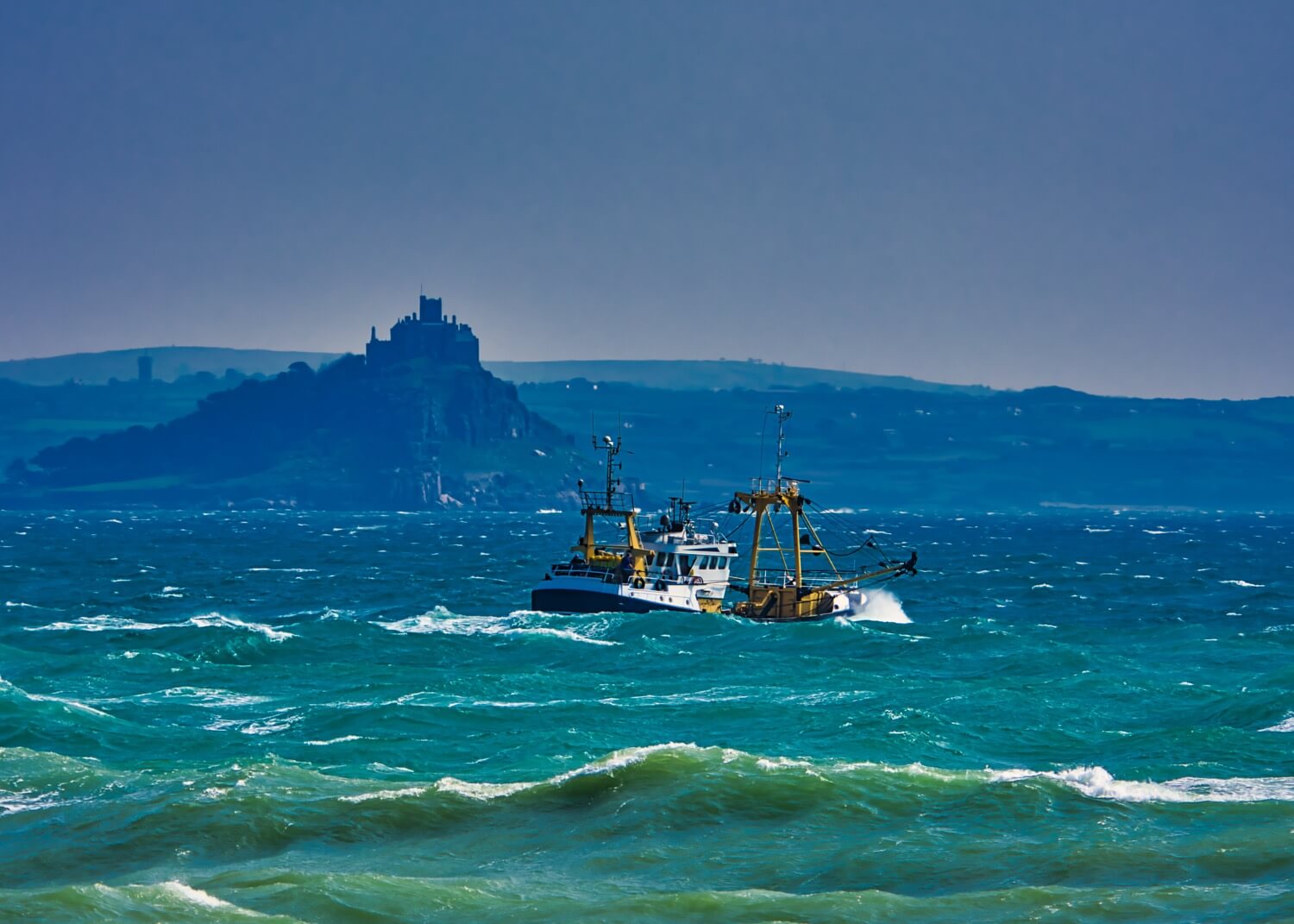
But they are also slower than flat and planing hulls because the boat creates more resistance when moving. It has to push the water aside. In fact, this type of hull has a built-in upper-speed limit.
This upper-speed limit is called maximum hull speed . It means that the length of a displacement hull directly determines the maximum speed. It can't go faster, because the water-resistance increases with the boat's speed. To learn everything about calculating maximum hull speed , please check out my previous article here.
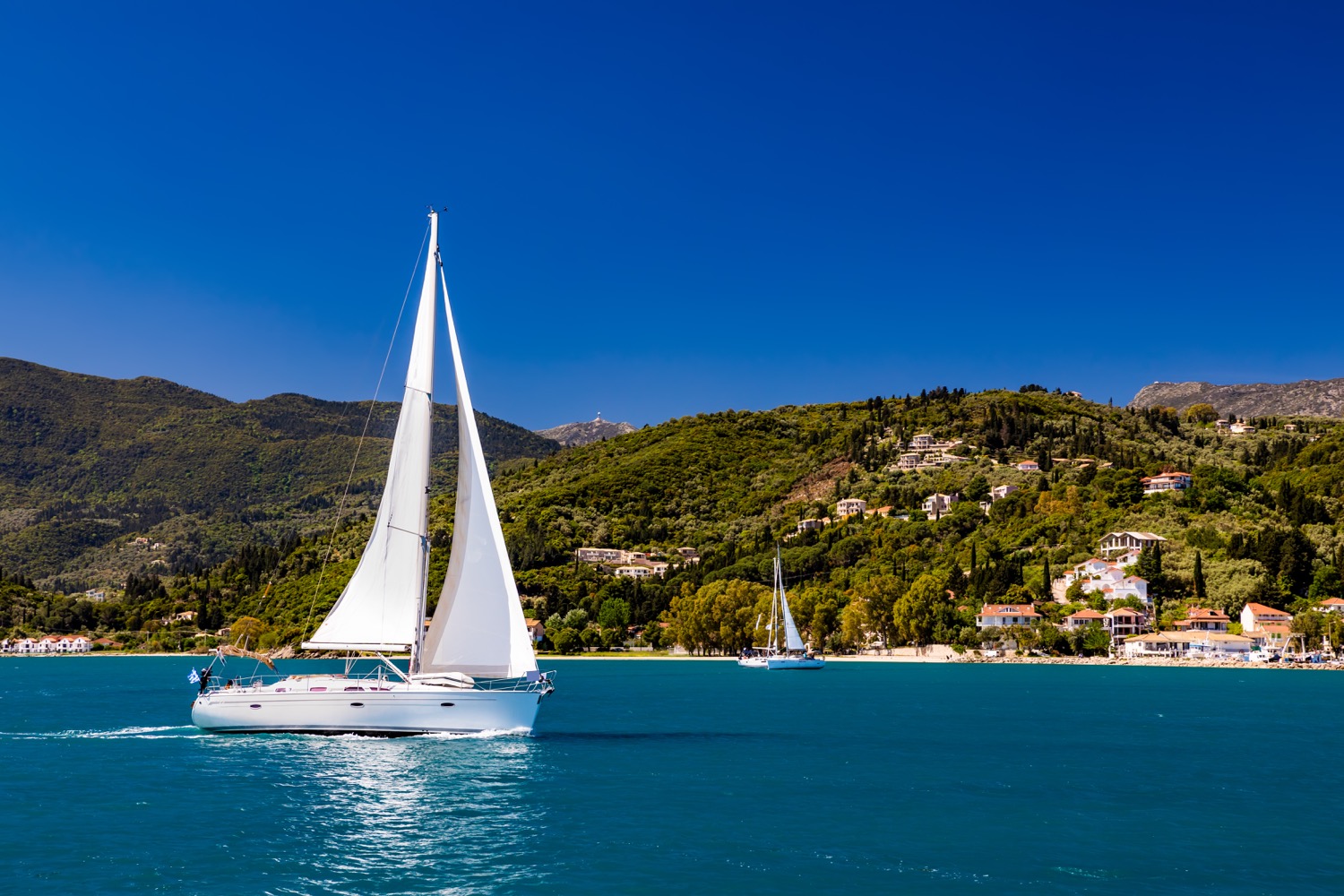
A round-bottomed hull is a type of displacement hull - it lies in the water and has to power through it. But since it's rounded, it creates little resistance and is effortless to move through the water. It's a very smooth ride and typical for any sailboat that sort of glides through the waves. In contrast, powerboats really have to eat their way through the water.
Examples: Canoes, sailboats
They are also one of the least stable. Since the bottom is rounded, your boat or canoe will rock plenty when boarding or moving around. They are also easy to capsize. That's why pro canoers learn to do a 360 in their canoes. I've never did a roll myself but came close enough a couple of times.
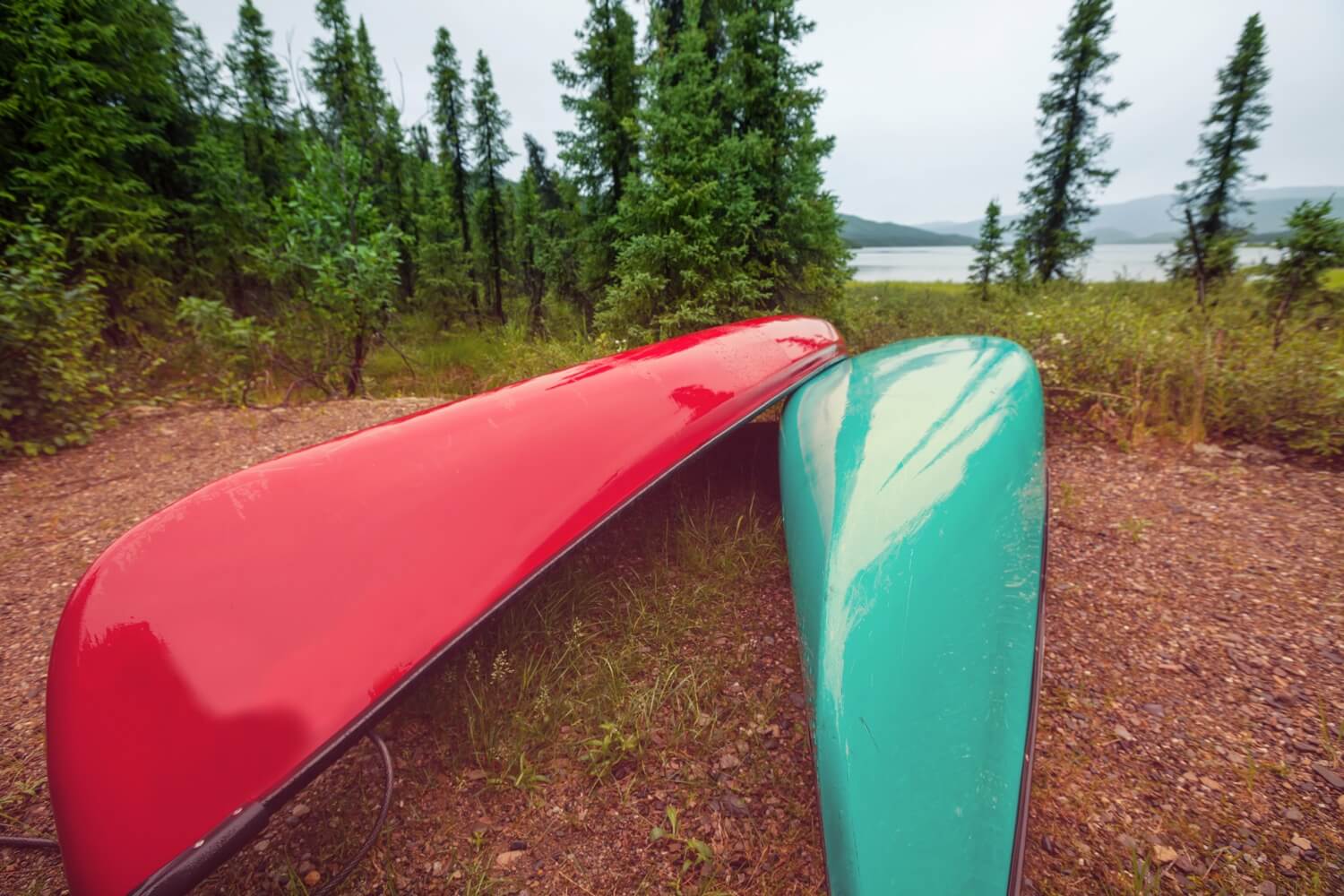
Almost all sailboats use a round bilge as well. This provides it its buoyancy and makes sure it handles well in waves. But since a rounded bilge is easy to capsize, a lot of sailboats have some sort of keel, which stabilizes the roll.
Nearly all ocean-going vessels use some sort of displacement hull, and the round bottom is the most common one. But our next guest is very popular as well.
The catamaran is similar to the pontoon hull (read on to learn more on that one), but it is a displacement multihull instead of a planing one. So it has two hulls, that lie inside the water and displace it. Like the pontoon, you will have to try really hard to capsize this design (and it won't work).
Examples: well, catamaran sailboats. But also this cool catamaran trawler:
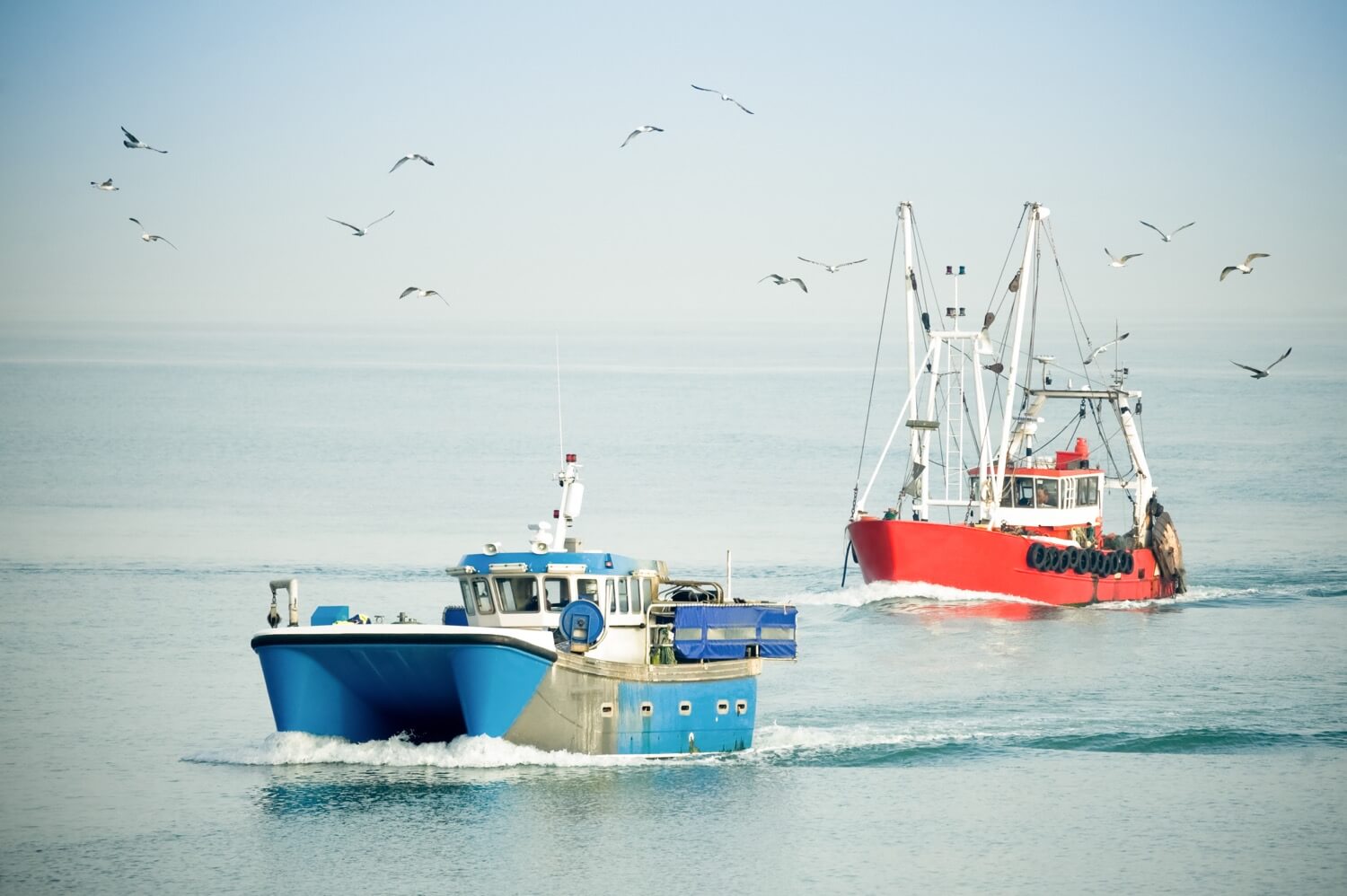
Catamarans are extremely popular ocean cruisers. Their biggest pro is their extreme stability and buoyancy. And they have a very shallow draft for a displacement hull, making them very popular for sailing reefs and shallow waters, like the Caribbean.
Some cons for the catamaran are less agile than monohulls. They have a large turning radius, making them less maneuverable. Also, expect to pay high marina fees with this one.
Speaking of marina fees, our next one can go either way.
I think trimarans are incredibly cool, and especially the second type.
There are two types of trimarans:
- a catamaran with three hulls instead of two,
- or a displacement monohull with two floaters.
The first has the same characteristics as the catamaran: it's a displacement multihull, but now with three hulls:

The second can be a regular displacement monohull, with two pontoon-type floaters that provide extra buoyancy, making the total thing a hybrid between pontoon and displacement:
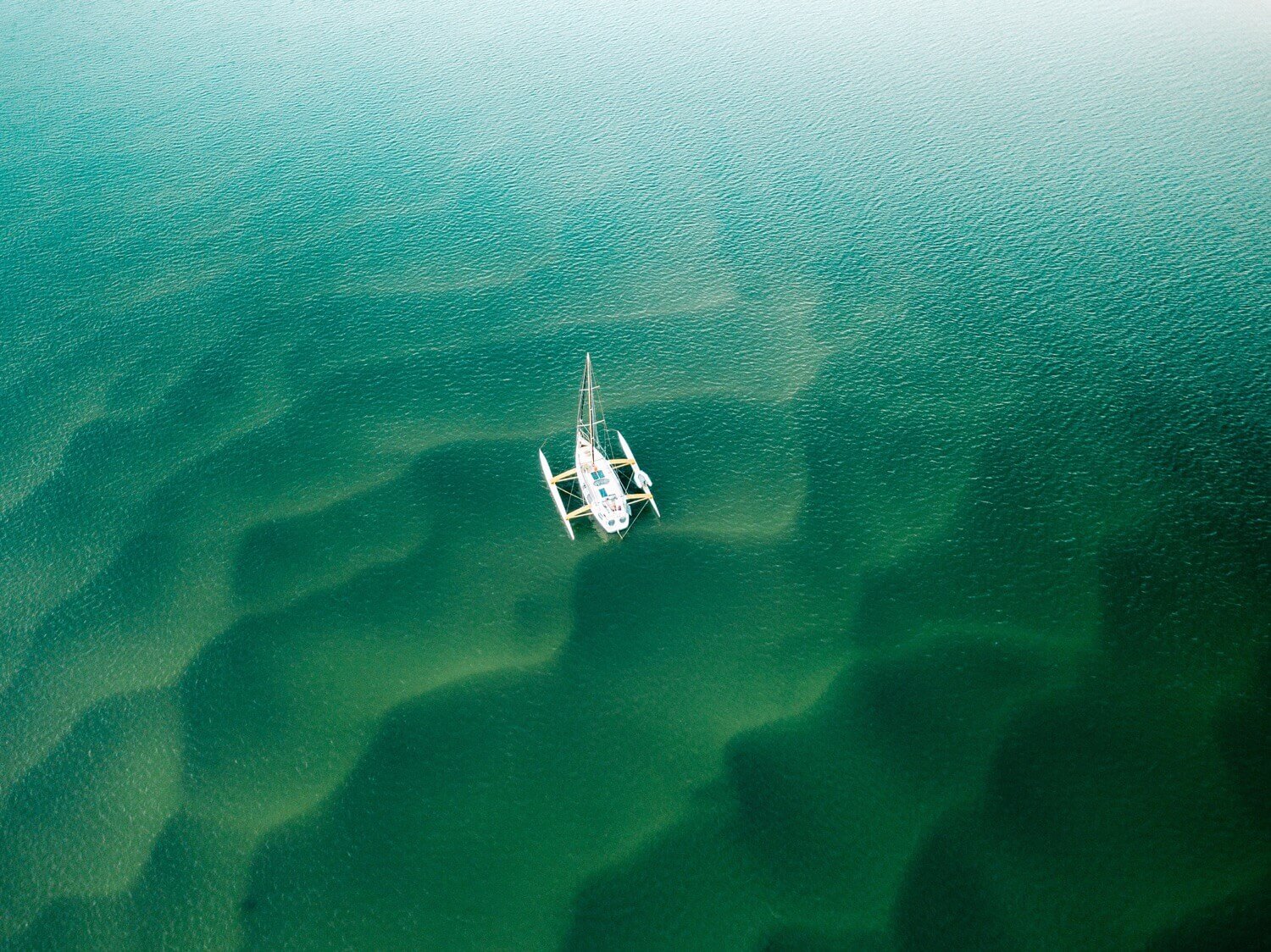
This last one has all the pros of a catamaran in terms of stability, but: you can simply wheel in those floaters whenever you head for port. That saves you a lot of money. And you can trailer her! Imagine that, a towing a trimaran home.
So those were the most common displacement hulls, aka what lives in the water. Let's move on to the planing hulls, aka what lives on the water.
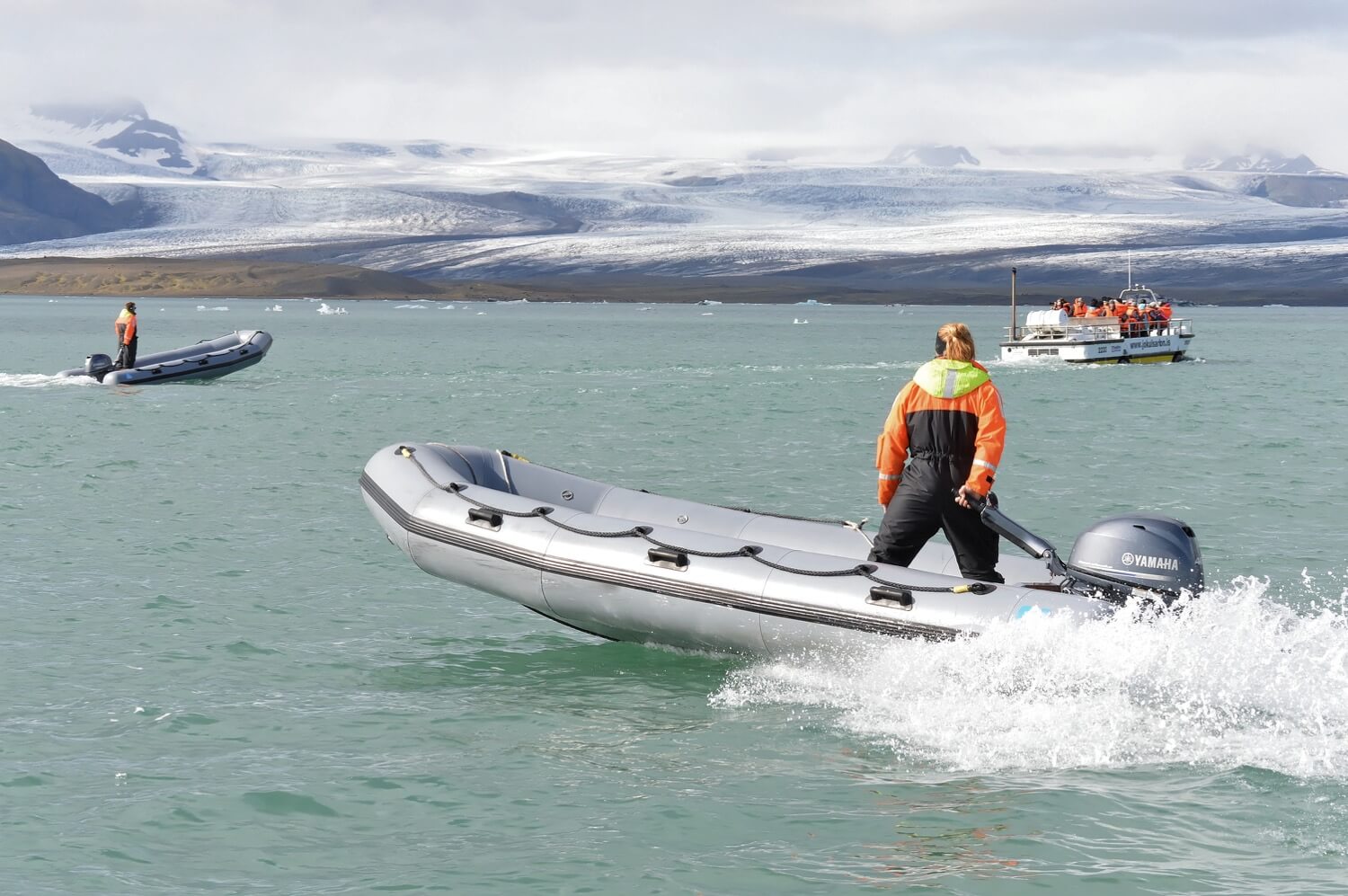
Planing hulls are a hybrid between the flat-bottom and displacement hulls. Planing hulls displace water at low speeds , but create lift at higher speeds . The shape of their hull + speed lifts them out of the water, making them glide on top of the water. Most powerboats look like flat-bottom boats but use a shallow V-shape that helps the boat to handle better at higher speeds.
Examples: Water sports boat, powerboats
The most important thing to understand about planing hulls is that they operate mainly on lift instead of buoyancy. This means the weight of the boat is mainly supported by dynamic forces 1 . With the right amount of power, this design generates lift, which results in less resistance. This is why they are a lot faster than boats with displacement hulls, but also a lot rougher, even with mild chop.
A lot of powerboats use some sort of planing hull. Again, there are many designs and variations on the planing hull, and I'll try to mention as many as I can below.
Because the wedge of the hull runs into the water, it is much easier to handle at high speeds. At lower speeds, it is able to keep its course, even with a bit of wind. However, whenever the boat starts planing, it is prone to wind gusts, since the wedge shape no longer stabilizes the boat.
The flatter the hull, the faster it will go, but also the more poorly it will handle. Other powerboats use deep V-hulls, which I'll discuss below. But first, let's take a look at the flattest hulls you'll ever see.
A flat-bottom hull lies on top of the water and doesn't displace water (okay, very little) as it moves. Since there is no displacement, there is also little to no friction when moving. This makes it potentially fast, but it handles pretty poorly. It is one of the most stable hull design.
Examples: rowboats, (old) high-performance powerboats, small skiffs, small fishing boats, tug boats
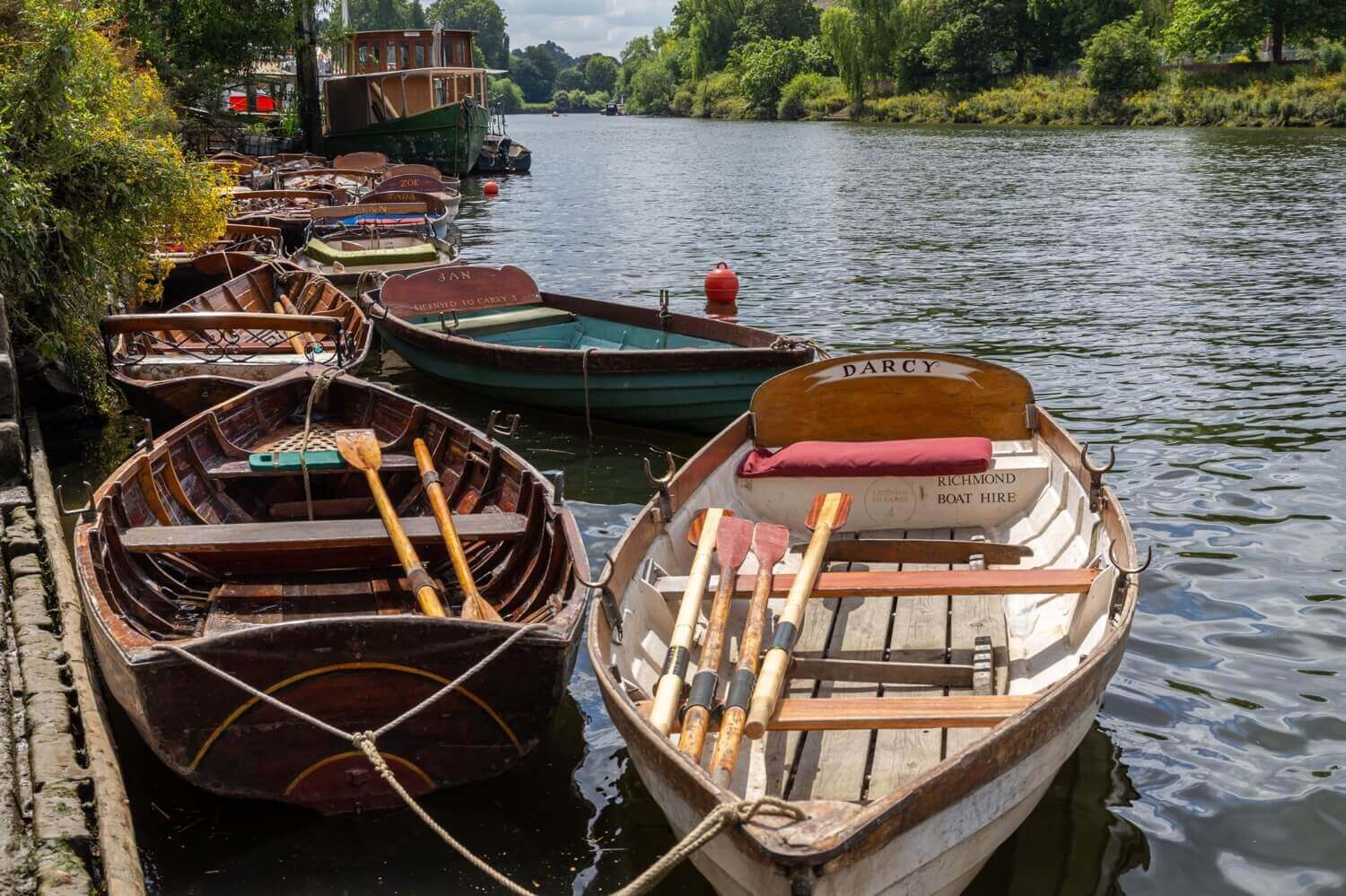
They aren't just incredibly stable, they're also very practical. Because the bottom is practically flat, they maximize boat surface. But they are also extremely choppy in rough weather and waves. They will handle very poorly with stiff winds, as the wind can simply catch them and blow them across the water surface. That's why this design is almost exclusively used for calm, small, inland waters.
This type of hull operates mainly on buoyancy , like the displacement hull, but it doesn't require the same amount of power to propel, which is why it's faster.
Because of the uncomfortable ride, not a lot of boats use a perfectly flat bottom. Most boats nowadays use some sort of v-hull or hybrid design, like a semi-displacement hull; especially larger boats. So not a lot of boats have a real flat bottom. However, we do call a lot of boats flat-bottomed. How come?
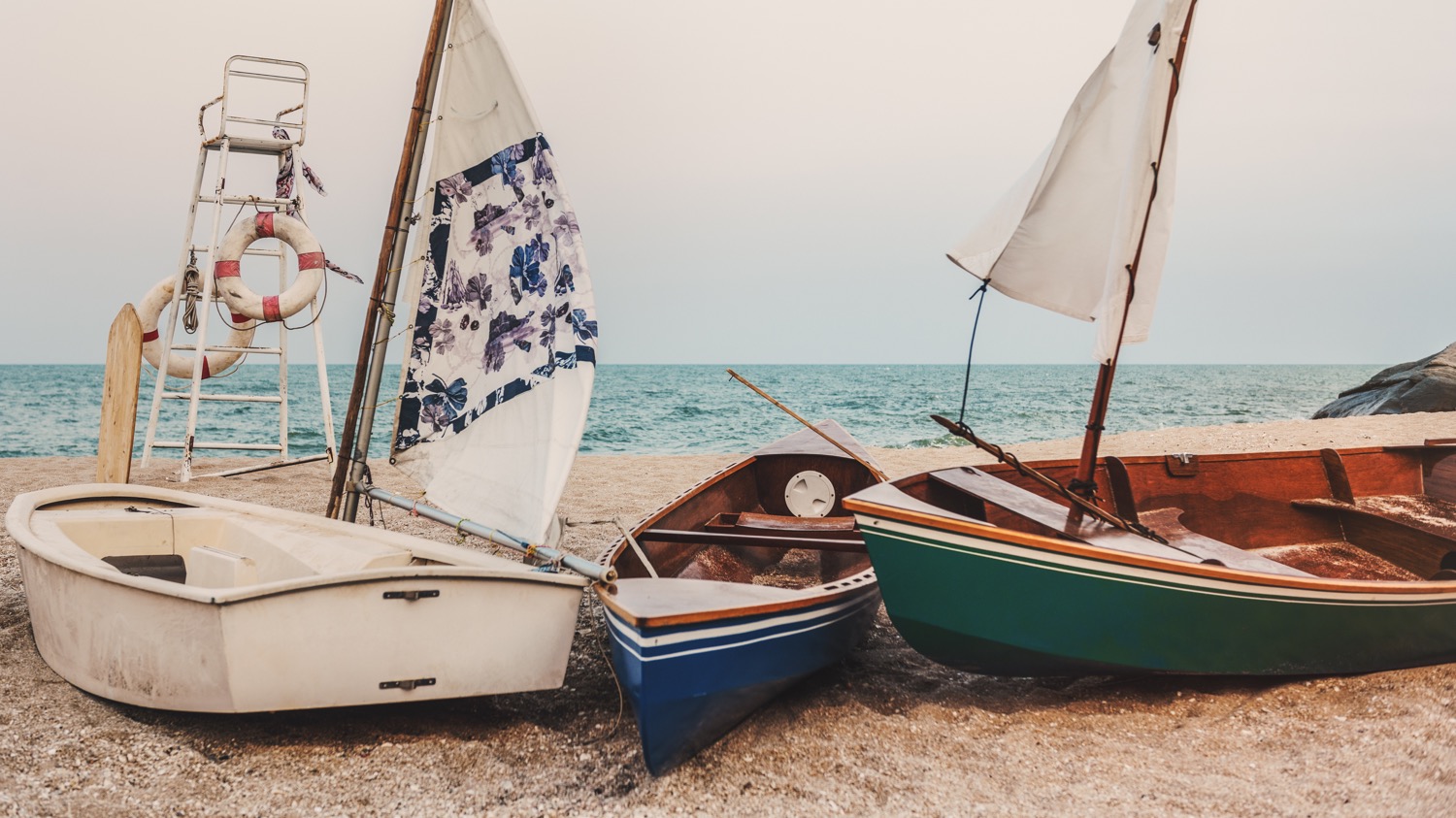
There are two types of hulls we call flat-bottoms:
- Of course boats with an actual flat bottom
- Boats with almost no deadrise
What is the hull's deadrise? The deadrise is the angle of the front of the hull to the horizontal waterline.
As you can see, the green sailing dinghy in the picture above has a deadrise that's barely noticeable.
Let's move on to other variations of the planing hull. One of the most popular hull design for modern-day powerboats is the Deep Vee hull. And that's as cool as it sounds.
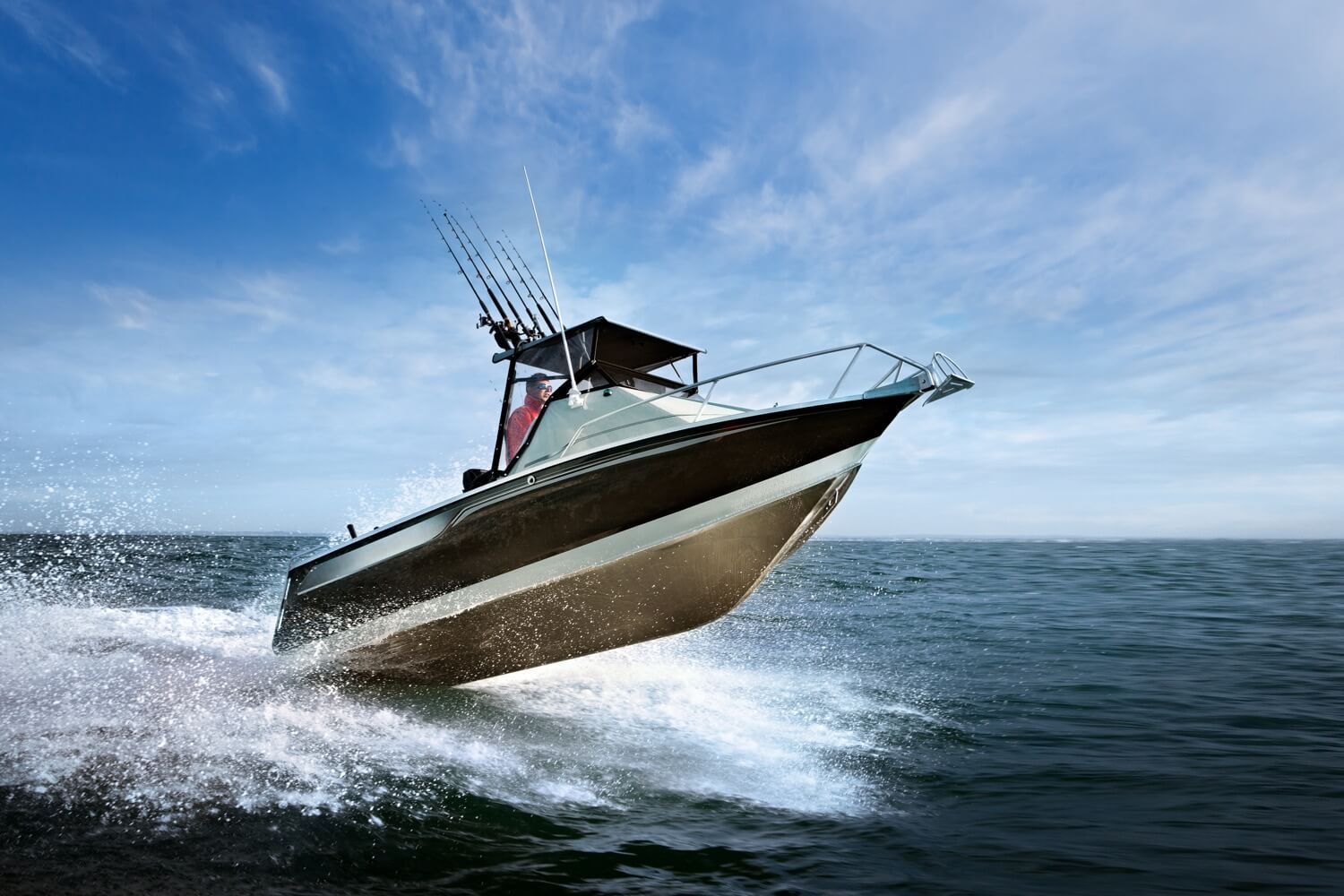
This is a type of planing hull that combines the best of both worlds.
These types of hulls are very popular on modern-day powerboats, and no wonder. With a V-shape that runs from bow to stern, deep into the water, you can handle this boat even in offshore conditions. It handles a lot better than flat-bottomed hulls, while it's at the same time extremely fast.
Examples: Most modern powerboats.
The Deep V-shape acts as a tiny keel of sorts, stabilizing the boat and making it more reliable and maneuverable. The rest of the hull acts as a planing hull, giving the boat its fast edge. Even at high speeds, the Deep V will cut into the water, making it more handleable.
The deep-V design is just one of many variants on the V-hull. Below we'll talk over another, the modified V hull.
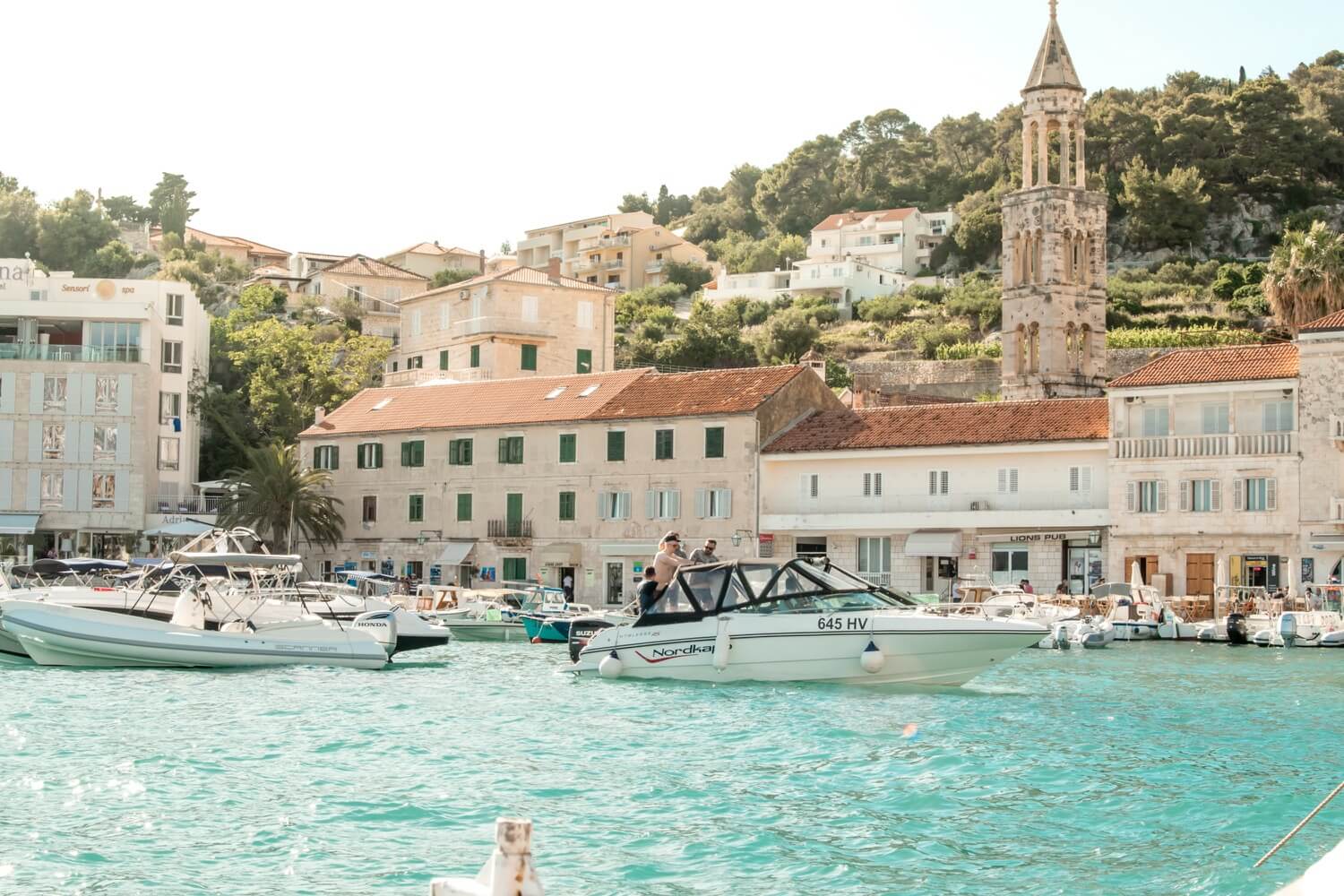
The modified V hull is the ultimate crossover of all planing hull types. It's a mix of the flat-bottom and Deep V hull. It is one of the most popular hull designs for small motorboats. It's flat in the back and then runs into a narrow V-shape to the front. The flat back makes it more stable, and adds a little speed, while the V-shape front ensures good handling.
It is, in short, kind of the compromise-family-sedan of boat hulls. It's the fastest design that's also stable, that's also safe, and that also handles well. But it's not the best in any of those things.
Most powerboats you've seen will have some sort of Vee or Modified-V hull.
Stepped hulls are used on high-performance powerboats. It's a type of planing hull that reduces the hull surface by adding steps, or indents in the hull below the waterline. It looks something like this:
It is said to work extremely well at high speed (60 knots and up) and adds up to 10 knots to your top speed.
On to our next design. There are also planing multihulls, and they might even look like catamarans to you. Meet the pontoon hull.
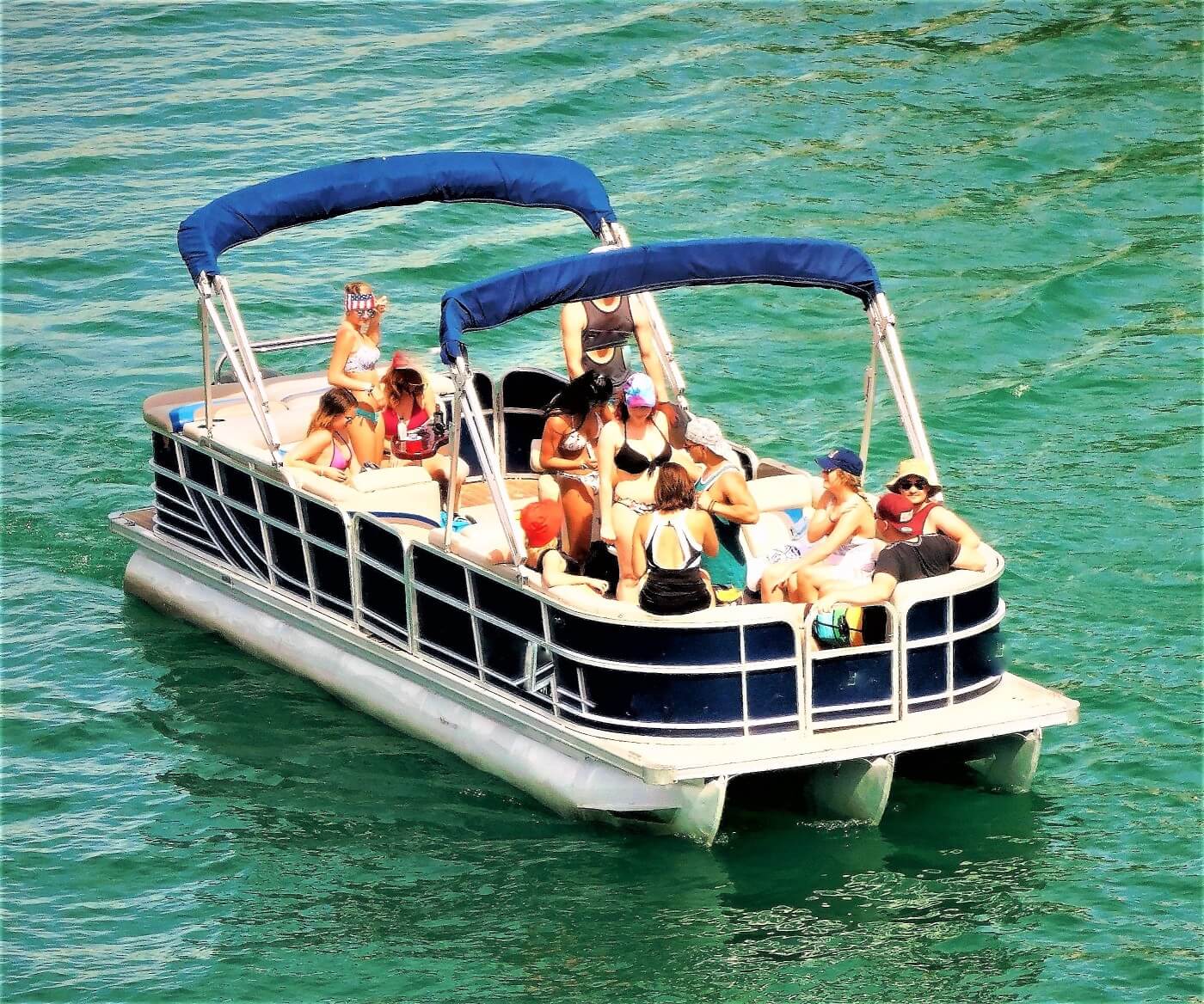
Pontoon hulls float on top of the water using pontoons or floaters that create lift. It's a type of planing multihull that doesn't lie in the water, so it doesn't displace a lot of water. They don't really handle well. As with any multihull, they aren't agile - they're not great at maneuvering. They also have a very large turning radius. But they are extremely stable: there's no chance you'll capsize this.
Examples: Cruisers, modern trawlers, motor yachts, Maine lobster boats
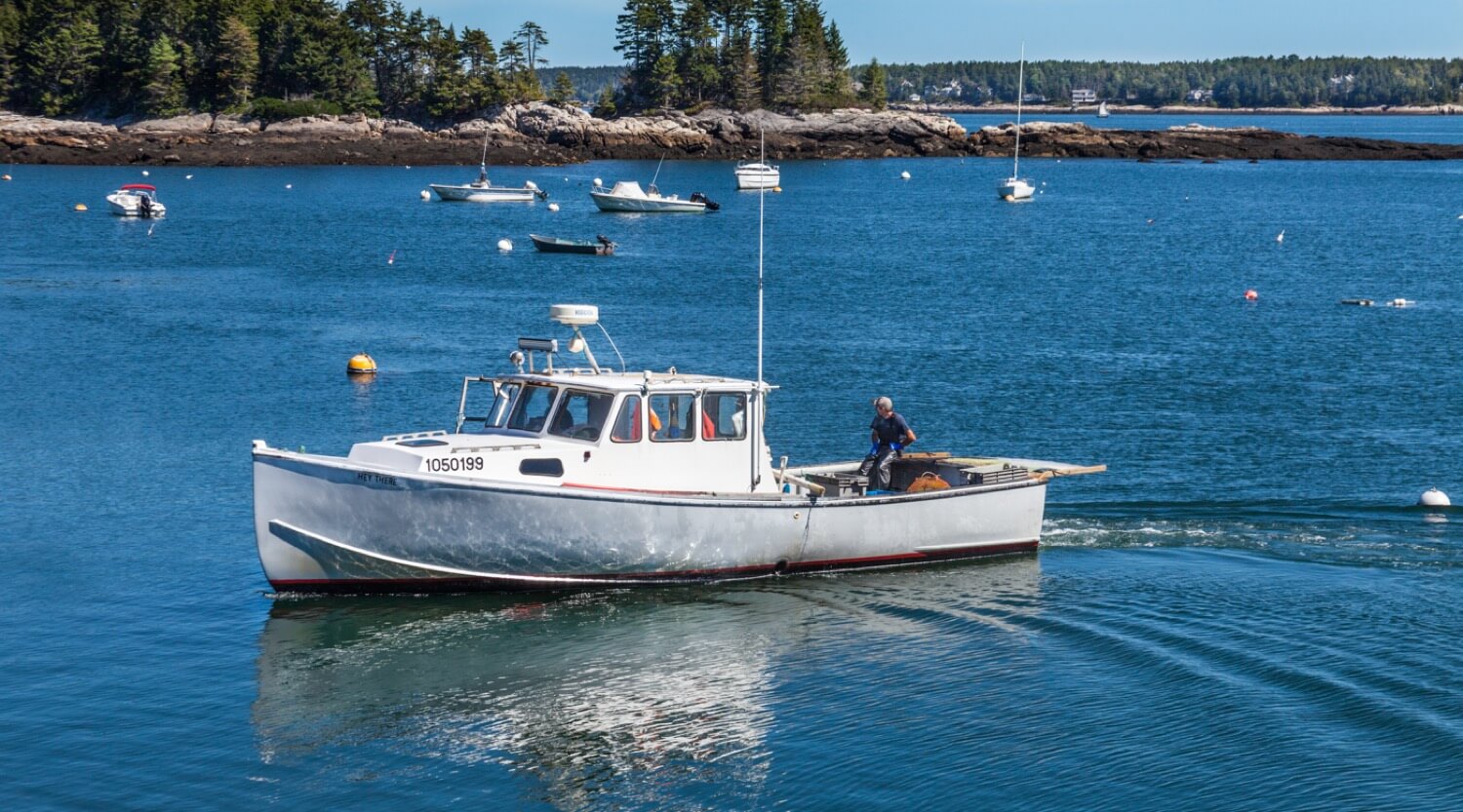
Semi-displacement hulls are smack bang in the center of planning and displacement hulls. They are a bit better for speed than displacement hulls are. They are a bit better for handling rough waters than planing hulls are. This makes them very versatile.
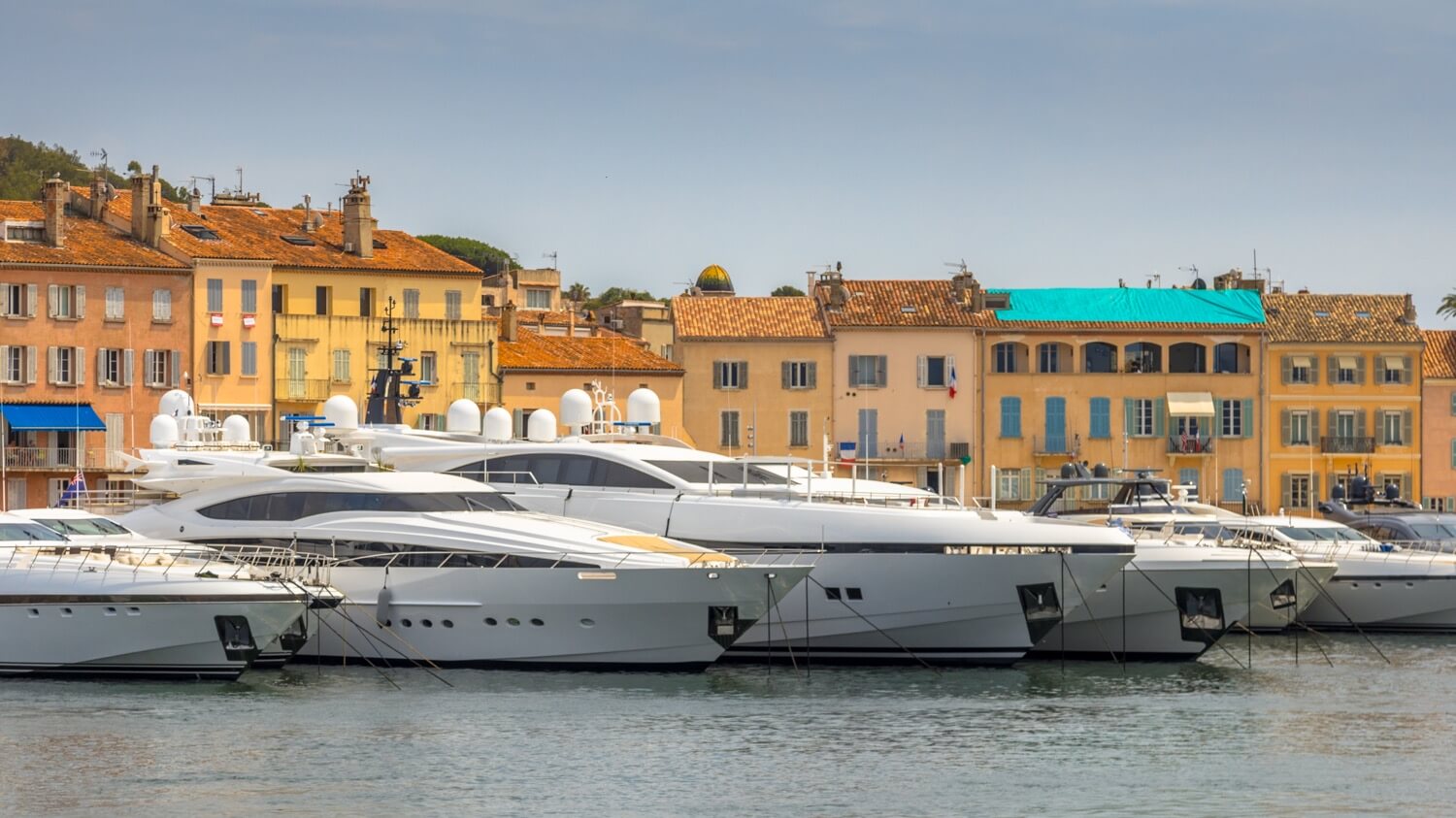
You can see these a bit like being 'half-planing' hulls. These hulls are designed to plane at lower speeds than normal planing hulls - somewhere in the range of 15 - 20 knots, depending on the length of the boat. It also requires less power. When the hull lifts, it reduces drag (water resistance), making it faster and more efficient.
Semi-displacement hulls are perfect for boats that need to be steady and seaworthy but fast at the same time.
For more information about semi-displacement hulls, please check out my in-depth guide to semi-displacement hulls here . It has a diagram and lists all the pros and cons.
So those were my 11 examples, and my step by step explanation of the different types of boat hulls and functions. You now have a solid basic understanding of boat hulls, and can recognize the most common ones. I hope it was helpful, and if you want more good sailing information, be sure to check out my other articles below.
https://www.soundingsonline.com/boats/how-different-hull-types-react-in-rough-water . ↩
I was wondering what your opinion would be on the ship uss Texas as far as hull type and bow type. I think it has a plumb bow and it looks to have a displacement or flat bottom hull. Im doing some research and a better trained eye would be of great help. I used images “bb-35 dry dock” to help see the hull shape. Thank you
Shawn Buckles
Hi Kirk, I don’t know about trained but here we go. I’ve checked the picture, it’s definitely a displacement hull I’d also say it’s a plumb bow.
Hahahahaa imagine liking boats hehehehehe Extremely stable & faster Handles well in rough water Extremely stable & faster Handles well in rough water Extremely stable & faster Handles well in rough water Extremely stable & faster Handles well in rough water Extremely stable & faster Handles well in rough water Extremely stable & faster Handles well in rough water Extremely stable & faster Handles well in rough water Extremely stable & faster Handles well in rough water Extremely stable & faster Handles well in rough water
Leave a comment
You may also like, a complete guide to displacement hulls (illustrated).
The displacement hull is the classic go-to hull design for sailboats and one of the most recognizable ones out there. In this guide, I explain all there is to know …
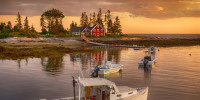
Semi-Displacement Hulls Explained (Illustrated Guide)

The Ultimate Guide to Sail Types and Rigs (with Pictures)
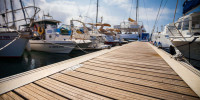
How Much Does it Cost to Dock a Boat for a Year?
Definitions
Length overall (LOA)
Length of water line (lwl)
Length between perpendiculars (LFF)
Rated length
he hull of a yacht is a complex three-dimensional shape, which cannot be defined by any simple mathematical expression. Gross features of the hull can be described by dimensional quantities such as length, beam and draft, or non-dimensional ones like prismatic coefficient or slenderness (length/displacement) ratio. For an accurate definition of the hull the traditional lines drawing; is still a common tool, although most professional yacht designers now take advantage of the rapid developments in CAD introduced in Chapter 1.
In this chapter we start by defining a number of quantities, frequently referred to in yachting literature, describing the general features of the yacht. Thereafter, we will explain the principles of the traditional drawing and the tools required to produce it. We recommend a certain work plan for the accurate production of the drawings and, finally, we show briefly how the hull lines are generated in a modern CAD program.
The list of definitions below includes the basic geometrical quantities used in defining a yacht hull. Many more quantities are used in general ship hydrodynamics, but they arc not usually referred to in the yachting field. A complete list may be found in the International Towing Tank Conference (ITTC) Dictionary of Ship Hydrodynamics.
The maximum length of the hull from the forwardmost point on the stem to the extreme after end (see Fig 3.1). According to common practice, spars or fittings, like bowsprits, pulpits etc are not included and neither is the rudder.
The length of the designed waterline (often referred to as the DWL).
This length is not much used in yachting but is quite important for ships. The forward perpendicular (FP) is the forward end of the designed waterline, while the aft perpendicular (AP) is the centre of the rudder stock.
The single most important parameter in any rating rule. Usually L is obtained by considering the fullness of the bow and stern sections in a more or less complex way.
The maximum beam of the hull excluding fittings, like rubbing strakes.

Fig 3.1 Definitions of the main dimensions
Beam of waterline (bwl)
Displacement
The maximum beam at the designed waterline.
The maximum draft of the yacht when floating on the designed waterline. Tc is the draft of the hull without the keel (the 'canoe' body).
The vertical distance from the deepest point of the keel to the sheer line (see below). Dc is without the keel.
Could be either mass displacement (m) ie the mass of the yacht, or volume displacement (V or V), the volume of the immersed part of the yacht. mc, Vc and Vc are the corresponding notations without the keel.
Midship section For ships, this section is located midway between the fore and aft perpendiculars. For yachts it is more common to put it midway between the fore and aft ends of the waterline. The area of the midship section (submerged part) is denoted AM, with an index 'c' indicating that the keel is not included.
Maximum area section For yachts the maximum area section is usually located behind the midship section. Its area is denoted Ax (AXc).
Prismatic coefficient This is the ratio of the volume displacement and the maximum section (CP) area multiplied by the waterline length, ie CP = V/(AX • Lwl). This value is very much influenced by the keel and in most yacht applications only the canoe body is considered: CPc = Vc(AXc • Lwl). See Fig 3.2. The prismatic coefficient is representative of the fullness of the yacht. The

Circumscribed cylinder volume = v = L^ Ay
Fig 3.2 The prismatic coefficient

BOX WL WL c
Circumscribed box volume =
Fig 3.3 The block coefficient
Block coefficient ( CB)
Centre of buoyancy (B)
Centre of gravity (G)
Freeboard fuller the ends, the larger the Cp. Its optimum value depends on the speed, as explained in Chapter 5.
Although quite important in general ship hydrodynamics this coefficient is not so commonly used in yacht design . The volume displacement is now divided by the volume of a circumscribed block (only the canoe body value is of any relevance) CBc = V J(Lwl • BWL • Tc). See Fig 3.3.
The centre of gravity of the displaced volume of water, its longitudinal and vertical positions are denoted by LCB and VCB respectively.
The centre of gravity of the yacht must be on the same vertical line as the centre of buoyancy. In drawings G is often marked with a special symbol created by a circle and a cross. This is used also for marking geometric centres of gravity. See. for instance, Figs 5.27 or 8.2.
The intersection between the deck and the topside. Traditionally, the projection of this line on the symmetry plane is concave, the 'sheer* is positive. Zero and negative sheer may be found on some extreme racing yachts and powerboats.
The vertical distance between the sheer line and the waterline.
Tumble home
When the maximum beam is below the sheer line the upper part of the topsides will bend inwards (see Fig 3.4). To some extent this reduces the weight at deck level, but it also reduces the righting moment of the
Fig 3.4 Definition of tumble home and flare

Tumble home crew on the windward rail. Further, the hull becomes more vulnerable to outer skin damage in harbours.
Flare The opposite of tumble home. On the forebody in particular, the sections may bend outwards to reduce excessive pitching of the yacht and to keep it more dry when beating to windward.
Scale factor (a) This is not a geometrical parameter of the hull, but it is very important when designing a yacht. The scale factor is simply the ratio of a length (for instance the Lw,) at full scale to the corresponding length at model scale. Note that the ratio of corresponding areas (like the wetted area) is a2 and of corresponding volumes (like displacement) a3.
Lines drawing A complete lines drawing of the YD 40 is presented in Fig 3.5. The hull is shown in three views: the profile plan (top left), the body plan (top right) and half breadth plan (bottom). Note that the bow is to the right.
In principle, the hull can be defined by its intersection with two different families of planes, and these are usually taken as horizontal ones (waterlines) and vertical ones at right angles to the longitudinal axis of the hull (sections). While the number of waterlines is chosen rather arbitrarily, there are standard rules for the positioning of the sections. In yacht architecture the designed waterline is usually divided into ten equal parts and the corresponding sections are numbered from the forward perpendicular (section 0) backwards. At the ends, other equidistant sections, like # 11 and # 1 may be added, and to define rapid changes in the geometry, half or quarter sections may be introduced as well. In Fig 3.5 half sections are used throughout.
The profile is very important for the appearance of the yacht, showing the shapes of the bow and stern and the sheer line. When drawing the waterlines, displayed in the half breadth plan, it is most helpful if the lines end in a geometrically well defined way. Therefore a 'ghost" stem and a 'ghost' transom may be added. The ghost stem is the imagined sharp leading edge of the hull, which in practice often has a rounded stem, and the ghost transom is introduced because the real transom is often curved and inclined. If an imagined vertical transom is put near the real one at some convenient station, it will facilitate the fairing of the lines. The drawing of Fig 3.5 has been produced on a CAD system and no ghost stem is shown. However, a ghost transom is included.
In the body plan, the cross sections of the hull are displayed. Since the hull is usually symmetrical port and starboard, only one half needs to be shown, and this makes it possible to present the forebody to the right and the afterbody to the left. In this way mixing of the lines is avoided and the picture is clearer. Note that in the figure the half stations are drawn using thinner lines.
The above cuts through the hull are sufficient for defining the shape, but another two families of cuts are usually added, to aid in the visual perception of the body. Buttocks are introduced in the profile plan,

* * ^ "i * 2 § 2 II II II II II II II ll II
showing vertical, longitudinal cuts through the hull at positions indicated in the half breadth plan. The diagonals in the lower part of the half breadth plan are also quite important. They are obtained by cutting the hull longitudinally in different inclined planes, as indicated in the body plan. The planes should be as much as possible at right angles to the surface of the hull, thus representing its longitudinal smoothness. In practice, the flow tends to follow the diagonals, at least approximately, so that they are representative of the hull shape as "seen' by the water. Special attention should be paid to the after end of the diagonals, where knuckles, not noticcd in the other cuts, may be found, particularly on lOR yachts from the 1970s and the 1980s. Almost certainly, such unevenncss increases the resistance and reduces the speed of the yacht.
The other line in the lower part of the half breadth plan is the curve of sectional areas, representing the longitudinal distribution of the submerged volume of the yacht. The value at each section is proportional to the submerged area of that section, while the total area under the curve represents the displacement (volume). A more detailed description of the construction of the curve of sectional areas will be given in Chapter 4.
In order to define exactly the shape of the hull a table of offsets is usually provided by the designer. This is to enable the builder to lay out the lines at full size and produce his templates. Offsets are always provided for the waterlines, but the same information may be given for diagonals and/or buttocks also. Note that all measurements are to the outside of the shell.
The drawing should be made on a special plastic film, available in different thicknesses. The film is robust and will not be damaged by
Photo 3.6 Tools (triangle, plastic film, straight edge, brush, pens, pencil, erasing shield and eraser)

Photo 3.7 Tr¿\nster of measures from body plan (top) to half breadth plan (bottom) using a paper ribbon

erasing. Furthermore, it is unaffected by the humidity of the air. which may shrink ordinary paper.
Since the film is transparent the grid for the lines drawing is drawn on the back so that it will remain, even after erasing the hull lines on the front many times. Great care must be exercised when drawing the grid, making sure that the alignment and spacing are correct and that all angles arc cxactly 90°. In Fig 3.5 the grid is shown as thin horizontal and vertical lines, representing waterlines, buttocks and stations.
Black ink should be used when drawing the grid and preferably when finishing the hull lines also. However, when working on the lines a pencil and an eraser are needed. There are, in fact, special pencils and erasers for this type of work on plastic film. An erasing shield and a brush are also most useful (see Photo 3.6).
For creating the grid a long straight edge is required, together with a
Photo 3.8 Ducks and a spline used for drawing a water Iine

Photo 3.9 Templates used for drawing lines with large curvature

large 90° set square. It is very convenient to have a bunch of paper ribbons, which can be used for transferring different measures from one plan to the other. For example, when drawing a waterline the offsets of this line may be marked on the ribbon directly from the body plan and moved to the half breadth plan (Photo 3.7).
To draw the hull lines it is necessary to have a set of splines and weights or ducks. Long, smooth arcs can be created when bending the splines and supporting them by the ducks at certain intervals. Photo 3.8 shows how these tools are used when drawing a waterline. The splines should be made of plastic, somewhat longer than the hull on the drawing, and with a cross-section of about 2.5 mm2. Many different types of ducks can be found, some of them home made. Preferably,

Photo 3.10 PI an i meter they should be made of lead, and the weight should be between 1.5 and 2.5 kg. To be able to support the spline, they should have a pointed nose, as shown in Photo 3.8.
The splines are needed when drawing the lines in the profile and half breadth plans. However, the lines of the body plan are usually too curved for the splines, so it is necessary to make use of a set of templates especially developed for this purpose. The most well known ones are the so called Copenhagen ship curves, the most frequently used of which are shown in Photo 3.9.
A very convenient instrument, well known in naval architecture, is the planimeter, used for measuring areas (see Photo 3.10). The pointer of the planimeter is moved around the area to be measured, and the change in the reading of the scale when returning to the point of departure gives the area enclosed by the path followed. Considering the difficulty in following exactly any given line the accuracy is surprisingly high, more than adequate for the present purposes. The need for measuring areas will be explained in the next chapter.
Since many calculations have to be carried out when preparing the drawings, and indeed in the whole design process, an electronic calculator is essential. A simple one would be sufficient in most cases, but a programmable calculator would simplify some of the calculations, particularly if a planimeter is not available. Most scientific calculators have programs for calculating areas with acceptable accuracy, and programs are available for most of the calculations described in the next chapter.
Designing the hull is a complex process, and many requirements have to be considered. One difficulty is that important parameters, such as the displacement cannot be determined until the lines have been fixed. This calls for an iterative method. Such a method is also required in the fairing of the lines. The problem is to make the lines in one projection correspond to smooth lines in the other two projections. For an inexperienced draftsman this problem is a serious one, and many trials may be needed to produce a smooth hull.
While the preferred sequence of operations may differ slightly between yacht designers the main steps should be taken in a certain order. In the following, we propose a work plan, which has been found effective in many cases. It should be pointed out that the plan does not take into account any restrictions from measurement rules.
Step 1: Fix the main dimensions These should be based on the general considerations discussed in Chapter 2, using information on other yachts of a similar size, designed for similar purposes. This way of working is classical in naval architecture, where the development proceeds relatively slowly by evolution of previous designs. It is therefore very important, after deciding on the size of the yacht, to find as much information as possible on other similar designs. Drawings of new yachts may be found in many of the leading yachting magazines from all over the world.
The dimensions to fix at this stage are: length overall, length of the waterline, maximum beam, draft, displacement, sail area, ballast ratio, prismatic, coefficient and longitudinal centre of buoyancy. One of the aims of this book is to help in the choice of these parameters and to enable the reader to evaluate older designs when trying to find the optimum for his own special demands.
Step 2: Draw the profile As pointed out above, this step takes much consideration, since the aesthetics of the yacht are, to a large extent, determined by tBfe pi^ffle-
Step 3: Draw the midship section The midship section can be drawn at this stage, or, alternatively, the maximum section if it is supposed to be much different. This may occur if the centre of buoyancy is far aft. The shape of the first section drawn is important, since it determines the character of the other sections.
Step 4: Check the displacement To find the hull displacement calculate (or measure) the submerged area of the section just drawn and multiply by the waterline length and the prismatic coefficient chosen for the hull. From the ballast ratio, the keel mass can be computed and the volume can be found, dividing by the density of the material (about 7200 kg/m3 for iron and 11300 kg/m- for lead). Assume that the rudder displacement is 10% of that of the keel and add all three volumes. If the displacement thus obtained is different from the prescribed one, return to step 3 and change accordingly.
The procedure described is for a fin-keel yacht. For a hull with an integrated keel, as on more traditional yachts, the prismatic coefficient usually includes both the keel and the rudder.
Step 5: Draw the designed waterline One point at or near the midship station is now known, together with the two end points from the profile, so now a first attempt can be made to draw the designed waterline.
Step 6: Draw stations 3, 7 and the transom The waterline breadth is now known, as well as the hull draft, and the sections should have a family
resemblance to the midship section. Often it is helpful to draw a ghost transom behind the hull.
Step 7: Draw new waterlines Two or three waterlines can now be drawn above and below the DWL. If the appearance is not satisfactory, go back to step 6 and change.
Steps 8 and 9: Add new sections and waterlines
Once this is done, sections I-9 should be completed as well as 7-10 waterlines. Constant adjustments, have to be made in order to create smooth lines in the body plan, as well as in the half breadth plan.
Step 10: Recheck the displacement and the longitudinal centre of buoyancy The curve of sec tional areas can now be constructed. Its area gives the displacement (excluding that of keel and rudder) and its centre of gravity corresponds to the longitudinal position of the centre of buoyancy. If not correct, adjustments have to be made from steps 5 or 6,
Step 11: Draw diagonals Inspect the smoothness, particularly near the stern. Adjust if necessary.
Step 12: Draw buttocks This is the final check on the smoothness. Usually only very minor corrections have to be made at this stage.
Computer aided design of hulls
As mentioned in Chapter 1, most CAD programs use master curves for generating the hull surface. Each curve is defined by a number of points, called vertices. Photo 3.11 shows, in a plan view, the grid of master curves used for generating the YD-40 hull. One of the transverse curves has been selected in Photo 3.12 and it can be seen how the smooth hull surface is generated inside the curve, which is shown as piece-wise linear between the vertices.
Photo 3.11 Grid of master curves used for the YD-40 (the vertical line to the right marks the origin of the coordinate system)
Photo 3.12 A section with vertices (crosses), master curve (between the crosses), hull surface and cuwature (outermost line)

The task of the designer is to specify the vertices in such a way that the desired hull shape is created.There are different ways of achieving this. Some programs start from a long cylindrical body or a box, while others start from a flat rectangular patch, defined by an orthogonal grid. These original shapes are then distorted by moving the vertices around, and it is relatively easy to produce a yacht-like body. However, it takes experience and experimentation to obtain a shape that satisfies criteria set up beforehand. In practice, designers very seldom start from scratch, but work from earlier designs, which already have a desirable shape and a known grid of master curves surrounding it. Since most new designs are evolutions of previous ones this approach is very natural.
A problem encountered when the first CAD programs for yachts appeared was that the scale on the screen was too small, and the resolution too low to enable the designer to create fair lines. Small bumps on the surface could not be detected 011 the screen, and it sometimes happened that the bumps were noticed only after the start of the hull construction . Therefore the CAD program developers introduced plots of the curvature of lines on the hull. Such a plot is shown.in Photo 3.12. The curvature of the line, which essentially corresponds to a section, is almost constant, except at the ends where it goes to zero.
Photo 3.13 illustrates the sensitivity of the curvature to small changes of the surface. The sheer line is shown in a plan view. In the top photo (the real design) the curvature is smooth and relatively constant along the hull. In the bottom photo one vertex point has been moved 10 mm at full scale perpendicular to the surface. The resulting change in the sheer line is so small that it cannot be detected by eye, but the curvature exhibits a considerable bump and some smaller fluctuations, showing that the line is not smooth. By looking at the curvature, lines may thus be generated that look fair even at full scale.
Photo 3.13 Sheer line with vertices and curvature. (top) Real design. (bottom) One vertex point moved 10 mm

Photo 3,14 Perspective view A great advantage of most CAD programs is that the hull may be of the YD-40 shown in perspective. As pointed out in Chapter 1 it is important to study the sheer line in particular from different angles, since the impression of the hull contour in reality is also influenced by the beam distribution, which is not visible if only the profile view is studied. Fig 3.14 shows the YD-40 in perspective, and a good impression can be obtained of the shape. "
By using a CAD program a fair hull can be produced rapidly and different requirements may be satisfied without too much work, such as a given prismatic coefficient or longitudinal centre of buoyancy. Meeting such requirements accurately in a manual process is extremely time consuming, so it is understandable that CAD techniques are always used nowadays by professional designers. However, due to the considerable cost of a CAD system, most amateur designers will still have to use the manual approach described above.
Continue reading here: Hydrostatics And Stability
Was this article helpful?
Recommended Programs

Myboatplans 518 Boat Plans
Related Posts
- Methodology - Ship Design
- Plan Drawing Fregatt - Rigging
- Hull Construction - Ship Design
- Catamaran Design Guide - Catamarans Guide
- Design by William Garden Commentary by Maynard Bray
- Hull Hydrodynamics and Design
Readers' Questions
What do you understand by drawing defines the shapes of the hull.?
How to figure the width to height to length of a yacht?
To figure out the width, height, and length of a yacht, you typically need to refer to the yacht's specifications provided by the manufacturer, yacht designer, or owner. These specifications should include the appropriate measurements. Consult the yacht's specifications: Look for the official documentation or technical information provided for the yacht. This documentation usually includes the length, width, and height of the yacht, referred to as LOA (Length Overall), Beam, and Draft, respectively. The specifications are usually available in brochures, user manuals, or on the official website of the yacht manufacturer. Seek professional advice: If you cannot find the specifications yourself or need more specific information, consider reaching out to yacht brokers, yacht builders, naval architects, or other professionals in the yachting industry. They have extensive knowledge and can guide you with accurate measurements or provide information by using the yacht's model or brand. Measure the yacht yourself: If you have physical access to the yacht and cannot find the specifications through other means, you can measure it directly. However, this method is less accurate and should only be used as a last resort. Use a measuring tape or other appropriate tools to measure the overall length, width or beam, and height. Ensure to measure from fixed reference points for consistency and accuracy. Remember that yachts come in various sizes, designs, and layouts. The width or beam, for example, may be different at different points along the vessel's length due to design variations. It is essential to refer to the official specifications or seek professional advice for the most precise and reliable measurements.
Can you use geometry on boats?
Yes, geometry can be applied to various aspects of boats, particularly in the design and construction phase. Here are a few examples: Hull Design: Geometry is crucial in designing the shape and dimensions of a boat's hull. The angles, curves, and mathematical calculations are used to ensure stability, hydrodynamics, and buoyancy. Stability Analysis: Geometry is used to determine the center of buoyancy, center of gravity, and metacenter of a vessel. These calculations are essential for assessing a boat's stability, both at rest and in motion. Navigation and Bearings: Geometric concepts such as angles, triangles, and trigonometry are used to calculate headings, course corrections, and bearings while navigating a boat. Sail Measurement and Adjustments: Sailboats utilize various geometric principles to determine sail sizes, aspect ratios, and shapes. The geometry of sail adjustments, such as tightening or loosening the sail, can affect the boat's speed and performance. Nautical Charts: Geometry plays a vital role in nautical charting, which involves representing the Earth's curved surface on a flat chart. Projections, grid systems, and coordinate systems are employed to accurately depict and navigate waterways. These are just a few examples of how geometry can be applied to boats. Overall, geometry is critical in ensuring boat design, navigation, and performance, making it an important aspect of the boating industry.
How to find ship displacement from submerged area?
To find the ship displacement from submerged area, you can follow these steps: Determine the underwater or submerged area of the ship. This can be done by calculating the area of the ship's hull that is below the waterline when it is fully submerged. Convert the area into a volume by multiplying it by the ship's beam (width) or mean draft (depth). Multiply the volume by the density of the water. The density of water varies slightly depending on temperature and salinity, but a typical value is around 1,000 kilograms per cubic meter. The result of this calculation will be the ship's displacement. It represents the weight of the water displaced by the ship when it is fully submerged. Note: This method assumes that the ship's hull has a constant shape below the waterline. In reality, the shape may vary, especially towards the ends of the ship.
How to draw a simple ship?
To draw a simple ship, follow these step-by-step instructions: Start by drawing a horizontal line slightly curved at the ends to create the ship's hull. Add a smaller curved line above the hull to outline the ship's deck. At the front of the ship, draw a triangular shape for the bow. On top of the deck, draw a small rectangular structure or cabin. Add a flagpole at the back of the deck by drawing a long, thin rectangle. Draw a small rectangle or square at the top of the flagpole for the flag. Next, add a slightly curved line near the waterline for the keel of the ship. On both sides of the hull, draw a series of diagonal lines to create the ship's planking. To indicate windows or portholes, draw small oval or circular shapes along the cabin. Add a couple of mast poles on the deck. To do this, draw two vertical lines with a horizontal line connecting them at the top. On top of the mast poles, add triangular or rectangular shapes for the sails. Finally, erase any unnecessary guidelines, and you can add more details like waves or seagulls to complete your simple ship drawing. Remember, this is just one way to draw a simple ship. Feel free to modify the design or add additional elements to make it your own!
How to draw a pin keeldrawing tutorialtop keel?
To draw a pin keel, follow these steps: Begin by drawing a slightly curved horizontal line. This line will serve as the water surface. Next, draw a long vertical line that will represent the keel. The keel should start at the bottom of the water surface line and extend downward. At the bottom of the vertical line, draw a slightly curved horizontal line. This line will represent the lower part of the keel. On the left side of the keel, draw a diagonal line extending outward. This line will represent the forward part of the keel. Repeat the previous step on the right side of the keel, drawing a diagonal line to represent the aft part. Connect the ends of the diagonal lines with a curved line, forming the bottom part of the keel. Add additional detail to the keel by drawing a small horizontal line near the top. This line represents the top part of the keel. Finally, erase any unnecessary lines and add shading to give the keel more depth and dimension. Remember to take your time and practice as much as needed to improve your drawing skills.
How do you draw a ship?
Drawing a ship can be a fun and creative process. Here's a step-by-step guide on how to draw a ship: Start by drawing a long, slightly curved horizontal line in the center of your paper. This line will serve as the ship's waterline. From one end of the waterline, draw a slanted rectangle shape, slightly wider at the bottom than the top. This will be the ship's hull. At the other end of the waterline, draw a smaller rectangle shape, slightly tilted upward. This will be the ship's bow. Connect the bow and the hull with two diagonal lines, creating the ship's front structure. Add a large, slightly curved rectangle shape at the top of the hull. This will be the main deck of the ship. Draw a smaller rectangle shape above the main deck to represent the ship's superstructure. Sketch two parallel, slanted lines on the front of the ship's superstructure to create the pilot house. On the main deck, draw a few rectangular shapes to indicate windows or portholes. Add details like railing, stairs, and lifeboats on the sides and top of the ship as desired. Extend the hull below the waterline using a curved line to give the ship depth. For the finishing touches, you can draw some waves around the ship, seagulls in the sky, or a flag on top. Remember to be creative and modify the design as you like. Don't worry if your drawing doesn't turn out perfect at first; practice makes perfect!
What hull curves do yachts fallow is it x squared?
The hull curves of yachts can vary depending on the design and purpose of the yacht. While some yacht hulls may follow a curve that resembles the function of x squared, others may follow different curves such as parabolic curves, ellipses, catenary curves, or other mathematical shapes. The specific curvature of a yacht's hull is determined by factors such as the desired speed, stability, maneuverability, and hydrodynamic efficiency of the vessel. It is typically designed by naval architects and engineers who consider various factors including the size and weight distribution of the yacht, the intended use (e.g., racing, cruising, etc.), and materials used in construction. In summary, while some yachts may have hull curves similar to x squared, there is no universal standard hull curve for all yachts. The hull design depends on various factors and can incorporate different mathematical curves to achieve specific performance characteristics.
How to calculate the curvature of a boat?
To calculate the curvature of a boat, you would need to determine the radius of its curvature. The curvature refers to the degree of how much the boat's hull curves or bends. Gather the measurements: You will need the length and width measurements of the boat. These measurements can be obtained from the boat's specifications or by physically measuring it. Determine the midpoint: Locate the midpoint of the boat's length. This can be done by dividing the boat's length measurement by 2. Measure the rise: Starting from the midpoint, measure the distance between the bottom of the boat's hull and a straight line connecting the bow and stern (i.e., the rise). Measure the run: Measure the distance between the midpoint and the bottom of the boat's hull at the bow and stern. Calculate the radius of curvature: The radius of curvature can be calculated using the following formula: Radius = (run^2 + rise^2) / (8 x rise). The curvature: The curvature is calculated as the reciprocal of the radius of curvature. It's important to note that this calculation assumes a boat's hull shape can be represented by a simple section of a circle. More complex hull shapes, such as those with multiple curves or irregular shapes, may require different mathematical models or numerical methods to accurately determine curvature.
How to measure the curveture of a boat hull?
There are several methods to measure the curvature of a boat hull. Here are three common techniques: Profiling: This method involves taking measurements at specific points along the hull's surface to understand the curvature. You can use a flexible measuring tape or string to measure the distance from the hull to a straight reference line at different points along the boat's length. These measurements can then be plotted on a graph to depict the curvature of the hull. Reflection Method: For this technique, you need a laser level and a measuring tape. Firstly, position the laser level at a fixed distance from the boat hull and horizontally direct the laser beam towards the hull. The laser beam will be reflected back from the hull surface. Measure the distance from the laser level to the hull at different points along the boat's surface. These measurements can be used to calculate the curvature of the hull. 3D Scanning: Utilizing modern technology, you can use a 3D scanner to create a digital model of the boat hull. The scanner emits laser beams or projects structured light patterns onto the hull, capturing its shape in detail. The resulting 3D model can then be used to measure the curvature of the hull accurately. It is important to note that measuring the curvature of a boat hull may require specific tools and expertise. Hence, it is advised to consult with industry professionals or specialists for accurate measurements.
How to draw a yacht keel?
To draw a yacht keel, you can follow these steps: Start by drawing a horizontal line on your paper. This line will serve as the waterline. From the center point of the waterline, draw two vertical lines going downward to create the main part of the keel. These lines should taper towards the bottom. At the bottom of the keel, draw a horizontal line connecting the two vertical lines. This will form the bottom edge of the keel. Now, draw a diagonal line on each side of the keel, starting from the top and curving slightly outward. These lines will form the shape of the keel as it narrows towards the top. Connect the ends of the diagonal lines at the top with a smooth curve to create the rounded shape of the keel. Next, draw horizontal lines across the keel to represent the different sections or layers. These lines can be evenly spaced or closer together at the top and gradually getting wider towards the bottom. Add details such as ribbing or reinforcements by drawing diagonal lines across the keel, intersecting the horizontal lines. To give the keel a more realistic look, you can shade the bottom part and add some shadow where it meets the waterline. Finally, you can add additional details such as a bulbous bow or a fin at the bottom of the keel based on the specific design of the yacht you are drawing. Remember to sketch lightly at first and gradually darken your lines as you refine the shape. And don't forget to have fun and experiment with different styles and variations to make your drawing unique!
How to draw a boat into transverse stations?
Drawing a boat into transverse stations can be done by following these steps: Start by selecting a suitable scale for the drawing. This will depend on the size of the boat you want to draw and the size of the paper or canvas you are using. Begin by drawing a horizontal line across the paper, representing the waterline. Next, draw vertical lines representing the transverse stations at regular intervals along the waterline. These lines should be evenly spaced and represent the cross-sections of the boat at different points along its length. Use reference drawings or images of the boat to guide your drawing. Start by drawing the outline of the boat's hull within each station. Pay attention to the curvature and tapering of the hull as it moves towards the bow and stern. After drawing the outline, add any additional details such as deck lines, windows, hatches, and other features of the boat. Use shading techniques to add depth and dimension to the drawing. Pay attention to the light source and add shadows accordingly to create a realistic representation of the boat. Finally, go over your drawing and make any necessary adjustments or corrections to ensure accuracy.
What is nonprismatic hull?
A nonprismatic hull is a type of hull shape in naval architecture that does not conform to the standard prismatic shape of traditional sailing vessels. Nonprismatic hulls are designed to increase performance in certain areas such as speed and efficiency, as well as to reduce drag and enhance maneuverability. Nonprismatic hulls are also often used as part of a wave piercing design to cut through wave crests, thus reducing the size of the wake behind the ship.
How to design a schooner hull?
Research the history of schooner hulls and their design features. This will help you understand the shipbuilding principles and methods used in their construction. Consider the type of schooner you want to design. Is it a racing vessel or a cruising boat? This will help you determine the size, weight and other characteristics of the hull. Consider the type of material you will use for the schooner. Traditionally, schooner hulls have been made of wood or fiberglass, but there are other materials that can be used as well. You need to choose a material that meets your needs and budget. Work with an experienced maritime designer or drafter to create a 3D model of the schooner hull. This will help you visualize the hull and make sure it meets your specifications. Have a qualified shipwright or boat builder construct your schooner. Ensure that the schooner is tested and certified by a naval architect before you take it out on the water.
How to draw hull lines plan from boat existing images in reverse engineering?
Take a picture of the boat's existing lines plan. Import the image into a vector graphic program such as Inkscape, Adobe Illustrator, or Corel Draw. Trace the contours of the boat's hull using the Pen Tool or other trace tool in the program. Adjust the lines to make sure they accurately represent the boat's shape and contours. Once the lines plan is complete, use a ruler to draw perpendicular lines from the boat's existing lines plan as a reference for the hull. Use the curved line tool to refine the shape of the hull and make sure everything is in proportion and accurate. Double-check to make sure the hull lines plan is correct, and save the file for future reference.
What does half a sideways figure eight mean on a ship drawing?
Half a sideways figure eight on a ship drawing typically denotes the ship's waterline—the line where the ship sits in the water.
How to work out the shape and profile of a yatch datum line?
Establish the design criteria and parameters of the yacht. This should include the length, width, height and any other characteristics relevant to the design of the yacht. Define the design goals and objectives of the yacht, including the purpose and function of the yacht, how it will be used, and what type of sailing or other activities will take place on it. Choose an appropriate hull shape and size for the yacht based on the design criteria, goals and objectives. Create a 3D computer model of the yacht design, incorporating the appropriate hull shape and size. Use the model to define a datum line for the yacht, which will help to accurately measure the craft's performance and characteristics. The datum line should run from the center of the waterline around the hull to the transom. Using the 3D model, define the profile of the yacht by “lofting” the curves of the hull and the deck. Refine the design by adjusting the curves of the hull and deck to ensure that the yacht's performance characteristics are maximized. Use the computer model to run “virtual wind tunnel” tests on the design, to ensure that its performance characteristics are optimized.
How to draw a boat on water?
Start by sketching the basic shape of the boat. Start with a long, rectangular shape to form the hull of the boat. Add a slight curve to the top of the boat to give it an authentic boat shape. Draw a smaller rectangular shape for the cabin of the boat. Sketch two triangular shapes on the left and right side of the cabin for the sails. Draw a series of small circles along the bottom of the boat to create the waterline. Now add the details to your boat: windows, doors, life preservers, etc. Finally, draw some small waves around the boat to create the illusion of the boat sailing on water.
What are fair lines and sheer lines of a yacht?
Fair lines are the contours of the yacht's hull. Sheer lines are the long, gradual arch of the deck, starting at the bow and extending to the stern.
How to draw a hardshine boat hull quickly?
To draw a hardshine boat hull quickly, you can follow these steps: Start by drawing a horizontal line to represent the waterline. This line will serve as the base for the boat hull. Sketch a rough outline of the boat hull shape above the waterline. Keep in mind that hardshine boat hulls are typically streamlined and have a sharp, angular shape. Add a slightly curved line below the waterline to depict the bottom part of the hull. The curve should be gentle and gradually merge into the horizontal waterline. Extend two diagonal lines downward from the front end of the boat hull to create the bow. The bow should be pointed and sharp to cut through the water efficiently. Add a small transom at the rear end of the boat hull. The transom is usually flat or slightly curved upward. Sketch two straight lines from the bow to the stern to represent the deck of the boat. Draw a horizontal line across the middle section of the hull to indicate a separation or border between the upper and lower parts. Add details to the hull, such as chines (angled lines along the sides of the hull) and spray rails (small fins or ridges). These elements contribute to the boat's stability and improve its performance in the water. Shade the lower portion of the hull with a darker tone to emphasize the hardshine effect. Use quick and light strokes to achieve a glossy appearance. Finally, erase any unnecessary guidelines and refine the drawing as needed. Remember, practicing and experimenting with different techniques will help you improve your drawing skills and speed over time.
How to measure a ships hull shape from inside?
One way to measure a ship's hull shape from inside is by using 3D laser scanning. This technique uses lasers to take precise measurements of a ship's inner hull shape. The lasers scan around the interior of the ship and create a 3D image of the ship's shape. This data can then be used to create a precise and accurate measure of the ship's hull shape.
How to lay out a lines drawing for displacement hulls?
Start by drawing the waterline at the mid-point of the vessel. Draw the bow from the top of the waterline to the nose of the vessel. Draw the stern from the bottom of the waterline to the end of the vessel. Draw in all of the chines of the vessel, the curved lines along the bottom of the sides of the boat, at the waterline. Draw in any other details such as the upturned bow, the tail, or any other details that the vessel may have. Draw the sheer line and the sheer forward, running along the top of the vessel and curving inwards and downwards in the center. Add in any additional lines needed to complete the displacement hull. Use a protractor to make sure all of the angles are correct. Use a ruler to draw the exact lines and make sure the lines are the correct length.
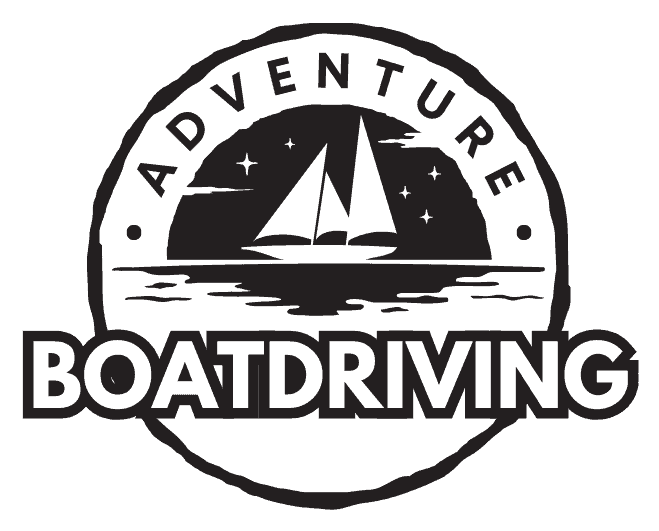
11 Types Of Boat Hulls – Boat Hull Shapes & Designs
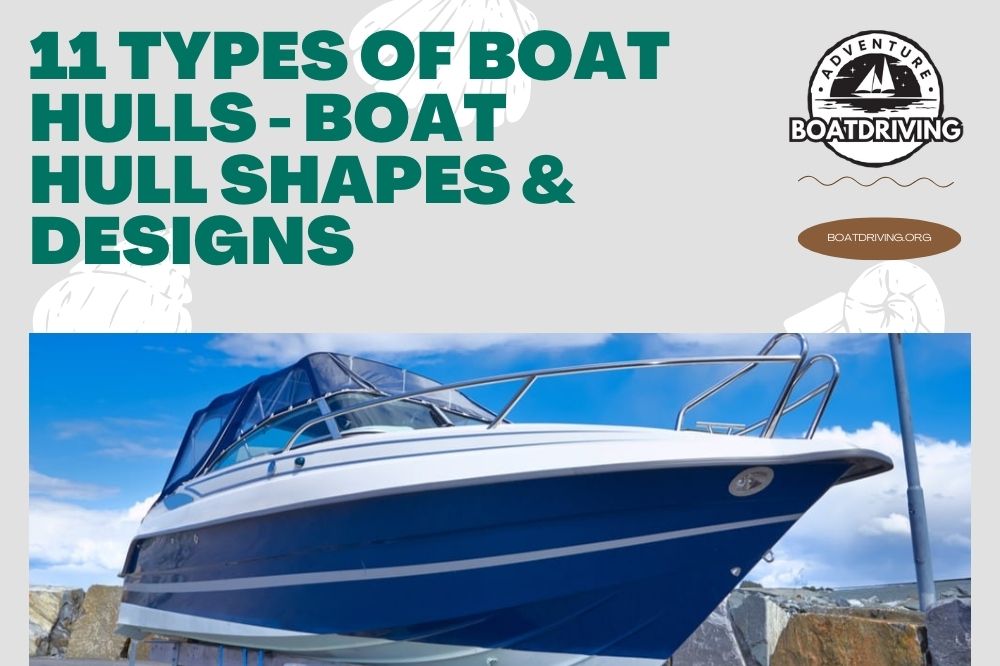
In many ways, the hull is the most important part of the boat because it’s what helps it float, pun intended. It’s the waterproof ‘base’ of the boat, with part of it submerged under the waterline. And these hulls come in lots of different styles and designs. Let’s check out a few.
Table of Contents
Overview of Boat Hull Types
A comprehensive list of boat hull types, bonus: jet ski hulls, quick clues about boat hull types.
First off, let’s look at the broad hull divisions . They can be categorized by:
- Form e.g. hard chine, soft chine, smooth chine
- Displacement e.g. full displacement, planing, semi
- Shape e.g. s-bottom, v-bottom, rounded, flat
These categories overlap a lot. For example, a v-bottom hull is sometimes described as a (hard) chined hull. And s-bottoms are sometimes labeled as rounded bilge hulls or smooth curve hulls. You can also classify hull types based on the number of hulls under the boat.
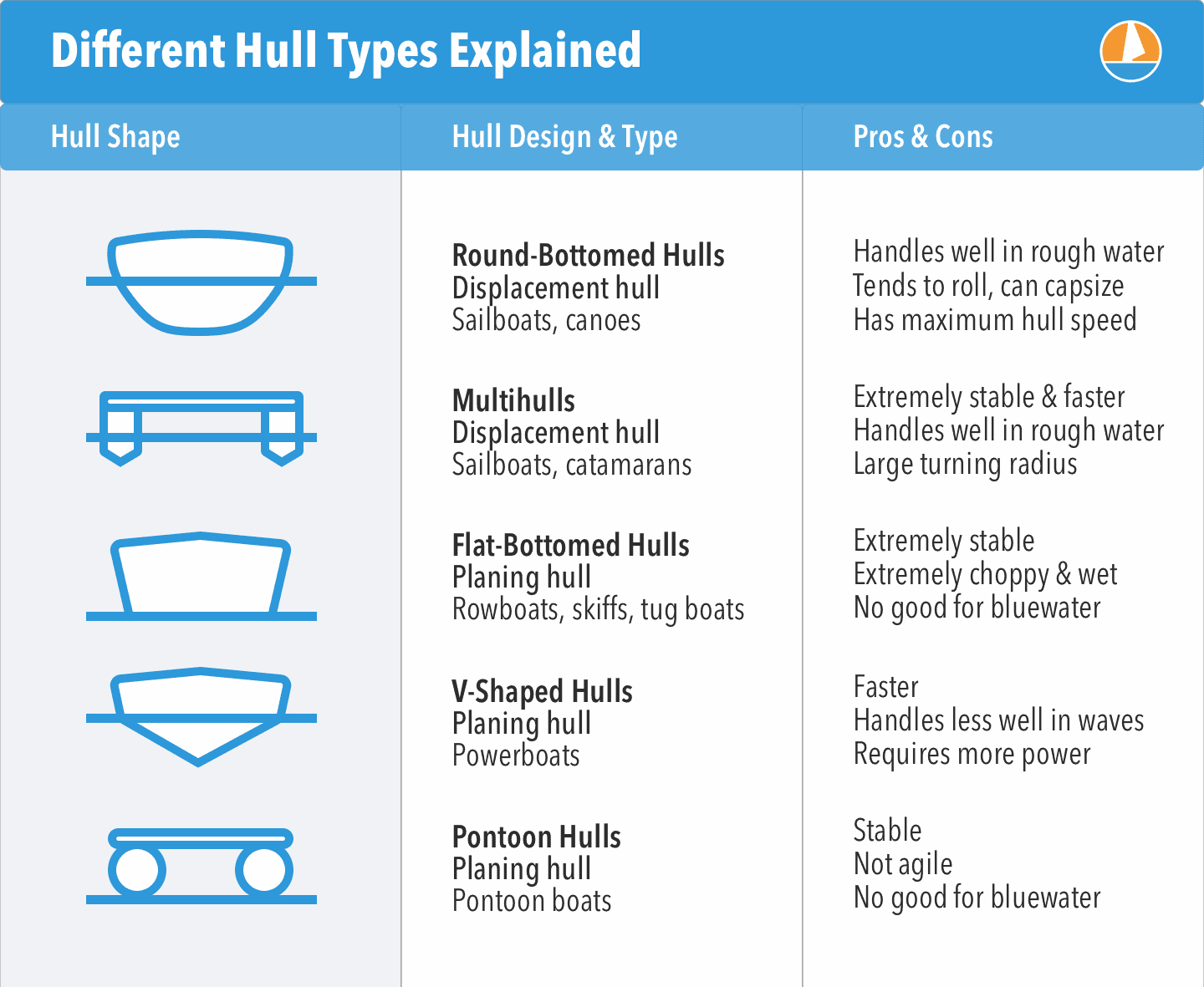
Just to make sure we’ve covered all the boat hull types, we’ve compiled them into a single list that cuts across the categories. This list will expand on any overlaps between the hull classes. Let’s start with the word chine, the angle at the bottom of the hull. It can be flat, curved, etc.
Hard chined hulls are sometimes called chined (without the word ‘hard’). And soft chined hulls are sometimes described as molded, curved, rounded, or smooth hulls. Finally, displacement hulls have a wider, heavier base designed to push water aside at lower speeds.
Conversely, planing hulls are streamlined to slice through the water at faster speeds. They ride high above the waves and seem to skim the water. Semi-planing / semi-displacement hulls fall in-between. Let’s look at the specific boat hull types, noting how they intermingle.
1. Flat-Bottom Hull (Chined)
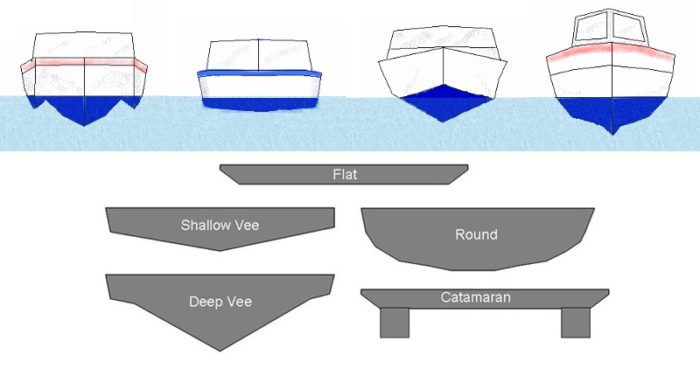
Just to refresh your memory, the chine described the angle at the outer bottom of the boat. This can be flat, slightly curved, fully rounded, or sharp and acute (e.g. a distinct v-shape, which is the harshest angle and is therefore called a hard chine. Flat-bottoms have no angle.
This means they’re sturdy and stable, sitting low and moving slow. That flat surface does drag the boat though, so flat-bottom hulls often have a pointed bow and stern to push the water more effectively. Or they may have an angular front and a reversed bell-shape back.
Flat-bottom hulls are categorized as displacement hulls. They work well on calm waters, so flat-bottom hulls are mostly used inland on large lakes and secure bays. They don’t do as well in wavy water. Small rowboats, rafts, kayaks, and paddle boats often have flat-bottom hulls.
2. V-Bottom Hull (Chined)
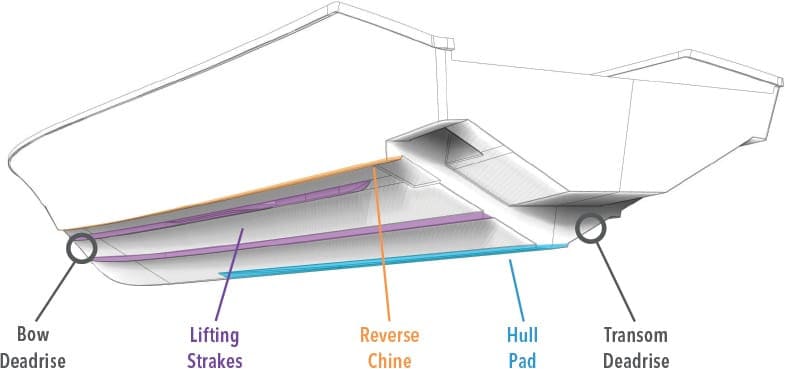
While flat-bottom boats are often displacers, v-bottom boats are better at planing. That triangular base is where the hard-chine name comes from because it’s a sharp or ‘hard’ angle of 6° to 23°. This hard chine is good at cutting through currents and riding over the waves.
V-bottom hulls are routinely combined with a powerful motor , which makes it even easier to zip above the waves. While sailing, the nose of the boat stays visible above the waterline. These boats aren’t as stable at slow speeds because the rolling waves can topple the boat.
Think of it this way – the V provides a wider surface for strong waves to push against, so the boat has to be fast and powerful enough to counter that roiling motion. A V-bottom hull can have a single V or several smaller ones strategically arranged for maximized boat balance.
3. Multi-Chine Hull (Hard)
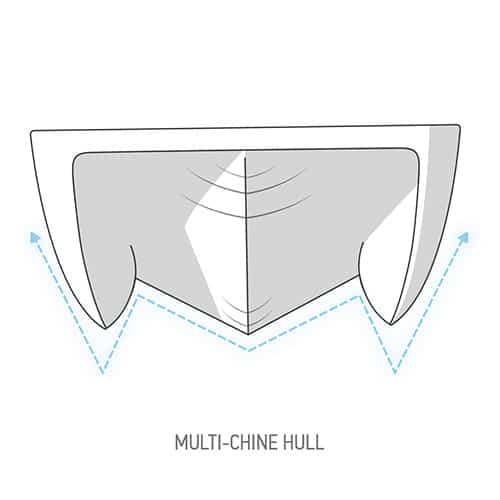
Multi-chined hulls can have twin or triplet chines. These chines can be parallel, identical, or have mixed sizes, and are ideal for speed sailing. The acute angles beneath the waterline help the boat soar over the water, while the multiple chines counter the effect of rolling waves.
But because there’s more than one hull, multi-chines are classed as displacement hulls. The hard chines push water into the valleys and ridges formed by the frames. Multi-chine hulls can be cathedral hulls or tunnel hulls, meaning the hull creates an M-shape under the water.
Multi-chine hulls will sometimes have a separate engine for each chine, so they can move quite fast. The platforms between the chines keep the boat stable while the alignment of the chines helps them battle the conflicting directions of circular waves and clashing currents.
4. Round Bilge Hull (Moulded)
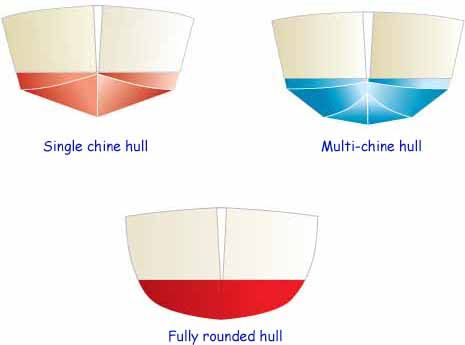
This is the most popular boat hull type because it combines the stability of a flat hull with the maneuverability of a curved one. The rounded bottom of the boat lets it handle waves more effectively than a flat hull. The soft-chine lets the boat glide and bob over larger, faster waves.
The reason molded hulls are so common is their middle-ground status. The curved bottom offers more speed and less drag than flat-bottom hulls. But because rounded bilge hulls are broader than v-bottoms, these boats can handle rougher, deeper waters than flat-bottoms.
Cargo boats, cruise ships, and ferries tend to have rounded hulls, especially if they sail deep waters. They can gain speed but are intended for slow gliding. But they tend to be large so you need plenty of room to turn, and extra care when you’re loading the boat at the docks .
5. Semi-Round Hull (Moulded)
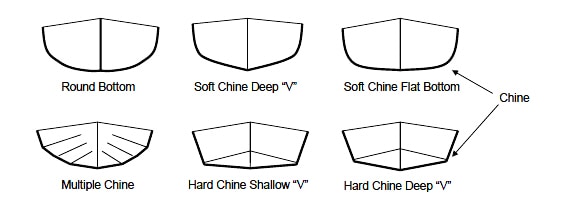
Semi-round bilge hulls are halfway between round hulls and S-hulls. They have a slightly gentler curve than S-bottoms, and they have a pointed keel down their middle. Small boats like dinghies and laser boats often have a semi-round hull, combining stability and speed.
Dinghies are generally used as non-inflatable lifeboats while lasers are for competitive solo sailing. They’re functional boats that can withstand deep, rough waters but are only intended for targeted spurts – like escaping a sinking ship or sprint sailing. They’re not distance boats.
You can also use semi-round hulls for buoy-sailing, where you race around designated ‘landmarks’ in the water. Semi-bilge boats do well here because they can work with flapping sails, go deeper with less drag, and retain stability during sharp turns and tricky maneuvers.
6. S-Bottom Hull (Moulded)

Sometimes called the arc-bottom hull, these boats have a smooth, curved bottom that meets at a pointed keel. The ‘s’ is the bulbous curve that forms from the waterline to the apex, and every boat has two. Think of it like a stereotypical temple dome roof that hangs upside-down.
This arch makes the boat an ideal hybrid. Its bulbous curves offer additional storage space and stability, while the pointy bit is great for planning since it lifts the boat as it slices through the waves. The curves also help to counter the push of rocking waves and currents.
Curiously, DIY boats routinely have that S-shape. These include the kinds of fishing boats that indigenous communities use. The arch creates space for your fishing haul while allowing you to sail swift rivers and deep lakes. Unfortunately, that arched keel is prone to capsizing.
7. Displacement Hull (Low-Speed)
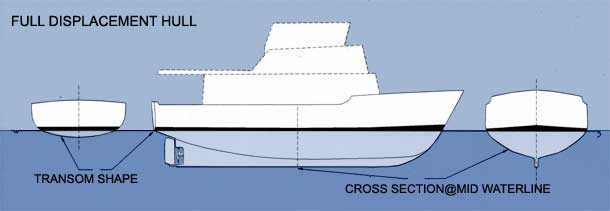
Any boat that moves by pushing water out of the way is defined as a displacement boat. They mostly have flat or round hulls , but they can also have a multi-chine design if the hull has grooves between the chines. This crucial difference distinguishes how the boat operates.
Think of it this way – a V-bottom boat, even one with several chines, needs flatter sections to join the separate hulls. If the platforms are 180, they glide above the waterline with stronger drag. But if those underwater sections are angular, the boat displaces the water down there.
And yes, displacement boats can still zoom along. But when they do, the flatter sections slam onto the water as every wave dips. That makes for a rather uncomfortable ride, which is why displacement hulls are best for boats that intend to carry heavy cargo across calm, slow seas.
8. Planing Hull (High-Speed)
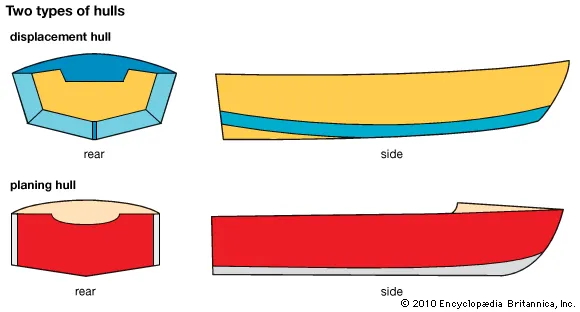
The opposite boat hull type is the planing hull, built for speed. You know that typical sailing shot where a suave spy seems to be bouncing on the waves in a pointed boat that’s apparently flying through the sea? That’s a planing boat, and the emphasis is on the boat’s lift or plane.
This means the hull is designed to carry more weight at the back, allowing the front to rise out of the water at high speeds . These boats are often equipped with high-powered motors , and if you drive too slowly, the angular hull will have a hard time idling in the water.
In such cases, the boat is likely to pitch. Here’s a shortcut you could use to remember the different boat hull types. Flat, rounded, and multi-hull boats are displacers. Arched, v-hull, and angular boats are planing boats. These features are combined for inflated hollow hulls.
9. Semi-Planing / Semi-Displacement Hull
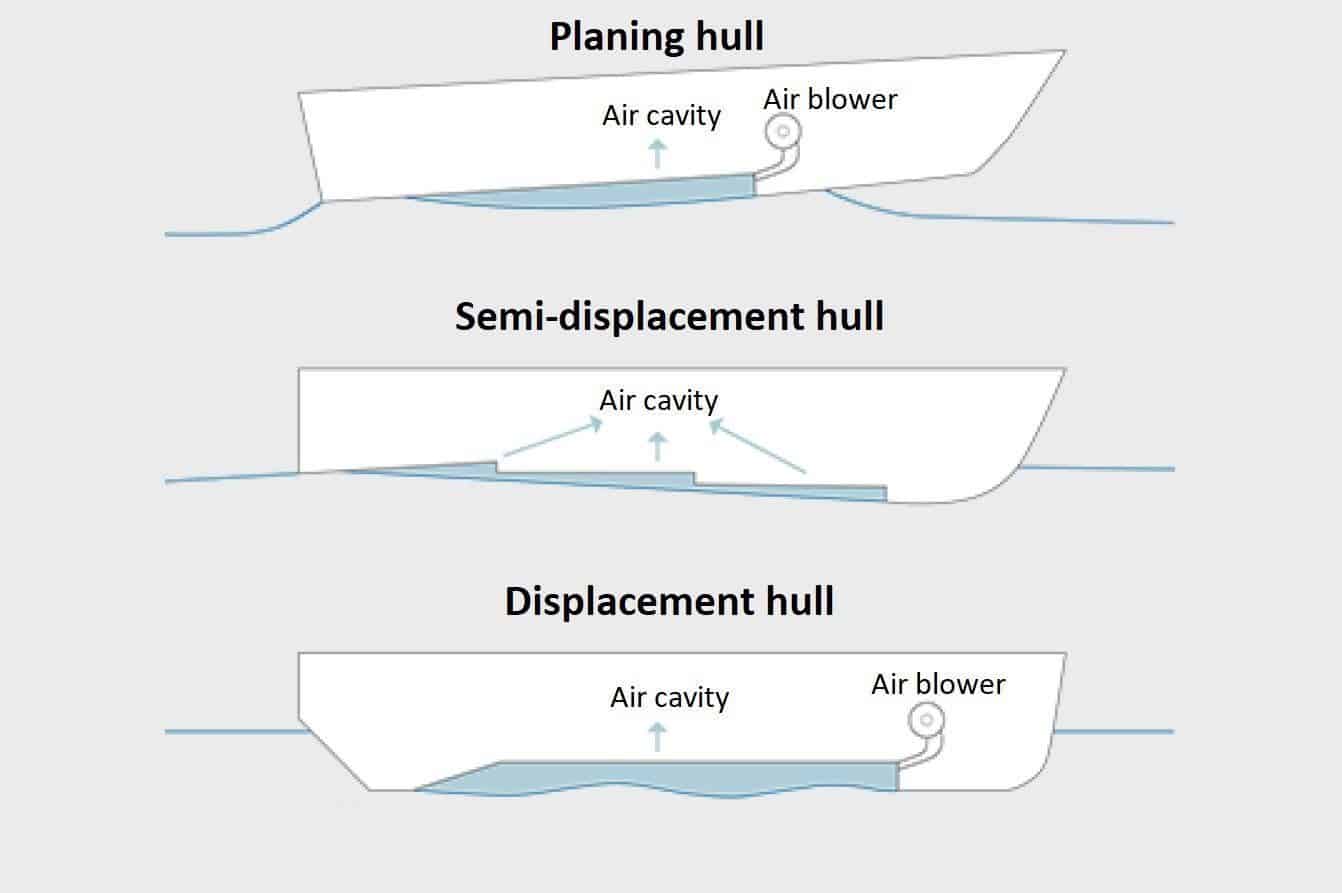
Cruise ships and luxury yachts are the best examples of semi-planing or semi-displacement boats. The design range is quite diverse, so the specs will depend on your particular needs. But the idea is that the hull has a composite surface to facilitate the various sailing features.
For example, you need speed between destinations, and maneuverability as you dock at every port. Massive storage space is essential for the passengers, their gear, and their … by-products. You also want a boat that stays stable as it faces deep-sea currents and creatures.
The draft (that’s the section of the hull that stays submerged) has straight bits, angular bits, and curved bits to allow for all this. Ocean trawlers and container ships can also have a semi-planing hull. These semi boats have Vs and wedges at the front and get rounder at the stern .
10. Pontoon Hull (Hollow)
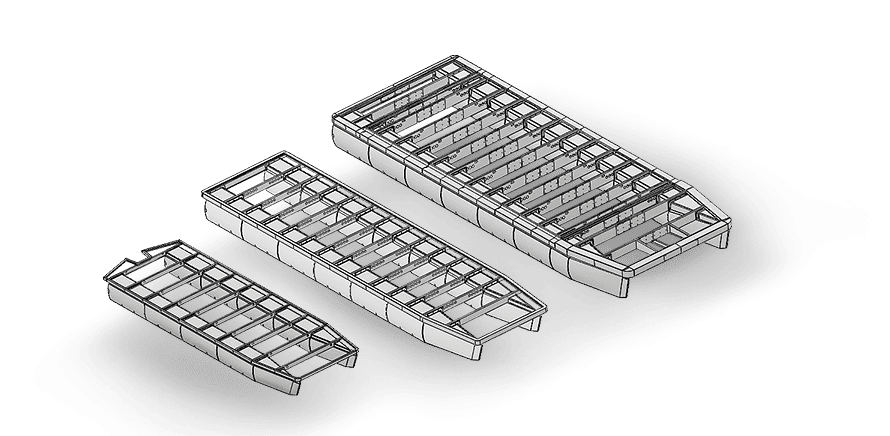
What happens when you want a ‘flat’ boat with a larger capacity? Well, aluminum fishing boats are flat-bottomed but tiny. So if you want to carry a larger crew (or even passengers in transit), opt for a pontoon hull. Its hull floats through the use of hollow cylindrical tubes.
These tubes are often made from aluminum, and your pontoon can have two or more tubes below its deck. The focus is on cargo space and balance. Passenger platoons have lots of padded seating space, and guests are carefully spread out to maintain the boat’s equilibrium.
Pontoon hulls are sometimes fitted on trawlers as well. Think of it as an industry-strength inflatable lifeboat, but with a solid, seaworthy frame. The seating area is centralized with raised sides and strategic guardrails. This helps the boat sit lower and safer inside the water.
11. Catamaran Hull (Multi-Chined)
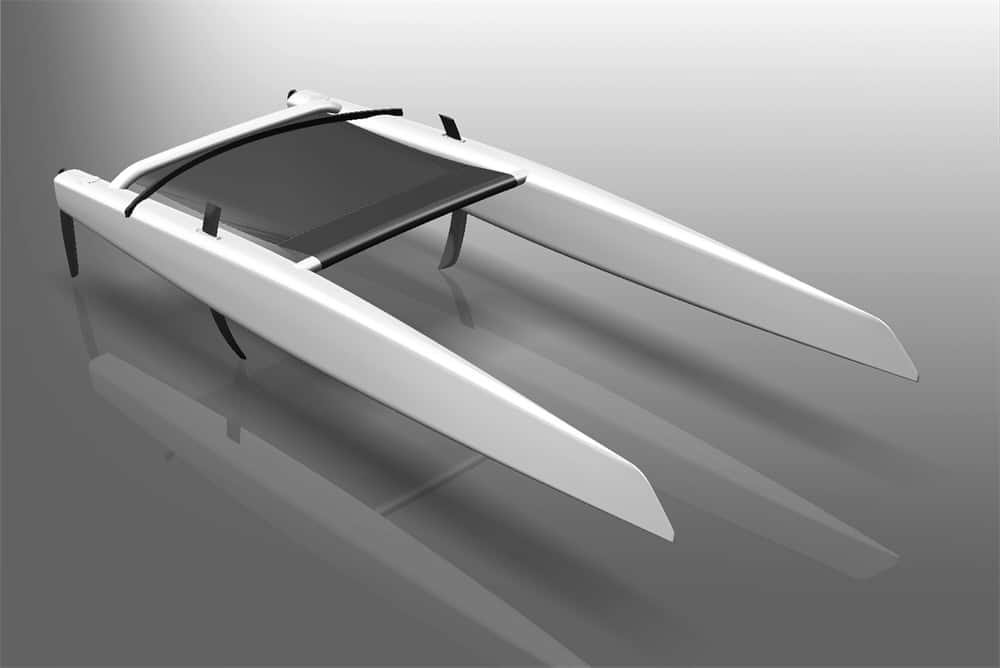
While pontoons are built for slow freight, catamarans are built for speed. Both these boats have multi-chined hulls. But while the tubes on pontoons have a rounded bottom, the hard chines on catamarans are V-shaped and sometimes have sharper anglers for swifter sailing.
These boats have a massive footprint. But because of the shape and alignment of the hull, they don’t have as much storage space as pontoons. They also have to be carefully designed to ensure stability. This is why catamarans have large masts and sails to balance the boat.
The apparatus also helps you control the boat. Catamarans are preferred by seafarers who prize seamanship. Playing with those swirling ropes and heavy fabrics is both a science and an art, so catamarans are primarily used for competitive analog sailing on rough oceans.
Technically, jet skis or personal watercraft (PWCs) aren’t boats. But they use the same principles and are fitted with a V-bottom planing hull and a pressure jet engine. These jet ski hulls have extra parts to facilitate speed and stability as you ride the waves. They include:
- Chines – these angles can be soft or hard, but they’re always V-shaped.
- Strakes – smaller ridges that enhance the lift for smoother planing.
- Sponsons – side fins that help the jet ski balance better.
- Steps – ledges at the bottom of the hull to reduce drag.
PWCs rely on your balance and confidence. Their hulls are designed for maximum lift, sensational planing, dramatic turns, and extreme speed. The hull angle is sharper at the front than the back. It’s described as a modified V-hull, with all its extra edges and ledges.
With all these boat hull types available, it’s easy to get them mixed up! Here are some hints:
- Displacement hulls sit lower and move slower.
- Planing hulls sail faster and float higher.
- Flat, round, and S-hulls can be manual.
- V-bottoms and multi-chine hulls need engines.
- Sharper hulls use sails for extra control and balance.
- Hybrid hulls have a narrow front and a wide back.
- Pontoons emphasize buoyancy and floating power.
- Hard chines have acute angles while regular chines slop gently.
What type of hull do you have on your latest boat? Show us some photos in the comments!
Related posts:
- Do You Wear Socks With Boat Shoes?
- Wake Boat Vs. Ski Boat: What’s the Difference?
- 6 Simple Steps to Tie A Boat To a Dock Cleat
- Hydraulic Vs. Mechanical Boat Steering: Which Is Better?
Similar Posts

How To Choose A Pedal Boat?
I could not imagine my childhood without a pedal boat in it-in fact, some of my fondest memories include steering the pedal boat across some vast expanse of water. Of course, while I was steering, my mother and father tirelessly pedaled along, fighting the currents to get back to the rental spot before being charged…

6 Tips to Choose the Correct Boat Propeller
Do you want to improve your boat’s performance? Does it feel like your vessel isn’t achieving the ultimate speed possible? Are you concerned about the fuel economy or need to switch to a propeller made from a different material? Choosing the correct boat propeller is one of the best and easiest ways to get the…

10 Tips to Choose the Right Generator for Your Boat
Once you’ve bought a boat, a marine generator for your boat might possibly be your next big investment. Consequently, it would be best if you put enough thought and consideration before you make such a big decision. While it would be best for you to consult with marine generator experts and dealers to find the…

Freedom Boat Club Cost (Price Chart)
Freedom boat club cost is among the highest in the US, but there are a few understandable reasons for that. It is the oldest club and the most widespread marine franchisor in the country. With over 2,000 boats available in the USA, Canada, and Europe, this reputable club provides the best possible service you can…

Deck Boat vs. Pontoon: What’s the Difference?
As you keep looking for a small boat, which one between a pontoon and a deck do you think will suit your needs? Which differences will make you choose between the two? Well, you are about to find out. Here, we’ll cover the deck boat vs. pontoon. These two boats are excellent. You might want…

7 Best Boat Flooring Options – Marine Flooring Replacement Materials
Do you want a beautiful boat floor material, one that will last for a long time, or one that has both specs? Yes, there are many boats flooring types, but how can you pick the best? Well, we’ll help you make the right choice. Here, we are going to cover seven boat flooring options. Your…
Leave a Reply Cancel reply
Your email address will not be published. Required fields are marked *
Save my name, email, and website in this browser for the next time I comment.
Did You Know That We Offer Contract to Closing Services? Click Here to Find Out More.
Need Marine Financing? Apply Here With Our Partner, First Approval Source
- Catamaran Interviews
- Catamaran Reviews
- Buying Advice
- Selling Advice
- Woods Design Advice
- Admiral 38
- Admiral 40
- Admiral 50
- Americat 3014
- Antares 44
- Aquila 44
- Aquila 48 Power Catamaran
- Aventura 37
- Balance 442
- Balance 482
- Balance 526
- Bali 4.0
- Bali 4.1
- Bali 4.2
- Bali 4.3
- Bali 4.4
- Bali 4.5
- Bali 4.6
- Bali 4.8
- Bali 40 Catspace
- Bali 5.4
- Bali Catsmart
- Beneteau Blue II
- Broadblue 346
- Broadblue 38 Prestige
- Broadblue 385
- Broadblue 435
- Broadblue 46
- Rapier 400
- Rapier 550
- Catalac 10M
- Catalac 11M
- Catalac 12M
- Catalac 8M
- Catalac 900
- Catalac 9M
- Catana 381
- Catana 39
- Catana 401
- Catana 40S
- Catana 411
- Catana 42
- Catana 42 S
- Catana 431
- Catana 44
- Catana 471
- Catana 50
- Catana 521
- Catana 531
- Catana 55
- Catana 581
- Catana 65
- Catathai 44
- Chris White
- Chris White 48 Voyager
- Chris White 55
- Condor 40
- Contour 34
- Corsair F28 R
- De Villiers
- Dean 365
- Dean 400
- Dean 440
- Dean 500
- Dix DH550
- Dolphin 380
- Dolphin 460
- Edel 35
- Endeavour 30
- Endeavour 35 Victory
- Endeavour 36
- Endeavour 44
- Endeavour 44 TrawlerCat
- Endeavour 50 Pilothouse Trawler
- Excess 11
- Excess 15
- F-41
- Fastback 43
- Fastcat 445
- Fisher 28
- Fisher 32
- Fortuna 36 Island Spirit
- Fortuna 401 Island Spirit
- Fountaine Pajot
- FP 32 Maldives
- FP 35 Tobago
- FP 36 Mahe
- FP 37 Antigua
- FP 38 Athena
- FP 39 Fidji
- FP 40 Isla
- FP 40 Lavezzi
- FP 40 Lucia
- FP 40 MY
- FP 40 Summerland MY
- FP 41 Lipari
- FP 42 Astrea
- FP 42 Venezia
- FP 43 Belize
- FP 44 Helia
- FP 44 Orana
- FP 45 Elba
- FP 46 Bahia
- FP 46 Casamance
- FP 48 Salina
- FP 50 Saba
- FP 56 Marquises
- FP 57 Sanya
- FP 58 Ipanema
- FP 60 Eleuthera
- FP Saona 47
- Fusion 40
- Gemini 105
- Gemini 3000
- Gemini 3200
- Gemini 3400
- Gemini Freestyle 37
- Gemini Freestyle 399 Power
- Gemini Legacy 35
- Grainger 420 Mystery Cove
- Gunboat 55
- Hirondelle 7M
- HopYacht 30
- Island Packet
- Island Packet Cat 35
- Kennex 420
- Knysna 440
- Knysna 480
- Knysna 500
- Knysna 550
- Lagoon 35
- Lagoon 37 TPI
- Lagoon 380
- Lagoon 39
- Lagoon 40
- Lagoon 400
- Lagoon 410
- Lagoon 42
- Lagoon 42 TPI
- Lagoon 420
- Lagoon 421
- Lagoon 43 PC
- Lagoon 44 Power Cat
- Lagoon 440
- Lagoon 450
- Lagoon 46
- Lagoon 470
- Lagoon 50
- Lagoon 500
- Lagoon 52F
- Lagoon 55
- Lagoon 560
- Lagoon 570
- Lagoon 620
- Lagoon Seventy 8
- Lagoon Sixty 7
- Leeuwin 42
- Leopard 38
- Leopard 39
- Leopard 39 PowerCat
- Leopard 40
- Leopard 42
- Leopard 43
- Leopard 44
- Leopard 45
- Leopard 45 Classic
- Leopard 46
- Leopard 46 Lion PowerCat
- Leopard 47
- Leopard 47 PowerCat
- Leopard 48
- Leopard 50
- Leopard 51 PowerCat
- Leopard 53 PowerCat
- Leopard 58
- Lidgard 73 Executive
- Looping 50
- Maine Cat 30
- Maine Cat 38
- Maine Cat 41
- Manta 40
- Manta 42
- Matrix 450 Vision
- Matrix 760 Silhouette
- Maverick 400
- Maverick 420
- Maverick 440
- Moxie 61
- Nautitech 40
- Nautitech 40 Open
- Nautitech 44 Open
- Nautitech 442
- Nautitech 46 Open
- Nautitech 47
- Nautitech 47 Power
- Nautitech 475
- Nautitech 65
- Neel 45
- Neel 47
- Outremer 40
- Outremer 45
- Outremer 50 Standard
- Outremer 55
- Outremer 5X
- PDQ 32
- PDQ 36
- PDQ 42 Antares
- Privilege 37
- Privilege 39
- Privilege 42
- Privilege 43
- Privilege 435
- Privilege 45
- Privilege 465
- Privilege 48 Transcat
- Privilege 482
- Privilege 495
- Privilege 510
- Privilege 65
- Privilege Serie 5
- Prout 31 Quest
- Prout 33 Quest
- Prout 34 Event
- Prout 35 Snowgoose
- Prout 37 Snowgoose
- Prout 37 Snowgoose Elite
- Prout 38
- Prout 38 Manta
- Prout 39 Escale
- Prout 45
- Prout 46
- Royal Cape 45
- Royal Cape 500 Majestic
- Royal Cape 530 Majestic
- Sailcraft 30 Iroquois
- Sailcraft 32 Comanche
- Sailcraft 35 Cherokee
- Sailcraft 41 Apache
- Sailcraft 44 Apache
- Scape 39
- Wildcat 350
- Seacart 30
- Seawind 1000
- Seawind 1160
- Seawind 1190
- Seawind 1200
- Seawind 1260
- Seawind 1600
- Simpson 48
- Solaris 36 Sunrise
- Solaris 36 Sunstar
- Solaris 42
- St Francis 44
- St Francis 48
- St Francis 50
- Stealth 11.8
- Sunreef 60
- Sunreef 62
- Sunreef 70
- Sunreef 74C
- Sunreef 82 DD
- Sunreef 88 DD
- Switch 51
- Switch 55
- TRT 1200
- Heavenly Twins 26
- Ocean Twins 38
- Vaan R5
- Vision 444
- Voyage 380 Maxim
- Voyage 400 Norseman
- Voyage 430 Norseman
- Voyage 440
- Voyage 450 Cabriolet
- Voyage 47 Mayotte
- Voyage 480
- Voyage 500
- Voyage 580
- Voyage 590
- Kronos 45
- Wharram 38 Tiki
- AMI 320 Renaissance
- Woods 22 Wizard
- Woods 35 Banshee
- Woods 35 Flica
- Woods 36 Scylla
- Woods 36 Vardo
- Woods 38 Transit
- Woods 40 Meander
- Xquisite X5
- Xquisite X5+
Catamaran Hull Design
- Post author By Rick
- Post date June 29, 2010
- 2 Comments on Catamaran Hull Design

Part 1: Notes from Richard Woods
Since the America’s Cup experimented with going multihull, there’s been a lot of interest in catamaran performance and the catamaran hull designs that define performance. Many guys are investigating whether to buy a catamaran or design and build their dream boat. Let it be said here that building a large catamaran is not for the faint of heart. People begin building 100s of boats a year, yet few are ever completed, as life always seems to have a way of interfering with a good boat build.
Never the less, since the rest of this website is about selecting and buying a boat , it only seems fair to have at least one webpage that covers catamaran design. This page contains notes on boat hull design goals and an accompanying page from Terho Halme has mathematical formulas used in actual catamaran hull design. It has become a popular research stop and an important reference to the catamaran design community.
The content of this page was reproduced from the maestro of Catamaran designs, renown British naval architect, Richard Woods, who not only designs catamarans, he sails them across oceans…. repeatedly. He has a lot to say on the subject of catamaran hull design.
“…When it’ all said and done, the performance of a sailing catamaran is dependent on three primary specs: length, sail area and weight. If the boat is longer it generally means it’ a faster boat. If she has more sail area, it means she’ a faster boat and if she’ light it means she’ a faster boat. Of course, there are limits: Too much sail area capsizes the boat in brisk winds. If the boat is designed too light, she will not take any kind of punishment. Too slim a hull design and the boat becomes a large Hobie Cat capable of only carrying your lunch. Of course, too long and large and you’d have to be Bill Gates to afford one. Then there are lot of additional and very important factors like underwater hull shape, aspect ratios of boards and sails, wet deck clearance, rotating or fixed rigging and so on….” Richard Woods
All Catamarans are not equal, but all sailboats have two things in common: They travel on water and they’re wind powered, so the Catamaran design equations in the 2nd part should apply to every catamaran from a heavy cruising Cat to a true ocean racer.
Richard Wood’s comments on catamaran design:
We all know that multihulls can be made faster by making them longer or lighter or by adding more sail. Those factors are the most important and why they are used as the basis of most rating rules. However using just those figures is a bit like determining a cars performance just by its hp and curbside weight. It would also imply that a Tornado would sail as fast forwards as backwards (OK, I know I just wrote that a Catalac went faster backwards than forwards)
So what next?? Weight and length can be combined into the Slenderness Ratio (SLR). But since most multihulls have similar Depth/WL beam ratios you can pretty much say the SLR equates to the LWL/BWL ratio. Typically this will be 8-10:1 for a slow cruising catamaran (or the main hull of most trimarans), 12-14:1 for a performance cruiser and 20:1 for an extreme racer.
So by and large faster boats have finer hulls. But the wetted surface area (WSA) increases proportionately as fineness increases (for a given displacement the half orange shape gives the least WSA) so fine hulls tend to be slower in low wind speeds.
The most important catamaran design hull shape factor, is the Prismatic Coefficient (Cp). This is a measure of the fullness of the ends of the hull. Instinctively you might think that fine ends would be faster as they would “cut through the water better”. But in fact you want a high Cp for high speeds. However everything is interrelated. If you have fine hulls you can use a lower Cp. Most monohulls have a Cp of 0.55- 0.57. And that is about right for displacement speeds.
However the key to Catamaran design is you need a higher Cp if you want to sail fast. So a multihull should be at least 0.61 and a heavy displacement multihull a bit higher still. It is difficult to get much over 0.67 without a very distorted hull shape or one with excessive WSA. So all multihulls should have a Cp between 0.61 and 0.65. None of this is very special or new. It has been well known by naval architects for at least 50 years.
There are various ways of achieving a high Cp. You could fit bulb bows (as Lock Crowther did). Note this bow is a bit different from those seen on ships (which work at very specific hull speeds – which are very low for their LOA). But one problem with them is that these tend to slam in a seaway.
Another way is to have a very wide planing aft section. But that can increase WSA and leads to other problems I’ll mention in a minute. Finally you can flatten out the hull rocker (the keel shape seen from the side) and add a bustle aft. That is the approach I use, in part because that adds displacement aft, just where it is most needed.
I agree that a high Cp increases drag at low speeds. But at speeds over hull speed drag decreases dramatically on a high Cp boat relative to one with a low Cp. With the correct Cp drag can be reduced by over 10%. In other words you will go 10% faster (and that is a lot!) in the same wind and with the same sails as a boat with a unfavorable Cp. In light winds it is easy to overcome the extra drag because you have lots of stability and so can fly extra light weather sails.
The time you really need a high Cp boat is when beating to windward in a big sea. Then you don’t have the stability and really want to get to your destination fast. At least I do, I don’t mind slowly drifting along in a calm. But I hate “windward bashing”
But when you sail to windward the boat pitches. The sea isn’t like a test tank or a computer program. And here I agree with Evan. Immersed transoms will slow you down (that is why I use a narrower transom than most designers).
I also agree with Evan (and why not, he knows more about Volvo 60 design than nearly anyone else on the planet) in that I don’t think you should compare a catamaran hull to a monohull, even a racing one. Why chose a Volvo 60/Vendee boat with an immersed transom? Why not chose a 60ft Americas Cup boat with a narrow out of the water transom??
To be honest I haven’t use Michelet so cannot really comment. But I have tested model catamarans in a big test tank and I know how inaccurate tank test results can be. I cannot believe that a computer program will be better.
It would be easy to prove one way or the other though. A catamaran hull is much like a frigate hull (similar SLR, L/B ratios and Froude numbers) and there is plenty of data available for those. There is also a lot of data for the round bilge narrow non planing motorboats popular in the 1930’-50’s which again are similar to a single multihull hull.
One of the key findings I discovered with my tank test work was just how great the drag was due to wave interference between the hulls. Even a catamaran with a modern wide hull spacing had a drag increase of up to 20 % when compared to hulls at infinite spacing. One reason why just flying a hull is fast (the Cp increases when you do as well, which also helps). So you cannot just double the drag of a single hull and expect to get accurate results. And any speed prediction formula must include a windage factor if it is to give meaningful results.About 25 years ago we sailed two identical 24ft Striders next to each other. They were the same speed. Then we moved the crew of one boat to the bow. That boat IMMEDIATELY went ½ knot faster. That is why I now arrange the deck layout of my racing boats so that the crew can stay in front of the mast at all times, even when tacking or using the spinnaker.
I once raced against a bridge deck cabin catamaran whose skipper kept the 5 crew on the forward netting beam the whole race. He won.
Richard Woods of Woods Designs www.sailingcatamarans.com
- Tags Buying Advice , Catamaran Designers

Owner of a Catalac 8M and Catamaransite webmaster.
2 replies on “Catamaran Hull Design”
I totally agree with what you say. But Uli only talk sailing catamarans.
If only solar power. You need the very best. As limited watts. Hp.
The closer to 1-20 the better.
Closing the hulls to fit in cheaper marina berth. ?
You say not too close. But is that for sailing only.
Any comment is greatly appreciated
Kind regards Jeppe
Superb article
Leave a Reply Cancel reply
Your email address will not be published. Required fields are marked *
Save my name, email, and website in this browser for the next time I comment.

IMAGES
VIDEO
COMMENTS
A truly flat-bottomed boat has zero degrees of deadrise. Most powerboat hulls have some deadrise, giving the hull bottom its "V" shape when viewed from the bow or stern. The deep-V hull was developed in the late 1950s and proved to be optimal for high-speed offshore vessels, with transom deadrise of 18 to 24 degrees.
A shape that generates lift also produces resistance, and a wider hull that has more interior room also has more hull surface in contact with the water, and therefore experiences more resistance. However, hull design isn't just about speed and interior volume. There's also stability and tenderness, which is a boat's tendency to rock.
5. Round-Bottom Hull. A round-bottom hull design is characterized by a curved and continuous surface along the bottom of the boat's hull. Unlike other hull shapes with flat or V-shaped bottoms, a round-bottom hull has a smooth and curved profile that extends from the bow to the stern of the boat.
A boat's weight—and its distribution fore and aft—is central to hull design of any kind. We design the underwater volume of a hull to be distributed in a way that matches the optimal fore and aft center of gravity of the assembled boat plus her occupants and gear. This "center of buoyancy" is the volumetric center of the shape of the ...
Tri-Hull. The tri-hull design is a variation of the v bottom hull. It has a v-shaped hull in the center and two parallel smaller hulls on either side of the main central one. This gives the tri-hull boat some extra stability when going forward. Additionally, this also allows the boat to have more deck space as the hull covers a wider range.
Planing yacht hull design. Fn: 1.1 and above, preferably from 2 and up. Average power requirement: 60hp/ton plus. Prismatic coefficient: 0.68 0.76. LCB: 0.58 0.64. Typically monohedral prismatic aft shape constant deadrise. Light displacement. Engine room forms a significant part of hull volume (up to 30-40 per cent)
A hull typically amounts to around 70% of a yacht's total structural design, making hull design a complex part of a yacht's overall design. Thanks to advances in hull designs, modern yachts now boast enhanced seakeeping and energy efficiencies.
Modified-V. Sometimes called a warped plane, this is the most common hull for small boats, because it combines some of the best characteristics of the other shapes. The flatter sections toward the stern add stability as well as increase the speed, just like a flat-bottom. The wedge-shaped forward hull cushions the ride like a deep-V, and also ...
Ultimately, the job of a sailboat hull is to keep the boat afloat and create stability. These are the fundamentals of a seaworthy vessel. There are two types of stability that a design addresses. The first is the initial stability, which is how resistant to heeling the design is.
Hull Structure and Strength. The structural design of the hull of a ship amounts to approximately 70 percent of the total structural design of the ship. The stages in designing the hull structure are as follows: Step 1: Calculation of Loads on the Hull: This is where the classification society rules come into play.
Generally, multihulls and deep-V hulls are considered the most stable hull designs in most situations. In practice, the most stable hull design depends on the specific conditions in which the boat will be used. With large waves, deep hulls tend to be better than multihulls. With different situations, the most stable hull winner changes.
There are five common boat hull types: Round-bottomed hulls - handle well in rough water: sailboats. Flat-bottomed hulls - very stable for calm inland waters: fishing boats. Multihulls - very stable and buoyant: catamarans. V-Shaped Hulls - fast and comfortable in chop: powerboats.
The hull curves of yachts can vary depending on the design and purpose of the yacht. While some yacht hulls may follow a curve that resembles the function of x squared, others may follow different curves such as parabolic curves, ellipses, catenary curves, or other mathematical shapes.
Hull Design: Planing Hull Efficiency. October 22, 2020. The overwhelming popularity of the planing hull is a direct result of its pure speed potential. View Full Article. In Boat Evaluation Tags Hull Design. ← Hull Design: Your boat's bottom... and yours Hull Design: "Slab Sided" Hulls →. SORENSEN's GUIDE TO POWERBOATS. Eric Sorensen ...
A shape that generates lift also produces resistance, and a wider hull that has more interior room also has more hull surface in contact with the water, and therefore experiences more resistance. However, hull design isn't just about speed and interior volume. There's also stability and tenderness, which is a boat's tendency to rock.
Small rowboats, rafts, kayaks, and paddle boats often have flat-bottom hulls. 2. V-Bottom Hull (Chined) While flat-bottom boats are often displacers, v-bottom boats are better at planing. That triangular base is where the hard-chine name comes from because it's a sharp or 'hard' angle of 6° to 23°.
If you have fine hulls you can use a lower Cp. Most monohulls have a Cp of 0.55- 0.57. And that is about right for displacement speeds. However the key to Catamaran design is you need a higher Cp if you want to sail fast. So a multihull should be at least 0.61 and a heavy displacement multihull a bit higher still.
Boat Portlights. The boat hull is the section that sits in the water. The type and design of the hull determines the type of ride in the water, which can be either choppy or smooth. Learn about the types of boat hulls.
Yessentuki (Russian: Ессентуки́, IPA: [jɪsɪntʊˈkʲiˑ]) is a city in Stavropol Krai, Russia, located in the shadow of Mount Elbrus at the base of the Caucasus Mountains.The city serves as a railway station in the Mineralnye Vody—Kislovodsk branch, and is located 43 kilometers (27 mi) southwest of Mineralnye Vody and 17 kilometers (11 mi) west of Pyatigorsk.
5. Map of administrative divisions of Stavropol Krai. Cities and towns under the krai's jurisdiction : Stavropol (Ставрополь) (administrative center) city districts : Leninsky (Ленинский) Oktyabrsky (Октябрьский) Promyshlenny (Промышленный) Budyonnovsk (Будённовск)
Pyatigorsk (Russian: Пятиго́рск; Circassian: Псыхуабэ, Psıxwabæ) is a city in Stavropol Krai, Russia located on the Podkumok River, about 20 kilometers (12 mi) from the town of Mineralnye Vody, which has an international airport, and about 45 kilometers (28 mi) from Kislovodsk.Since January 19, 2010, it has been the administrative center of the North Caucasian Federal ...
The flag of Stavropol Krai of Russia is a Nordic Cross charged with the krai's coat of arms in its centre. The cross itself is white set on a golden background. In one version, the coat of arms is depicted entirely in gold, in correspondence to the flag's background. In another version, it is in its full array of colours.